Organometallic Compound And Organic Light-emitting Device Including The Same
KIM; Sungbum ; et al.
U.S. patent application number 16/542805 was filed with the patent office on 2020-06-25 for organometallic compound and organic light-emitting device including the same. The applicant listed for this patent is SAMSUNG DISPLAY CO., LTD.. Invention is credited to Eunsoo AHN, Junghoon HAN, Mina JEON, Sungbum KIM, Soobyung KO, Eunyoung LEE, Hyunjung LEE, Jaesung LEE, Sujin SHIN.
| Application Number | 20200203634 16/542805 |
| Document ID | / |
| Family ID | 71097870 |
| Filed Date | 2020-06-25 |

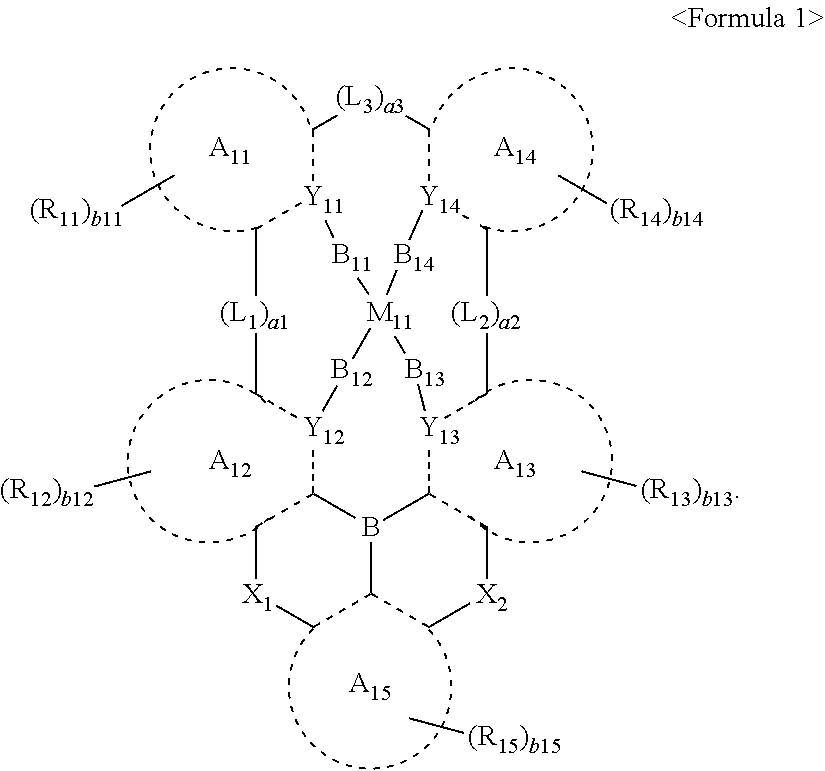
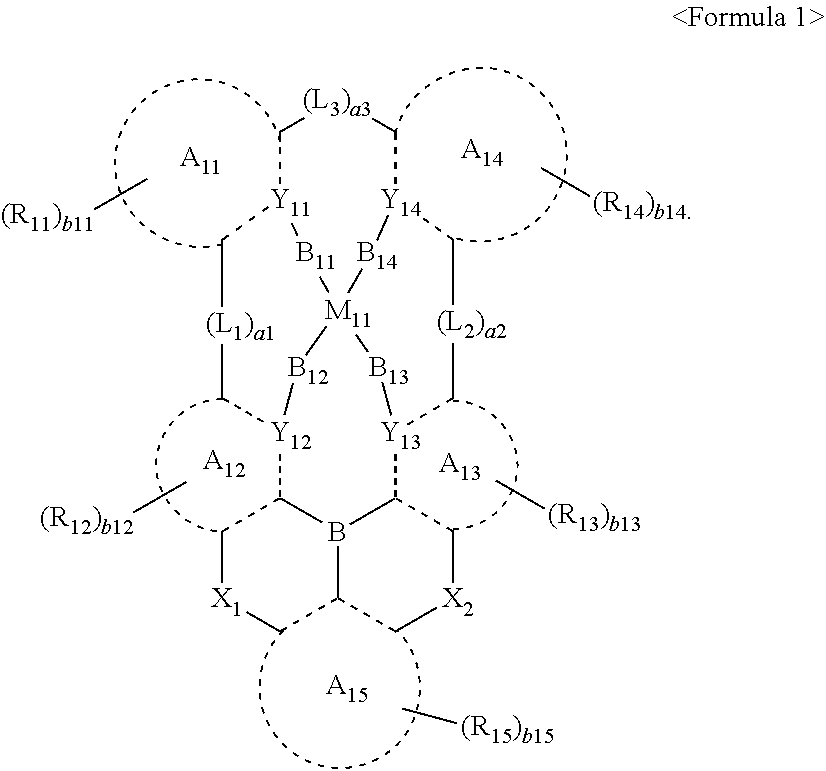





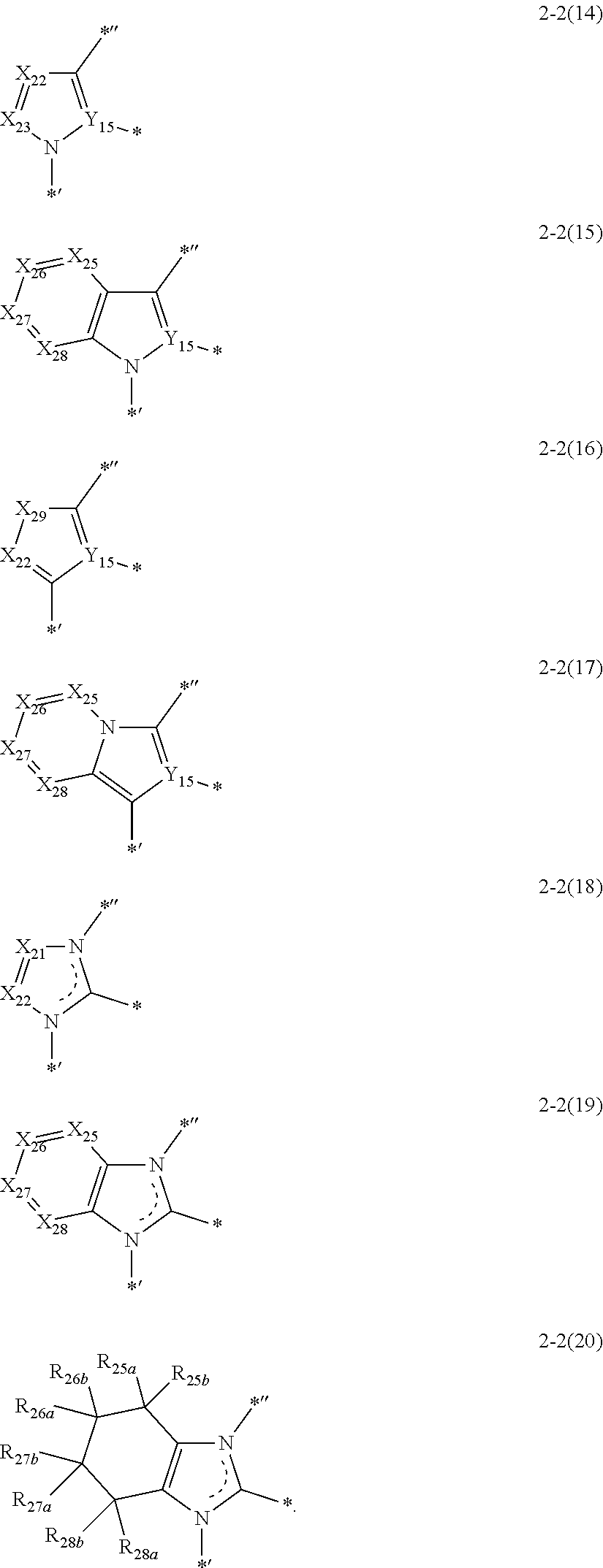



View All Diagrams
| United States Patent Application | 20200203634 |
| Kind Code | A1 |
| KIM; Sungbum ; et al. | June 25, 2020 |
ORGANOMETALLIC COMPOUND AND ORGANIC LIGHT-EMITTING DEVICE INCLUDING THE SAME
Abstract
An organic light-emitting device includes a first electrode, a second electrode facing the first electrode, an organic layer between the first electrode and the second electrode and including an emission layer, and at least one organometallic compound represented by Formula 1: ##STR00001##
| Inventors: | KIM; Sungbum; (Yongin-si, KR) ; KO; Soobyung; (Yongin-si, KR) ; HAN; Junghoon; (Yongin-si, KR) ; SHIN; Sujin; (Yongin-si, KR) ; AHN; Eunsoo; (Yongin-si, KR) ; LEE; Eunyoung; (Yongin-si, KR) ; LEE; Jaesung; (Yongin-si, KR) ; LEE; Hyunjung; (Yongin-si, KR) ; JEON; Mina; (Yongin-si, KR) | ||||||||||
| Applicant: |
|
||||||||||
|---|---|---|---|---|---|---|---|---|---|---|---|
| Family ID: | 71097870 | ||||||||||
| Appl. No.: | 16/542805 | ||||||||||
| Filed: | August 16, 2019 |
| Current U.S. Class: | 1/1 |
| Current CPC Class: | H01L 51/5016 20130101; H01L 51/0059 20130101; H01L 51/0094 20130101; H01L 51/0072 20130101; H01L 51/0087 20130101; H01L 51/5056 20130101; H01L 2251/5384 20130101; H01L 51/5092 20130101; H01L 51/0081 20130101; C09K 11/06 20130101; H01L 51/0062 20130101; C09K 2211/185 20130101; H01L 51/5072 20130101 |
| International Class: | H01L 51/00 20060101 H01L051/00; H01L 51/50 20060101 H01L051/50 |
Foreign Application Data
| Date | Code | Application Number |
|---|---|---|
| Dec 20, 2018 | KR | 10-2018-0166415 |
Claims
1. An organic light-emitting device, comprising: a first electrode; a second electrode facing the first electrode; an organic layer between the first electrode and the second electrode and including an emission layer; and at least one organometallic compound represented by Formula 1: ##STR00103## wherein, in Formula 1, M.sub.11 is selected from platinum, palladium, copper, zinc, silver, gold, rhodium, iridium, ruthenium, rhenium, osmium, titanium, zirconium, hafnium, europium, terbium, and thulium, ring A.sub.11 to ring A.sub.15 are each independently selected from a C.sub.5-C.sub.60 carbocyclic group and a C.sub.1-C.sub.60 heterocyclic group, Y.sub.11 to Y.sub.14 are each independently selected from a carbon atom (C) and a nitrogen atom (N), B.sub.11 to B.sub.14 are each independently selected from a single bond, *--O--*', and *--S--*', L.sub.1 to L.sub.3 are each independently selected from a single bond, *--O--*', *--S--*', *--C(R.sub.16)(R.sub.17)--*', *--C(R.sub.16)=*', *.dbd.C(R.sub.16)--*', *--C(R.sub.16).dbd.C(R.sub.17)--*', *--C(.dbd.O)--*', *--C(.dbd.S)--*', *--C.ident.C--', *--B(R.sub.16)--*', *--N(R.sub.16)--*', *--P(R.sub.16)--*', *--Si(R.sub.16)(R.sub.17)--*', *--P(R.sub.16)(R.sub.17)--*', and *--Ge(R.sub.16)(R.sub.17)--*', a1 to a3 are each independently selected from 0, 1, 2, and 3, provided that at least two selected from a1 to a3 are each independently selected from 1, 2, and 3, when a1 is 0, A.sub.11 and A.sub.14 are not linked, when a2 is 0, A.sub.13 and A.sub.14 are not linked, and when a3 is 0, A.sub.11 and A.sub.14 are not linked, X.sub.1 and X.sub.2 are each independently selected from O and S, R.sub.11 to R.sub.17 are each independently selected from hydrogen, deuterium, --F, --Cl, --Br, --I, a hydroxyl group, a cyano group, a nitro group, an amidino group, a hydrazino group, a hydrazono group, a substituted or unsubstituted C.sub.1-C.sub.60 alkyl group, a substituted or unsubstituted C.sub.2-C.sub.60 alkenyl group, a substituted or unsubstituted C.sub.2-C.sub.60 alkynyl group, a substituted or unsubstituted C.sub.1-C.sub.60 alkoxy group, a substituted or unsubstituted C.sub.3-C.sub.10 cycloalkyl group, a substituted or unsubstituted C.sub.1-C.sub.10 heterocycloalkyl group, a substituted or unsubstituted C.sub.3-C.sub.10 cycloalkenyl group, a substituted or unsubstituted C.sub.1-C.sub.10 heterocycloalkenyl group, a substituted or unsubstituted C.sub.6-C.sub.60 aryl group, a substituted or unsubstituted C.sub.6-C.sub.60 aryloxy group, a substituted or unsubstituted C.sub.6-C.sub.60 arylthio group, a substituted or unsubstituted C.sub.1-C.sub.60 heteroaryl group, a substituted or unsubstituted monovalent non-aromatic condensed polycyclic group, a substituted or unsubstituted monovalent non-aromatic condensed heteropolycyclic group, --Si(Q.sub.1)(Q.sub.2)(Q.sub.3), --B(Q.sub.1)(Q.sub.2), --N(Q.sub.1)(Q.sub.2), --P(Q.sub.1)(Q.sub.2), --C(.dbd.O)(Q.sub.1), --S(.dbd.O)(Q.sub.1), --S(.dbd.O).sub.2(Q.sub.1), --P(.dbd.O)(Q.sub.1)(Q.sub.2), and --P(.dbd.S)(Q.sub.1)(Q.sub.2), R.sub.16 and R.sub.11, R.sub.16 and R.sub.12, R.sub.16 and R.sub.13, and/or R.sub.16 and R.sub.14 are optionally linked to form a substituted or unsubstituted C.sub.5-C.sub.60 carbocyclic group or a substituted or unsubstituted C.sub.1-C.sub.60 heterocyclic group, b11 to b15 are each independently an integer from 1 to 10, at least one substituent of the substituted C.sub.5-C.sub.60 carbocyclic group, the substituted C.sub.1-C.sub.60 heterocyclic group, the substituted C.sub.1-C.sub.60 alkyl group, the substituted C.sub.2-C.sub.60 alkenyl group, the substituted C.sub.2-C.sub.60 alkynyl group, the substituted C.sub.1-C.sub.60 alkoxy group, the substituted C.sub.3-C.sub.10 cycloalkyl group, the substituted C.sub.1-C.sub.10 heterocycloalkyl group, the substituted C.sub.3-C.sub.10 cycloalkenyl group, the substituted C.sub.1-C.sub.10 heterocycloalkenyl group, the substituted C.sub.6-C.sub.60 aryl group, the substituted C.sub.6-C.sub.60 aryloxy group, the substituted C.sub.6-C.sub.60 arylthio group, the substituted C.sub.1-C.sub.60 heteroaryl group, the substituted monovalent non-aromatic condensed polycyclic group, and the substituted monovalent non-aromatic condensed heteropolycyclic group is selected from: deuterium, --F, --Cl, --Br, --I, a hydroxyl group, a cyano group, a nitro group, an amidino group, a hydrazino group, a hydrazono group, a C.sub.1-C.sub.60 alkyl group, a C.sub.2-C.sub.60 alkenyl group, a C.sub.2-C.sub.60 alkynyl group, and a C.sub.1-C.sub.60 alkoxy group; a C.sub.1-C.sub.60 alkyl group, a C.sub.2-C.sub.60 alkenyl group, a C.sub.2-C.sub.60 alkynyl group, and a C.sub.1-C.sub.60 alkoxy group, each substituted with at least one selected from deuterium, --F, --Cl, --Br, --I, a hydroxyl group, a cyano group, a nitro group, an amidino group, a hydrazino group, a hydrazono group, a C.sub.3-C.sub.10 cycloalkyl group, a C.sub.1-C.sub.10 heterocycloalkyl group, a C.sub.3-C.sub.10 cycloalkenyl group, a C.sub.1-C.sub.10 heterocycloalkenyl group, a C.sub.6-C.sub.60 aryl group, a C.sub.6-C.sub.60 aryloxy group, a C.sub.6-C.sub.60 arylthio group, a C.sub.1-C.sub.60 heteroaryl group, a monovalent non-aromatic condensed polycyclic group, a monovalent non-aromatic condensed heteropolycyclic group, --Si(Q.sub.11)(Q.sub.12)(Q.sub.13), --N(Q.sub.1)(Q.sub.12), --B(Q.sub.11)(Q.sub.12), --C(.dbd.O)(Q.sub.11), --S(.dbd.O).sub.2(Q.sub.11), and --P(.dbd.O)(Q.sub.11)(Q.sub.12); a C.sub.3-C.sub.10 cycloalkyl group, a C.sub.1-C.sub.10 heterocycloalkyl group, a C.sub.3-C.sub.10 cycloalkenyl group, a C.sub.1-C.sub.10 heterocycloalkenyl group, a C.sub.6-C.sub.60 aryl group, a C.sub.6-C.sub.60 aryloxy group, a C.sub.6-C.sub.60 arylthio group, a C.sub.1-C.sub.60 heteroaryl group, a monovalent non-aromatic condensed polycyclic group, and a monovalent non-aromatic condensed heteropolycyclic group; a C.sub.3-C.sub.10 cycloalkyl group, a C.sub.1-C.sub.10 heterocycloalkyl group, a C.sub.3-C.sub.10 cycloalkenyl group, a C.sub.1-C.sub.10 heterocycloalkenyl group, a C.sub.6-C.sub.60 aryl group, a C.sub.6-C.sub.60 aryloxy group, a C.sub.6-C.sub.60 arylthio group, a C.sub.1-C.sub.60 heteroaryl group, a monovalent non-aromatic condensed polycyclic group, and a monovalent non-aromatic condensed heteropolycyclic group, each substituted with at least one selected from deuterium, --F, --Cl, --Br, --I, a hydroxyl group, a cyano group, a nitro group, an amidino group, a hydrazino group, a hydrazono group, a C.sub.1-C.sub.60 alkyl group, a C.sub.2-C.sub.60 alkenyl group, a C.sub.2-C.sub.60 alkynyl group, a C.sub.1-C.sub.60 alkoxy group, a C.sub.3-C.sub.10 cycloalkyl group, a C.sub.1-C.sub.10 heterocycloalkyl group, a C.sub.3-C.sub.10 cycloalkenyl group, a C.sub.1-C.sub.10 heterocycloalkenyl group, a C.sub.6-C.sub.60 aryl group, a C.sub.6-C.sub.60 aryloxy group, a C.sub.6-C.sub.60 arylthio group, a C.sub.1-C.sub.60 heteroaryl group, a monovalent non-aromatic condensed polycyclic group, a monovalent non-aromatic condensed heteropolycyclic group, --Si(Q.sub.21)(Q.sub.22)(Q.sub.23), --N(Q.sub.21)(Q.sub.22), --B(Q.sub.21)(Q.sub.22), --C(.dbd.O)(Q.sub.21), --S(.dbd.O).sub.2(Q.sub.21), and --P(.dbd.O)(Q.sub.21)(Q.sub.22); and --Si(Q.sub.31)(Q.sub.32)(Q.sub.33), --N(Q.sub.31)(Q.sub.32), --B(Q.sub.31)(Q.sub.32), --C(.dbd.O)(Q.sub.31), --S(.dbd.O).sub.2(Q.sub.31), and --P(.dbd.O)(Q.sub.31)(Q.sub.32), Q.sub.1 to Q.sub.3, Q.sub.1 to Q.sub.13, Q.sub.21 to Q.sub.23, and Q.sub.31 to Q.sub.33 are each independently selected from hydrogen, deuterium, --F, --Cl, --Br, --I, a hydroxyl group, a cyano group, a nitro group, an amino group, an amidino group, a hydrazino group, a hydrazono group, a C.sub.1-C.sub.60 alkyl group, a C.sub.2-C.sub.60 alkenyl group, a C.sub.2-C.sub.60 alkynyl group, a C.sub.1-C.sub.60 alkoxy group, a C.sub.3-C.sub.10 cycloalkyl group, a C.sub.1-C.sub.10 heterocycloalkyl group, a C.sub.3-C.sub.10 cycloalkenyl group, a C.sub.1-C.sub.10 heterocycloalkenyl group, a C.sub.6-C.sub.60 aryl group, a C.sub.1-C.sub.60 heteroaryl group, a monovalent non-aromatic condensed polycyclic group, a monovalent non-aromatic condensed heteropolycyclic group, a biphenyl group, and a terphenyl group, * indicates a binding site to a neighboring atom, and B indicates a boron atom.
2. The organic light-emitting device as claimed in claim 1, wherein the emission layer includes the at least one organometallic compound.
3. The organic light-emitting device as claimed in claim 2, wherein the emission layer further includes a host, and an amount of the organometallic compound included in the emission layer is about 0.01 parts by weight to about 30 parts by weight based on 100 parts by weight of the emission layer.
4. The organic light-emitting device as claimed in claim 3, wherein the host includes two different hosts.
5. The organic light-emitting device as claimed in claim 1, wherein: the emission layer includes the at least one organometallic compound, and the emission layer emits blue light having a wavelength of maximum emission of about 430 nm to about 490 nm.
6. The organic light-emitting device as claimed in claim 1, wherein: the first electrode is an anode, the second electrode is a cathode, the organic layer further includes a hole transport region between the first electrode and the emission layer and an electron transport region between the emission layer and the second electrode, the hole transport region includes a hole injection layer, a hole transport layer, an emission auxiliary layer, an electron blocking layer, or a combination thereof, and the electron transport region includes a hole blocking layer, an electron transport layer, an electron injection layer, or a combination thereof.
7. The organic light-emitting device as claimed in claim 6, wherein the electron transport region includes a phosphine oxide-containing compound or a silyl-containing compound.
8. An organometallic compound represented by Formula 1: ##STR00104## wherein, in Formula 1, M.sub.11 is selected from platinum, palladium, copper, zinc, silver, gold, rhodium, iridium, ruthenium, rhenium, osmium, titanium, zirconium, hafnium, europium, terbium, and thulium, ring A.sub.11 to ring A.sub.15 are each independently selected from a C.sub.5-C.sub.60 carbocyclic group and a C.sub.1-C.sub.60 heterocyclic group, Y.sub.11 to Y.sub.14 are each independently selected from a carbon atom (C) and a nitrogen atom (N), B.sub.11 to B.sub.14 are each independently selected from a single bond, *--O--*', and *--S--*', L.sub.1 to L.sub.3 are each independently selected from a single bond, *--O--*', *--S--*', *--C(R.sub.16)(R.sub.17)--*', *--C(R.sub.16).dbd.*', *.dbd.C(R.sub.16)--*', *--C(R.sub.16).dbd.C(R.sub.17)--*', *--C(.dbd.O)--*', *--C(.dbd.S)--*', *C.ident.C--*', *--B(R.sub.16)--*', *--N(R.sub.16)--*', *--P(R.sub.16)--*', *--Si(R.sub.16)(R.sub.7)--*', *--P(R.sub.16)(R.sub.17)--*', and *--Ge(R.sub.16)(R.sub.17)--*', a1 to a3 are each independently selected from 0, 1, 2, and 3, wherein at least two selected from a1 to a3 are each independently selected from 1, 2, and 3, when a1 is 0, A.sub.11 and A.sub.14 are not linked, when a2 is 0, A.sub.13 and A.sub.14 are not linked, and when a3 is 0, A.sub.11 and A.sub.14 are not linked, X.sub.1 and X.sub.2 are each independently selected from O and S, R.sub.11 to R.sub.17 are each independently selected from hydrogen, deuterium, --F, --Cl, --Br, --I, a hydroxyl group, a cyano group, a nitro group, an amidino group, a hydrazino group, a hydrazono group, a substituted or unsubstituted C.sub.1-C.sub.60 alkyl group, a substituted or unsubstituted C.sub.2-C.sub.60 alkenyl group, a substituted or unsubstituted C.sub.2-C.sub.60 alkynyl group, a substituted or unsubstituted C.sub.1-C.sub.60 alkoxy group, a substituted or unsubstituted C.sub.3-C.sub.10 cycloalkyl group, a substituted or unsubstituted C.sub.1-C.sub.10 heterocycloalkyl group, a substituted or unsubstituted C.sub.3-C.sub.10 cycloalkenyl group, a substituted or unsubstituted C.sub.1-C.sub.10 heterocycloalkenyl group, a substituted or unsubstituted C.sub.6-C.sub.60 aryl group, a substituted or unsubstituted C.sub.6-C.sub.60 aryloxy group, a substituted or unsubstituted C.sub.6-C.sub.60 arylthio group, a substituted or unsubstituted C.sub.1-C.sub.60 heteroaryl group, a substituted or unsubstituted monovalent non-aromatic condensed polycyclic group, a substituted or unsubstituted monovalent non-aromatic condensed heteropolycyclic group, --Si(Q.sub.1)(Q.sub.2)(Q.sub.3), --B(Q.sub.1)(Q.sub.2), --N(Q.sub.1)(Q.sub.2), --P(Q.sub.1)(Q.sub.2), --C(.dbd.O)(Q.sub.1), --S(.dbd.O)(Q.sub.1), --S(.dbd.O).sub.2(Q.sub.1), --P(.dbd.O)(Q.sub.1)(Q.sub.2), and --P(.dbd.S)(Q.sub.1)(Q.sub.2), R.sub.16 and R.sub.11, R.sub.16 and R.sub.12, R.sub.16 and R.sub.13, and/or R.sub.16 and R.sub.14 are optionally linked to form a substituted or unsubstituted C.sub.5-C.sub.60 carbocyclic group or a substituted or unsubstituted C.sub.1-C.sub.60 heterocyclic group, b11 to b15 are each independently an integer from 1 to 10, at least one substituent of the substituted C.sub.5-C.sub.60 carbocyclic group, the substituted C.sub.1-C.sub.60 heterocyclic group, the substituted C.sub.1-C.sub.60 alkyl group, the substituted C.sub.2-C.sub.60 alkenyl group, the substituted C.sub.2-C.sub.60 alkynyl group, the substituted C.sub.1-C.sub.60 alkoxy group, the substituted C.sub.3-C.sub.10 cycloalkyl group, the substituted C.sub.1-C.sub.10 heterocycloalkyl group, the substituted C.sub.3-C.sub.10 cycloalkenyl group, the substituted C.sub.1-C.sub.10 heterocycloalkenyl group, the substituted C.sub.6-C.sub.60 aryl group, the substituted C.sub.6-C.sub.60 aryloxy group, the substituted C.sub.6-C.sub.60 arylthio group, the substituted C.sub.1-C.sub.60 heteroaryl group, the substituted monovalent non-aromatic condensed polycyclic group, and the substituted monovalent non-aromatic condensed heteropolycyclic group is selected from: deuterium, --F, --Cl, --Br, --I, a hydroxyl group, a cyano group, a nitro group, an amidino group, a hydrazino group, a hydrazono group, a C.sub.1-C.sub.60 alkyl group, a C.sub.2-C.sub.60 alkenyl group, a C.sub.2-C.sub.60 alkynyl group, and a C.sub.1-C.sub.60 alkoxy group; a C.sub.1-C.sub.60 alkyl group, a C.sub.2-C.sub.60 alkenyl group, a C.sub.2-C.sub.60 alkynyl group, and a C.sub.1-C.sub.60 alkoxy group, each substituted with at least one selected from deuterium, --F, --Cl, --Br, --I, a hydroxyl group, a cyano group, a nitro group, an amidino group, a hydrazino group, a hydrazono group, a C.sub.3-C.sub.10 cycloalkyl group, a C.sub.1-C.sub.10 heterocycloalkyl group, a C.sub.3-C.sub.10 cycloalkenyl group, a C.sub.1-C.sub.10 heterocycloalkenyl group, a C.sub.6-C.sub.60 aryl group, a C.sub.6-C.sub.60 aryloxy group, a C.sub.6-C.sub.60 arylthio group, a C.sub.1-C.sub.60 heteroaryl group, a monovalent non-aromatic condensed polycyclic group, a monovalent non-aromatic condensed heteropolycyclic group, --Si(Q.sub.11)(Q.sub.12)(Q.sub.13), --N(Q.sub.11)(Q.sub.12), --B(Q.sub.11)(Q.sub.12), --C(.dbd.O)(Q.sub.1), --S(.dbd.O).sub.2(Q.sub.1), and --P(.dbd.O)(Q.sub.1)(Q.sub.12); a C.sub.3-C.sub.10 cycloalkyl group, a C.sub.1-C.sub.10 heterocycloalkyl group, a C.sub.3-C.sub.10 cycloalkenyl group, a C.sub.1-C.sub.10 heterocycloalkenyl group, a C.sub.6-C.sub.60 aryl group, a C.sub.6-C.sub.60 aryloxy group, a C.sub.6-C.sub.60 arylthio group, a C.sub.1-C.sub.60 heteroaryl group, a monovalent non-aromatic condensed polycyclic group, and a monovalent non-aromatic condensed heteropolycyclic group; a C.sub.3-C.sub.10 cycloalkyl group, a C.sub.1-C.sub.10 heterocycloalkyl group, a C.sub.3-C.sub.10 cycloalkenyl group, a C.sub.1-C.sub.10 heterocycloalkenyl group, a C.sub.6-C.sub.60 aryl group, a C.sub.6-C.sub.60 aryloxy group, a C.sub.6-C.sub.60 arylthio group, a C.sub.1-C.sub.60 heteroaryl group, a monovalent non-aromatic condensed polycyclic group, and a monovalent non-aromatic condensed heteropolycyclic group, each substituted with at least one selected from deuterium, --F, --Cl, --Br, --I, a hydroxyl group, a cyano group, a nitro group, an amidino group, a hydrazino group, a hydrazono group, a C.sub.1-C.sub.60 alkyl group, a C.sub.2-C.sub.60 alkenyl group, a C.sub.2-C.sub.60 alkynyl group, a C.sub.1-C.sub.60 alkoxy group, a C.sub.3-C.sub.10 cycloalkyl group, a C.sub.1-C.sub.10 heterocycloalkyl group, a C.sub.3-C.sub.10 cycloalkenyl group, a C.sub.1-C.sub.10 heterocycloalkenyl group, a C.sub.6-C.sub.60 aryl group, a C.sub.6-C.sub.60 aryloxy group, a C.sub.6-C.sub.60 arylthio group, a C.sub.1-C.sub.60 heteroaryl group, a monovalent non-aromatic condensed polycyclic group, a monovalent non-aromatic condensed heteropolycyclic group, --Si(Q.sub.21)(Q.sub.22)(Q.sub.23), --N(Q.sub.21)(Q.sub.22), --B(Q.sub.21)(Q.sub.22), --C(.dbd.O)(Q.sub.21), --S(.dbd.O).sub.2(Q.sub.21), and --P(.dbd.O)(Q.sub.21)(Q.sub.22); and --Si(Q.sub.31)(Q.sub.32)(Q.sub.33), --N(Q.sub.31)(Q.sub.32), --B(Q.sub.31)(Q.sub.32), --C(.dbd.O)(Q.sub.31), --S(.dbd.O).sub.2(Q.sub.31), and --P(.dbd.O)(Q.sub.31)(Q.sub.32), Q.sub.1 to Q.sub.3, Q.sub.11 to Q.sub.13, Q.sub.21 to Q.sub.23, and Q.sub.31 to Q.sub.33 are each independently selected from hydrogen, deuterium, --F, --Cl, --Br, --I, a hydroxyl group, a cyano group, a nitro group, an amino group, an amidino group, a hydrazino group, a hydrazono group, a C.sub.1-C.sub.60 alkyl group, a C.sub.2-C.sub.60 alkenyl group, a C.sub.2-C.sub.60 alkynyl group, a C.sub.1-C.sub.60 alkoxy group, a C.sub.3-C.sub.10 cycloalkyl group, a C.sub.1-C.sub.10 heterocycloalkyl group, a C.sub.3-C.sub.10 cycloalkenyl group, a C.sub.1-C.sub.10 heterocycloalkenyl group, a C.sub.6-C.sub.60 aryl group, a C.sub.1-C.sub.60 heteroaryl group, a monovalent non-aromatic condensed polycyclic group, a monovalent non-aromatic condensed heteropolycyclic group, a biphenyl group, and a terphenyl group, * indicates a binding site to a neighboring atom, and B indicates a boron atom.
9. The organometallic compound as claimed in claim 8, wherein M.sub.11 is selected from Pt, Pd, Cu, Ag, and Au.
10. The organometallic compound as claimed in claim 8, wherein ring A.sub.11 to ring A.sub.15 are each independently selected from a benzene group, a naphthalene group, an anthracene group, a phenanthrene group, an azulene group, a triphenylene group, a pyrene group, a chrysene group, a cyclopentadiene group, a 1,2,3,4-tetrahydronaphthalene group, a furan group, a thiophene group, a silole group, an indene group, a fluorene group, an indole group, a carbazole group, a benzofuran group, a dibenzofuran group, a benzothiophene group, a dibenzothiophene group, a benzosilole group, a dibenzosilole group, an indeno pyridine group, an indolopyridine group, a benzofuropyridine group, a benzothienopyridine group, a benzosilolopyridine group, an indeno pyrimidine group, an indolopyrimidine group, a benzofuropyrimidine group, a benzothienopyrimidine group, a benzosilolopyrimidine group, a dihydropyridine group, a pyridine group, a pyrimidine group, a pyrazine group, a pyridazine group, a triazine group, a quinoline group, an isoquinoline group, a quinoxaline group, a quinazoline group, a phenanthroline group, a pyrrole group, a pyrazole group, an imidazole group, a 2,3-dihydroimidazole group, a triazole group, a 2,3-dihydrotriazole group, an oxazole group, an isoxazole group, a thiazole group, an isothiazole group, an oxadiazole group, a thiadiazole group, a benzopyrazole group, a benzimidazole group, a 2,3-dihydrobenzimidazole group, an imidazopyridine group, a 2,3-dihydroimidazopyridine group, an imidazopyrimidine group, a 2,3-dihydroimidazopyrimidine group, an imidazopyrazine group, a 2,3-dihydroimidazopyrazine group, a benzoxazole group, a benzothiazole group, a benzoxadiazole group, a benzothiadiazole group, a 5,6,7,8-tetrahydroisoquinoline group, and a 5,6,7,8-tetrahydroquinoline group.
11. The organometallic compound as claimed in claim 8, wherein ring A.sub.11 and ring A.sub.14 are each independently selected from groups represented by Formulae 2-1(1) to 2-1(27) and 2-2(1) to 2-2(20): ##STR00105## ##STR00106## ##STR00107## ##STR00108## ##STR00109## ##STR00110## wherein, in Formulae 2-1(1) to 2-1(27) and 2-2(1) to 2-2(20), Y.sub.15 is Y.sub.11 or Y.sub.14 of Formula 1, X.sub.21 is N or C(R.sub.21), X.sub.22 is N or C(R.sub.22), X.sub.23 is N or C(R.sub.23), X.sub.24 is N or C(R.sub.24), X.sub.25 is N or C(R.sub.25), X.sub.26 is N or C(R.sub.26), X.sub.27 is N or C(R.sub.27), and X.sub.28 is N or C(R.sub.28), X.sub.29 is C(R.sub.29a)(R.sub.29b), N(R.sub.29), O, S, or Si(R.sub.29a)(R.sub.29b), R.sub.21 to R.sub.28 and R.sub.25a to R.sub.29b are each independently the same as described in connection with R.sub.11 and R.sub.14 in Formula 1, * indicates a binding site to B.sub.11 or B.sub.14 of Formula 1, *' indicates a binding site to (L.sub.1).sub.a1 or (L.sub.2).sub.a2 of Formula 1, and *'' indicates a binding site to (L.sub.3).sub.33 of Formula 1.
12. The organometallic compound as claimed in claim 8, wherein ring A.sub.n and ring A.sub.14 are each independently selected from groups represented by Formulae 3-1(1) to 3-1(38) and 3-2(1) to 3-2(23): ##STR00111## ##STR00112## ##STR00113## ##STR00114## ##STR00115## ##STR00116## ##STR00117## ##STR00118## wherein, in Formulae 3-1(1) to 3-1(38) and 3-2(1) to 3-2(23), Y.sub.15 is Y.sub.11 or Y.sub.14 of Formula 1, X.sub.29 is C(R.sub.29a)(R.sub.29b), N(R.sub.29), O, S, or Si(R.sub.29a)(R.sub.29b), R.sub.29, R.sub.29a, R.sub.29b, R.sub.31, and R.sub.32 are each independently the same as described in connection with R.sub.11 and R.sub.14 in Formula 1, b32 is 1 or 2, b33 is 1, 2, or 3, b34 is 1, 2, 3, or 4, b35 is 1, 2, 3, 4, or 5, * indicates a binding site to B.sub.11 or B.sub.14 of Formula 1, *' indicates a binding site to (L.sub.1).sub.a1 or (L.sub.2).sub.a2 of Formula 1, and *'' indicates a binding site to (L.sub.3).sub.a3 of Formula 1.
13. The organometallic compound as claimed in claim 8, wherein ring A.sub.12, ring A.sub.13, and ring A.sub.15 are each independently selected from a benzene group, a pyridine group, a pyridazine group, a quinoline group, an isoquinoline group, a quinoxaline group, a quinazoline group, an indole group, a carbazole group, a benzofuran group, a dibenzofuran group, a benzothiophene group, a dibenzothiophene group, a benzosilole group, and a dibenzosilole group.
14. The organometallic compound as claimed in claim 8, wherein: i) Y.sub.11 and Y.sub.14 are each N; ii) Y.sub.11 is C, and a bond between M.sub.11 and Y.sub.11 or a bond between B.sub.11 and Y.sub.11 is a coordinate bond; iii) Y.sub.14 is C, and a bond between M.sub.11 and Y.sub.14 or a bond between B.sub.14 and Y.sub.14 is a coordinate bond; or iv) Y.sub.11 and Y.sub.14 are each C, a bond between M.sub.11 and Y.sub.11 or a bond between B.sub.11 and Y.sub.11 is a coordinate bond, and a bond between M.sub.11 and Y.sub.14 or a bond between B.sub.14 and Y.sub.14 is a coordinate bond.
15. The organometallic compound as claimed in claim 8, wherein: each of B.sub.11 to B.sub.14 is a single bond, and two bonds selected from a bond between M.sub.11 and Y.sub.11, a bond between M.sub.11 and Y.sub.12, a bond between M.sub.11 and Y.sub.13, and a bond between M.sub.11 and Y.sub.14 are a coordinate bond, and the others thereof are a covalent bond.
16. The organometallic compound as claimed in claim 8, wherein L.sub.1 and L.sub.2 are each a single bond, a1 and a2 are each 1, and a3 is 0.
17. The organometallic compound as claimed in claim 8, wherein R.sub.11 to R.sub.17 are each independently selected from: hydrogen, deuterium, --F, --Cl, --Br, --I, a cyano group, a C.sub.1-C.sub.20 alkyl group, and a C.sub.1-C.sub.20 alkoxy group; a C.sub.1-C.sub.20 alkyl group and a C.sub.1-C.sub.20 alkoxy group, each substituted with at least one selected from deuterium, --F, --Cl, --Br, --I, a cyano group, a phenyl group, and a biphenyl group; and a group represented by one selected from Formulae 5-1 to 5-25 and 6-1 to 6-55: ##STR00119## ##STR00120## ##STR00121## ##STR00122## ##STR00123## ##STR00124## ##STR00125## ##STR00126## ##STR00127## wherein, in Formulae 5-1 to 5-25 and 6-1 to 6-55, Y.sub.31 is O, S, C(Z.sub.34)(Z.sub.35), N(Z.sub.34), or Si(Z.sub.34)(Z.sub.35), Z.sub.31 to Z.sub.35 are each independently selected from hydrogen, deuterium, --F, --Cl, --Br, --I, a hydroxyl group, a cyano group, a nitro group, an amidino group, a hydrazino group, a hydrazono group, a C.sub.1-C.sub.20 alkyl group, a C.sub.1-C.sub.20 alkenyl group, a C.sub.1-C.sub.20 alkynyl group, a C.sub.1-C.sub.20 alkoxy group, a phenyl group, a biphenyl group, a terphenyl group, a naphthyl group, a fluorenyl group, a spiro-bifluorenyl group, a phenanthrenyl group, an anthracenyl group, a pyridinyl group, a pyrimidinyl group, a carbazolyl group, and a triazinyl group, e2 is 1 or 2, e3 is an integer from 1 to 3, e4 is an integer from 1 to 4, e5 is an integer from 1 to 5, e6 is an integer from 1 to 6, e7 is an integer from 1 to 7, e9 is an integer from 1 to 9, and * indicates a binding site to a neighboring atom.
18. The organometallic compound as claimed in claim 8, wherein a moiety represented ##STR00128## in Formula 1 is represented by Formula 1-1: ##STR00129## wherein, in Formula 1-1, X.sub.41 is N or C(R.sub.41), X.sub.42 is N Or C(R.sub.42), X.sub.43 is N or C(R.sub.43), X.sub.44 is N or C(R.sub.44), X.sub.45 is N or C(R.sub.45), X.sub.46 is N or C(R.sub.46), and X.sub.47 is N or C(R.sub.47), R.sub.41 and R.sub.42 are each independently the same as described in connection with R.sub.12 in Formula 1, R.sub.43 to R.sub.45 are each independently the same as described in connection with R.sub.15 in Formula 1, R.sub.46 and R.sub.47 are each independently the same as described in connection with R.sub.13 in Formula 1, X.sub.1 and X.sub.2 are each independently the same as described in Formula 1, * indicates a binding site to B.sub.12 and B.sub.13 of Formula 1, *' indicates a binding site to (L.sub.1).sub.a1 of Formula 1, and *'' indicates a binding site to (L.sub.2).sub.a2 of Formula 1.
19. The organometallic compound as claimed in claim 8, wherein a moiety represented by ##STR00130## in Formula 1 is represented by Formula 1-2: ##STR00131## wherein, in Formula 1-2, R.sub.41 and R.sub.42 are each independently the same as described in connection with R.sub.12 in Formula 1, R.sub.43 to R.sub.45 are each independently the same as described in connection with R.sub.15 in Formula 1, R.sub.46 and R.sub.47 are each independently the same as described in connection with R.sub.13 in Formula 1, X.sub.1 and X.sub.2 are each independently the same as described in Formula 1, * indicates a binding site to B.sub.12 and B.sub.13 of Formula 1, *' indicates a binding site to (L.sub.1).sub.a1 of Formula 1, and *'' indicates a binding site to (L.sub.2).sub.a2 of Formula 1.
20. The organometallic compound as claimed in claim 8, wherein the organometallic compound is selected from Compounds 1 to 25: ##STR00132## ##STR00133## ##STR00134##
Description
CROSS-REFERENCE TO RELATED APPLICATION
[0001] Korean Patent Application No. 10-2018-0166415, filed on Dec. 20, 2018, in the Korean Intellectual Property Office, and entitled: "Organometallic Compound and Organic Light-Emitting Device Including the Same," is incorporated by reference herein in its entirety.
BACKGROUND
1. Field
[0002] Embodiments relate to an organometallic compound and an organic light-emitting device including the same.
2. Description of the Related Art
[0003] Organic light-emitting devices are self-emission devices that produce full-color images, and also have wide viewing angles, high contrast ratios, short response times, and excellent characteristics in terms of brightness, driving voltage, and response speed, compared to devices in the art.
[0004] An example of such organic light-emitting devices may include a first electrode disposed on a substrate, and a hole transport region, an emission layer, an electron transport region, and a second electrode, which are sequentially disposed on the first electrode. Holes provided from the first electrode may move toward the emission layer through the hole transport region, and electrons provided from the second electrode may move toward the emission layer through the electron transport region. Carriers, such as holes and electrons, recombine in the emission layer to produce excitons. These excitons transit from an excited state to a ground state, thereby generating light.
SUMMARY
[0005] Embodiments are directed to an organic light-emitting device, including a first electrode, a second electrode facing the first electrode, an organic layer between the first electrode and the second electrode and including an emission layer, and at least one organometallic compound represented by Formula 1:
##STR00002##
[0006] In Formula 1,
[0007] M.sub.11 may be selected from platinum (Pt), palladium (Pd), copper (Cu), zinc (Zn), silver (Ag), gold (Au), rhodium (Rh), iridium (Ir), ruthenium (Ru), rhenium (Re), osmium (Os), titanium (Ti), zirconium (Zr), hafnium (Hf), europium (Eu), terbium (Tb), and thulium (Tm),
[0008] ring A.sub.11 to ring A.sub.15 may each independently be selected from a C.sub.5-C.sub.60 carbocyclic group and a C.sub.1-C.sub.60 heterocyclic group,
[0009] Y.sub.11 to Y.sub.14 may each independently be selected from a carbon atom (C) and a nitrogen atom (N),
[0010] B.sub.11 to B.sub.14 may each independently be selected from a single bond, O, and S,
[0011] L.sub.1 to L.sub.3 may each independently be selected from a single bond, *--O--*', *--S--*', *--C(R.sub.16)(R.sub.17)--*', *--C(R.sub.16).dbd.*', *.dbd.C(R.sub.16)--*', *--C(R.sub.16).dbd.C(R.sub.17)--*', *--C(.dbd.O)--*', *--C(.dbd.S)--*', *--C.ident.C--*', *--B(R.sub.16)--*', *--N(R.sub.16)--*', *--P(R.sub.16)--*', *--Si(R.sub.16)(R.sub.17)--*', *--P(R.sub.16)(R.sub.17)--*', and *--Ge(R.sub.16)(R.sub.17)--*',
[0012] a1 to a3 may each independently be selected from 0, 1, 2, and 3, wherein at least two selected from a1 to a3 may each independently be selected from 1, 2, and 3.0. When a1 is 0, A.sub.11 and A.sub.14 may not be linked, when a2 is 0, A.sub.13 and A.sub.14 may not be linked, and when a3 is 0, A.sub.11 and A.sub.14 may not be linked,
[0013] X.sub.1 and X.sub.2 may each independently be selected from O and S,
[0014] R.sub.11 to R.sub.17 may each independently be selected from hydrogen, deuterium, --F, --Cl, --Br, --I, a hydroxyl group, a cyano group, a nitro group, an amidino group, a hydrazino group, a hydrazono group, a substituted or unsubstituted C.sub.1-C.sub.60 alkyl group, a substituted or unsubstituted C.sub.2-C.sub.60 alkenyl group, a substituted or unsubstituted C.sub.2-C.sub.60 alkynyl group, a substituted or unsubstituted C.sub.1-C.sub.60 alkoxy group, a substituted or unsubstituted C.sub.3-C.sub.10 cycloalkyl group, a substituted or unsubstituted C.sub.1-C.sub.10 heterocycloalkyl group, a substituted or unsubstituted C.sub.3-C.sub.10 cycloalkenyl group, a substituted or unsubstituted C.sub.1-C.sub.10 heterocycloalkenyl group, a substituted or unsubstituted C.sub.6-C.sub.60 aryl group, a substituted or unsubstituted C.sub.6-C.sub.60 aryloxy group, a substituted or unsubstituted C.sub.6-C.sub.60 arylthio group, a substituted or unsubstituted C.sub.1-C.sub.60 heteroaryl group, a substituted or unsubstituted monovalent non-aromatic condensed polycyclic group, a substituted or unsubstituted monovalent non-aromatic condensed heteropolycyclic group, --Si(Q.sub.1)(Q.sub.2)(Q.sub.3), --B(Q.sub.1)(Q.sub.2), --N(Q.sub.1)(Q.sub.2), --P(Q.sub.1)(Q.sub.2), --C(.dbd.O)(Q.sub.1), --S(.dbd.O)(Q.sub.1), --S(.dbd.O).sub.2(Q.sub.1), --P(.dbd.O)(Q.sub.1)(Q.sub.2), and --P(.dbd.S)(Q.sub.1)(Q.sub.2),
[0015] R.sub.16 and R.sub.11, R.sub.16 and R.sub.12, R.sub.16 and R.sub.13, and/or R.sub.16 and R.sub.14 may be linked to form a substituted or unsubstituted C.sub.5-C.sub.60 carbocyclic group or a substituted or unsubstituted C.sub.1-C.sub.60 heterocyclic group,
[0016] b11 to b15 may each independently be an integer from 1 to 10,
[0017] at least one substituent of the substituted C.sub.5-C.sub.60 carbocyclic group, the substituted C.sub.1-C.sub.60 heterocyclic group, the substituted C.sub.1-C.sub.60 alkyl group, the substituted C.sub.2-C.sub.60 alkenyl group, the substituted C.sub.2-C.sub.60 alkynyl group, the substituted C.sub.1-C.sub.60 alkoxy group, the substituted C.sub.3-C.sub.10 cycloalkyl group, the substituted C.sub.1-C.sub.10 heterocycloalkyl group, the substituted C.sub.3-C.sub.10 cycloalkenyl group, the substituted C.sub.1-C.sub.10 heterocycloalkenyl group, the substituted C.sub.6-C.sub.60 aryl group, the substituted C.sub.6-C.sub.60 aryloxy group, the substituted C.sub.6-C.sub.60 arylthio group, the substituted C.sub.1-C.sub.60 heteroaryl group, the substituted monovalent non-aromatic condensed polycyclic group, and the substituted monovalent non-aromatic condensed heteropolycyclic group may be selected from:
[0018] deuterium, --F, --Cl, --Br, --I, a hydroxyl group, a cyano group, a nitro group, an amidino group, a hydrazino group, a hydrazono group, a C.sub.1-C.sub.60 alkyl group, a C.sub.2-C.sub.60 alkenyl group, a C.sub.2-C.sub.60 alkynyl group, and a C.sub.1-C.sub.60 alkoxy group;
[0019] a C.sub.1-C.sub.60 alkyl group, a C.sub.2-C.sub.60 alkenyl group, a C.sub.2-C.sub.60 alkynyl group, and a C.sub.1-C.sub.60 alkoxy group, each substituted with at least one selected from deuterium, --F, --Cl, --Br, --I, a hydroxyl group, a cyano group, a nitro group, an amidino group, a hydrazino group, a hydrazono group, a C.sub.3-C.sub.10 cycloalkyl group, a C.sub.1-C.sub.10 heterocycloalkyl group, a C.sub.3-C.sub.10 cycloalkenyl group, a C.sub.1-C.sub.10 heterocycloalkenyl group, a C.sub.6-C.sub.60 aryl group, a C.sub.6-C.sub.60 aryloxy group, a C.sub.6-C.sub.60 arylthio group, a C.sub.1-C.sub.60 heteroaryl group, a monovalent non-aromatic condensed polycyclic group, a monovalent non-aromatic condensed heteropolycyclic group, --Si(Q.sub.11)(Q.sub.12)(Q.sub.13), --N(Q.sub.11)(Q.sub.12), --B(Q.sub.11)(Q.sub.12), --C(.dbd.O)(Q.sub.11), --S(.dbd.O).sub.2(Q.sub.11), and --P(.dbd.O)(Q.sub.11)(Q.sub.12);
[0020] a C.sub.3-C.sub.10 cycloalkyl group, a C.sub.1-C.sub.10 heterocycloalkyl group, a C.sub.3-C.sub.10 cycloalkenyl group, a C.sub.1-C.sub.10 heterocycloalkenyl group, a C.sub.6-C.sub.60 aryl group, a C.sub.6-C.sub.60 aryloxy group, a C.sub.6-C.sub.60 arylthio group, a C.sub.1-C.sub.60 heteroaryl group, a monovalent non-aromatic condensed polycyclic group, and a monovalent non-aromatic condensed heteropolycyclic group;
[0021] a C.sub.3-C.sub.10 cycloalkyl group, a C.sub.1-C.sub.10 heterocycloalkyl group, a C.sub.3-C.sub.10 cycloalkenyl group, a C.sub.1-C.sub.10 heterocycloalkenyl group, a C.sub.6-C.sub.60 aryl group, a C.sub.6-C.sub.60 aryloxy group, a C.sub.6-C.sub.60 arylthio group, a C.sub.1-C.sub.60 heteroaryl group, a monovalent non-aromatic condensed polycyclic group, and a monovalent non-aromatic condensed heteropolycyclic group, each substituted with at least one selected from deuterium, --F, --Cl, --Br, --I, a hydroxyl group, a cyano group, a nitro group, an amidino group, a hydrazino group, a hydrazono group, a C.sub.1-C.sub.60 alkyl group, a C.sub.2-C.sub.60 alkenyl group, a C.sub.2-C.sub.60 alkynyl group, a C.sub.1-C.sub.60 alkoxy group, a C.sub.3-C.sub.10 cycloalkyl group, a C.sub.1-C.sub.10 heterocycloalkyl group, a C.sub.3-C.sub.10 cycloalkenyl group, a C.sub.1-C.sub.10 heterocycloalkenyl group, a C.sub.6-C.sub.60 aryl group, a C.sub.6-C.sub.60 aryloxy group, a C.sub.6-C.sub.60 arylthio group, a C.sub.1-C.sub.60 heteroaryl group, a monovalent non-aromatic condensed polycyclic group, a monovalent non-aromatic condensed heteropolycyclic group, --Si(Q.sub.21)(Q.sub.22)(Q.sub.23), --N(Q.sub.21)(Q.sub.22), --B(Q.sub.21)(Q.sub.22), --C(.dbd.O)(Q.sub.21), --S(.dbd.O).sub.2(Q.sub.21), and --P(.dbd.O)(Q.sub.21)(Q.sub.22); and
[0022] --Si(Q.sub.31)(Q.sub.32)(Q.sub.33), --N(Q.sub.31)(Q.sub.32), --B(Q.sub.31)(Q.sub.32), --C(.dbd.O)(Q.sub.31), --S(.dbd.O).sub.2(Q.sub.31), and --P(.dbd.O)(Q.sub.31)(Q.sub.32),
[0023] Q.sub.1 to Q.sub.3, Q.sub.11 to Q.sub.13, Q.sub.21 to Q.sub.23, and Q.sub.31 to Q.sub.33 may each independently be selected from hydrogen, deuterium, --F, --Cl, --Br, --I, a hydroxyl group, a cyano group, a nitro group, an amino group, an amidino group, a hydrazino group, a hydrazono group, a C.sub.1-C.sub.60 alkyl group, a C.sub.2-C.sub.60 alkenyl group, a C.sub.2-C.sub.60 alkynyl group, a C.sub.1-C.sub.60 alkoxy group, a C.sub.3-C.sub.10 cycloalkyl group, a C.sub.1-C.sub.10 heterocycloalkyl group, a C.sub.3-C.sub.10 cycloalkenyl group, a C.sub.1-C.sub.10 heterocycloalkenyl group, a C.sub.6-C.sub.60 aryl group, a C.sub.1-C.sub.60 heteroaryl group, a monovalent non-aromatic condensed polycyclic group, a monovalent non-aromatic condensed heteropolycyclic group, a biphenyl group, and a terphenyl group,
[0024] * indicates a binding site to a neighboring atom, and
[0025] B indicates a boron atom.
[0026] Embodiments are also directed to an organometallic compound represented by Formula 1.
BRIEF DESCRIPTION OF THE DRAWINGS
[0027] Features will become apparent to those of skill in the art by describing in detail example embodiments with reference to the attached drawings in which:
[0028] FIGS. 1-4 illustrate schematic views of organic light-emitting devices according to example embodiments.
DETAILED DESCRIPTION
[0029] Example embodiments will now be described more fully hereinafter with reference to the accompanying drawings; however, they may be embodied in different forms and should not be construed as limited to the embodiments set forth herein. Rather, these embodiments are provided so that this disclosure will be thorough and complete, and will fully convey example implementations to those skilled in the art. In the drawing figures, the dimensions of layers and regions may be exaggerated for clarity of illustration. Like reference numerals refer to like elements throughout. As used herein, the term "and/or" includes any and all combinations of one or more of the associated listed items. Expressions such as "at least one of," when preceding a list of elements, modify the entire list of elements and do not modify the individual elements of the list.
[0030] An organometallic compound according to an example embodiment is represented by Formula 1:
##STR00003##
[0031] In Formula 1, B indicates a boron atom.
[0032] In Formula 1, M.sub.11 may be selected from platinum (Pt), palladium (Pd), copper (Cu), zinc (Zn), silver (Ag), gold (Au), rhodium (Rh), iridium (Ir), ruthenium (Ru), rhenium (Re), osmium (Os), titanium (Ti), zirconium (Zr), hafnium (Hf), europium (Eu), terbium (Tb), and thulium (Tm).
[0033] In an example embodiment, M.sub.11 may be selected from Pt, Pd, Cu, Ag, and Au.
[0034] In Formula 1, ring A.sub.11 to ring A.sub.15 may each independently be selected from a C.sub.5-C.sub.60 carbocyclic group and a C.sub.1-C.sub.60 heterocyclic group.
[0035] In an example embodiment, ring A.sub.11 to ring A.sub.15 may each independently be selected from a benzene group, a naphthalene group, an anthracene group, a phenanthrene group, an azulene group, a triphenylene group, a pyrene group, a chrysene group, a cyclopentadiene group, a 1,2,3,4-tetrahydronaphthalene group, a furan group, a thiophene group, a silole group, an indene group, a fluorene group, an indole group, a carbazole group, a benzofuran group, a dibenzofuran group, a benzothiophene group, a dibenzothiophene group, a benzosilole group, a dibenzosilole group, an indeno pyridine group, an indolopyridine group, a benzofuropyridine group, a benzothienopyridine group, a benzosilolopyridine group, an indeno pyrimidine group, an indolopyrimidine group, a benzofuropyrimidine group, a benzothienopyrimidine group, a benzosilolopyrimidine group, a dihydropyridine group, a pyridine group, a pyrimidine group, a pyrazine group, a pyridazine group, a triazine group, a quinoline group, an isoquinoline group, a quinoxaline group, a quinazoline group, a phenanthroline group, a pyrrole group, a pyrazole group, an imidazole group, a 2,3-dihydroimidazole group, a triazole group, a 2,3-dihydrotriazole group, an oxazole group, an isoxazole group, a thiazole group, an isothiazole group, an oxadiazole group, a thiadiazole group, a benzopyrazole group, a benzimidazole group, a 2,3-dihydrobenzimidazole group, an imidazopyridine group, a 2,3-dihydroimidazopyridine group, an imidazopyrimidine group, a 2,3-dihydroimidazopyrimidine group, an imidazopyrazine group, a 2,3-dihydroimidazopyrazine group, a benzoxazole group, a benzothiazole group, a benzoxadiazole group, a benzothiadiazole group, a 5,6,7,8-tetrahydroisoquinoline group, and a 5,6,7,8-tetrahydroquinoline group.
[0036] In an example embodiment, ring A.sub.11 and ring A.sub.14 may each independently be selected from groups represented by Formulae 2-1(1) to 2-1(27) and 2-2(1) to 2-2(20):
##STR00004## ##STR00005## ##STR00006## ##STR00007## ##STR00008## ##STR00009##
[0037] In Formulae 2-1(1) to 2-1(27) and 2-2(1) to 2-2(20),
[0038] Y.sub.15 may be Y.sub.11 or Y.sub.14 of Formula 1,
[0039] X.sub.21 may be N or C(R.sub.21), X.sub.22 may be N or C(R.sub.22), X.sub.23 may be N or C(R.sub.23), X.sub.24 may be N or C(R.sub.24), X.sub.25 may be N or C(R.sub.25), X.sub.26 may be N or C(R.sub.26), X.sub.27 may be N or C(R.sub.27), and X.sub.28 may be N or C(R.sub.28),
[0040] X.sub.29 may be C(R.sub.29a)(R.sub.29b), N(R.sub.29), O, S, or Si(R.sub.29a)(R.sub.29b),
[0041] R.sub.21 to R.sub.28 and R.sub.25a to R.sub.29b may each independently be the same as described in connection with R.sub.11 and R.sub.14 in Formula 1,
[0042] * indicates a binding site to B.sub.11 or B.sub.14 of Formula 1,
[0043] *' indicates a binding site to (L.sub.1).sub.a1 or (L.sub.2).sub.a2 of Formula 1, and
[0044] *'' indicates a binding site to (L.sub.3).sub.a3 of Formula 1.
[0045] In an example embodiment, ring A.sub.11 and ring A.sub.14 may each independently be selected from groups represented by Formulae 3-1(1) to 3-1(38) and 3-2(1) to 3-2(23):
##STR00010## ##STR00011## ##STR00012## ##STR00013## ##STR00014## ##STR00015## ##STR00016## ##STR00017##
[0046] In Formulae 3-1(1) to 3-1(38) and 3-2(1) to 3-2(23),
[0047] Y.sub.15 may be Y.sub.11 or Y.sub.14 of Formula 1,
[0048] X.sub.29 may be C(R.sub.29a)(R.sub.29b), N(R.sub.29), O, S, or Si(R.sub.29a)(R.sub.29b),
[0049] R.sub.29, R.sub.29a, R.sub.29b, R.sub.31, and R.sub.32 may each independently be the same as described in connection with R.sub.11 and R.sub.14 in Formula 1,
[0050] b32 may be 1 or 2,
[0051] b33 may be 1, 2, or 3,
[0052] b34 may be 1, 2, 3, or 4,
[0053] b35 may be 1, 2, 3, 4, or 5,
[0054] * indicates a binding site to B.sub.11 or B.sub.14 of Formula 1,
[0055] *' indicates a binding site to (L.sub.1).sub.a1 or (L.sub.2).sub.a2 of Formula 1, and
[0056] *'' indicates a binding site to (L.sub.3).sub.a3 of Formula 1.
[0057] In one embodiment, in Formulae 3-1(1) to 3-1(38) and 3-2(1) to 3-2(23), R.sub.29, R.sub.29a, R.sub.29b, R.sub.31, and R.sub.32 may each independently be selected from:
[0058] hydrogen, deuterium, --F, --Cl, --Br, --I, a cyano group, a C.sub.1-C.sub.20 alkyl group, and a C.sub.1-C.sub.20 alkoxy group;
[0059] a C.sub.1-C.sub.20 alkyl group and a C.sub.1-C.sub.20 alkoxy group, each substituted with at least one selected from deuterium, --F, --Cl, --Br, --I, a cyano group, a phenyl group, and a biphenyl group;
[0060] a phenyl group, a biphenyl group, a terphenyl group, a naphthyl group, a fluorenyl group, a spiro-bifluorenyl group, a phenanthrenyl group, an anthracenyl group, a pyridinyl group, a pyrimidinyl group, a carbazolyl group, and a triazinyl group; and
[0061] a phenyl group, a biphenyl group, a terphenyl group, a naphthyl group, a fluorenyl group, a spiro-bifluorenyl group, a phenanthrenyl group, an anthracenyl group, a pyridinyl group, a pyrimidinyl group, a carbazolyl group, and a triazinyl group, each substituted with at least one selected from deuterium, --F, --Cl, --Br, --I, a cyano group, a phenyl group, a biphenyl group, a terphenyl group, a naphthyl group, a fluorenyl group, a spiro-bifluorenyl group, a phenanthrenyl group, an anthracenyl group, a pyridinyl group, a pyrimidinyl group, a carbazolyl group, and a triazinyl group.
[0062] In an example embodiment, in Formulae 3-1(1) to 3-1(38) and 3-2(1) to 3-2(23), when at least one selected from R.sub.29, R.sub.29a, R.sub.29b, a plurality of R.sub.31(s), and a plurality of R.sub.32(s) is selected from: a C.sub.1-C.sub.20 alkyl group; and a C.sub.1-C.sub.20 alkyl group selected from at least one selected from deuterium, --F, --Cl, --Br, --I, a cyano group, a phenyl group, and a biphenyl group, the organometallic compound represented by Formula 1 may have stable optical and electric characteristics.
[0063] In an example embodiment, in Formulae 3-1(1) to 3-1(38) and 3-2(1) to 3-2(23), when at least one selected from R.sub.29, R.sub.29a, R.sub.29b, a plurality of R.sub.31(s), and a plurality of R.sub.32(s) is selected from a phenyl group, a biphenyl group, a terphenyl group, a naphthyl group, a fluorenyl group, a spiro-bifluorenyl group, a phenanthrenyl group, an anthracenyl group, a pyridinyl group, a pyrimidinyl group, a carbazolyl group, and a triazinyl group, the organometallic compound represented by Formula 1 may hinder the formation of exciplex by including bulky substituent(s).
[0064] In an example embodiment, in Formulae 3-1(1) to 3-1(38) and 3-2(1) to 3-2(23), R.sub.29, R.sub.29a, R.sub.29b, R.sub.31, and R.sub.32 may each independently be selected from hydrogen, deuterium, --F, --Cl, --Br, --I, a cyano group, a methyl group, --CD.sub.3, an ethyl group, a propyl group, an isopropyl group, an n-butyl group, an isobutyl group, a sec-butyl group, a tert-butyl group, and a phenyl group.
[0065] In an example embodiment, when at least one selected from R.sub.29, R.sub.29a, R.sub.29b, a plurality of R.sub.31(s), and a plurality of R.sub.32(s) is a methyl group or --CD.sub.3, the organometallic compound represented by Formula 1 may have stable optical and electric characteristics.
[0066] In an example embodiment, when at least one selected from R.sub.29, R.sub.29a, R.sub.29b, a plurality of R.sub.31(s), and a plurality of R.sub.32(s) is a phenyl group, the organometallic compound represented by Formula 1 may hinder the formation of exciplex by including bulky substituent(s).
[0067] In an example embodiment, ring A.sub.1 and ring A.sub.14 may each independently be selected from groups represented by Formulae 3-1(1), 3-1(28), 3-1(31), and 3-1(36) to 3-1(38).
[0068] In an example embodiment, in Formula 1, ring A.sub.12, ring A.sub.13, and ring A.sub.15 may each independently be selected from a benzene group, a pyridine group, a pyridazine group, a quinoline group, an isoquinoline group, a quinoxaline group, a quinazoline group, an indole group, a carbazole group, a benzofuran group, a dibenzofuran group, a benzothiophene group, a dibenzothiophene group, a benzosilole group, and a dibenzosilole group.
[0069] In Formula 1, Y.sub.11 to Y.sub.14 may each independently be selected from a carbon atom (C) and a nitrogen atom (N).
[0070] In an example embodiment, in Formula 1,
[0071] Y.sub.11 to Y.sub.14 may each be C;
[0072] Y.sub.11 to Y.sub.13 may each be C, and Y.sub.14 may be N;
[0073] Y.sub.11, Y.sub.12, and Y.sub.14 may each be C, and Y.sub.13 may be N;
[0074] Y.sub.11, Y.sub.13, and Y.sub.14 may each be C, and Y.sub.12 may be N;
[0075] Y.sub.12 to Y.sub.14 may each be C, and Y.sub.11 may be N;
[0076] Y.sub.11 and Y.sub.12 may each be C, and Y.sub.13 and Y.sub.14 may each be N;
[0077] Y.sub.11 and Y.sub.13 may each be C, and Y.sub.12 and Y.sub.14 may each be N;
[0078] Y.sub.11 and Y.sub.14 may each be C, and Y.sub.12 and Y.sub.13 may each be N;
[0079] Y.sub.12 and Y.sub.13 may each be C, and Y.sub.11 and Y.sub.14 may each be N;
[0080] Y.sub.12 and Y.sub.14 may each be C, and Y.sub.11 and Y.sub.13 may each be N; or
[0081] Y.sub.13 and Y.sub.14 may each be C, and Y.sub.11 and Y.sub.12 may each be N.
[0082] In an example embodiment, in Formula 1,
[0083] Y.sub.11 to Y.sub.14 may each be C;
[0084] Y.sub.11 to Y.sub.13 may each be C, and Y.sub.14 may be N;
[0085] Y.sub.12 to Y.sub.14 may each be C, and Y.sub.11 may be N; or
[0086] Y.sub.12 and Y.sub.13 may each be C, and Y.sub.11 and Y.sub.14 may each be N.
[0087] In an example embodiment, in Formula 1,
[0088] i) Y.sub.11 and Y.sub.14 may each be N
[0089] ii) Y.sub.11 may be C, and a bond between M.sub.11 and Y.sub.11 or a bond between B.sub.11 and Y.sub.11 may be a coordinate bond;
[0090] iii) Y.sub.14 may be C, a bond between M.sub.11 and Y.sub.14 or a bond between B.sub.14 and Y.sub.14 may be a coordinate bond; or
[0091] iv) Y.sub.11 and Y.sub.14 may each independently be C, a bond between M.sub.11 and Y.sub.11 or a bond between B.sub.11 and Y.sub.11 may be a coordinate bond, and a bond between M.sub.11 and Y.sub.14 or a bond between B.sub.14 and Y.sub.14 may be a coordinate bond.
[0092] In Formula 1, B.sub.11 to B.sub.14 may each be selected from a single bond, *--O--*', and *--S--*'.
[0093] In an example embodiment, in Formula 1, each of B.sub.11 to B.sub.14 may be a single bond;
[0094] B.sub.11 may be selected from *--O--*' and *--S--*', and B.sub.12 to B.sub.14 may each be a single bond;
[0095] B.sub.12 may be selected from *--O--*' and *--S--*', and B.sub.11, B.sub.13, and B.sub.14 may each be a single bond;
[0096] B.sub.13 may be *--O--*' and *--S--*', and B.sub.11, B.sub.12, and B.sub.14 may each be a single bond; or
[0097] B.sub.14 may be selected from *--O--*' and *--S--*', and B.sub.11 to B.sub.13 may each be a single bond.
[0098] In an example embodiment, each of B.sub.11 to B.sub.14 may be a single bond.
[0099] When B.sub.11 is a single bond, M.sub.11 and Y.sub.11 may be directly linked. When B.sub.12 is a single bond, M.sub.11 and Y.sub.12 may be directly linked. When B.sub.13 is a single bond, M.sub.11 and Y.sub.13 may be directly linked. When B.sub.14 is a single bond, M.sub.11 and Y.sub.14 may be directly linked.
[0100] In an example embodiment, each of B.sub.11 to B.sub.14 may be a single bond, two bonds selected from a bond between M.sub.11 and Y.sub.11, a bond between M.sub.11 and Y.sub.12, a bond between M.sub.11 and Y.sub.13, and a bond between M.sub.11 and Y.sub.14 may be a coordinate bond, and the others thereof may be a covalent bond.
[0101] In an example embodiment, each of B.sub.11 to B.sub.14 may be a single bond, a bond between M.sub.11 and Y.sub.11 and a bond between M.sub.11 and Y.sub.14 may be a coordinate bond, and a bond between M.sub.11 and Y.sub.12 and a bond between M.sub.11 and Y.sub.13 may be a covalent bond.
[0102] In Formula 1, L.sub.1 to L.sub.3 may each independently be selected from a single bond, *--O--*', *--S--*', *--C(R.sub.16)(R.sub.17)--*', *--C(R.sub.16)=*', *.dbd.C(R.sub.16)--*', *--C(R.sub.16).dbd.C(R.sub.17)--*', *--C(.dbd.O)--*', *--C(.dbd.S)--*', *--C.ident.C--*', *--B(R.sub.16)--*', *--N(R.sub.16)--*', *--P(R.sub.16)--*', *--Si(R.sub.16)(R.sub.17)--*', *--P(R.sub.16)(R.sub.17)--*', and *--Ge(R.sub.16)(R.sub.17)--*'.
[0103] In an example embodiment, L.sub.1 to L.sub.3 may each independently be selected from a single bond, *--O--*', *--S--*', *--C(R.sub.15)(R.sub.16)--*', *--B(R.sub.15)--*', *--N(R.sub.15)--*', *--Si(R.sub.15)(R.sub.16)--*', and *--P(R.sub.15)(R.sub.16)--*'.
[0104] In an example embodiment, L.sub.1 to L.sub.3 may each independently be selected from a single bond, *--O--*', and *--S--*'.
[0105] a1 to a3 may each independently be selected from 0, 1, 2, and 3, wherein at least two selected from a1 to a3 may each independently be selected from 1, 2, and 3,
[0106] when a1 is 0, A.sub.11 and A.sub.14 may not be linked, when a2 is 0, A.sub.13 and A.sub.14 may not be linked, and when a3 is 0, A.sub.11 and A.sub.14 may not be linked.
[0107] In an example embodiment, a1 and a2 may each be 1, and a3 may be 0;
[0108] a1 and a3 may each be 1, and a2 may be 0; or
[0109] a2 and a3 may each be 1, and a1 may be 0.
[0110] In an example embodiment, L.sub.1 and L.sub.2 may each be a single bond, a1 and a2 may each be 1, and a3 may be 0.
[0111] In Formula 1, X.sub.1 and X.sub.2 may each independently be selected from O and S. In an example embodiment, each of X.sub.1 and X.sub.2 may be O, or each of X.sub.1 and X.sub.2 may be S.
[0112] In Formula 1, R.sub.11 to R.sub.17 may each independently be selected from hydrogen, deuterium, --F, --Cl, --Br, --I, a hydroxyl group, a cyano group, a nitro group, an amidino group, a hydrazino group, a hydrazono group, a substituted or unsubstituted C.sub.1-C.sub.60 alkyl group, a substituted or unsubstituted C.sub.2-C.sub.60 alkenyl group, a substituted or unsubstituted C.sub.2-C.sub.60 alkynyl group, a substituted or unsubstituted C.sub.1-C.sub.60 alkoxy group, a substituted or unsubstituted C.sub.3-C.sub.10 cycloalkyl group, a substituted or unsubstituted C.sub.1-C.sub.10 heterocycloalkyl group, a substituted or unsubstituted C.sub.3-C.sub.10 cycloalkenyl group, a substituted or unsubstituted C.sub.1-C.sub.10 heterocycloalkenyl group, a substituted or unsubstituted C.sub.6-C.sub.60 aryl group, a substituted or unsubstituted C.sub.6-C.sub.60 aryloxy group, a substituted or unsubstituted C.sub.6-C.sub.60 arylthio group, a substituted or unsubstituted C.sub.1-C.sub.60 heteroaryl group, a substituted or unsubstituted monovalent non-aromatic condensed polycyclic group, a substituted or unsubstituted monovalent non-aromatic condensed heteropolycyclic group, --Si(Q.sub.1)(Q.sub.2)(Q.sub.3), --B(Q.sub.1)(Q.sub.2), --N(Q.sub.1)(Q.sub.2), --P(Q.sub.1)(Q.sub.2), --C(.dbd.O)(Q.sub.1), --S(.dbd.O)(Q.sub.1), --S(.dbd.O).sub.2(Q.sub.1), --P(.dbd.O)(Q.sub.1)(Q.sub.2), and --P(.dbd.S)(Q.sub.1)(Q.sub.2),
[0113] R.sub.16 and R.sub.11, R.sub.16 and R.sub.12, R.sub.16 and R.sub.13, and/or R.sub.16 and R.sub.14 may be linked to form a substituted or unsubstituted C.sub.5-C.sub.60 carbocyclic group or a substituted or unsubstituted C.sub.1-C.sub.60 heterocyclic group.
[0114] In an example embodiment, in Formula 1, when at least one selected from R.sub.11(s) in the number of b11 and/or at least one selected from R.sub.14(s) in the number of b14 is a substituted or unsubstituted C.sub.1-C.sub.60 alkyl group, the organometallic compound represented by Formula 1 may have stable optical and electric characteristics.
[0115] In an example embodiment, in Formula 1, when at least one selected from R.sub.11(s) in the number of b11 and/or at least one selected from R.sub.14(s) is a substituted or unsubstituted C.sub.6-C.sub.60 aryl group, the organometallic compound represented by Formula 1 may hinder an exciplex formation. In an example embodiment, in Formula 1, when at least one selected from R.sub.11(s) in the number of b11 and at least one selected from R.sub.14(s) in the number of b14 are a substituted or unsubstituted C.sub.6-C.sub.60 aryl group, it may be possible to obtain an additional stabilization effect due to z-n interaction caused by a plurality of aryl groups.
[0116] In an example embodiment, R.sub.11 to R.sub.17 may each independently be selected from:
[0117] hydrogen, deuterium, --F, --Cl, --Br, --I, a cyano group, a C.sub.1-C.sub.20 alkyl group, and a C.sub.1-C.sub.20 alkoxy group;
[0118] a C.sub.1-C.sub.20 alkyl group and a C.sub.1-C.sub.20 alkoxy group, each substituted with at least one selected from deuterium, --F, --Cl, --Br, --I, a cyano group, a phenyl group, and a biphenyl group;
[0119] a cyclopentyl group, a cyclohexyl group, a cycloheptyl group, a cyclopentenyl group, a cyclohexenyl group, a phenyl group, a biphenyl group, a terphenyl group, a pentalenyl group, an indenyl group, a naphthyl group, an azulenyl group, an indacenyl group, an acenaphthyl group, a fluorenyl group, a spiro-bifluorenyl group, a benzofluorenyl group, a dibenzofluorenyl group, a phenalenyl group, a phenanthrenyl group, an anthracenyl group, a fluoranthenyl group, a triphenylenyl group, a pyrenyl group, a chrysenyl group, a perylenyl group, a pentacenyl group, a pyrrolyl group, a thiophenyl group, a furanyl group, a silolyl group, an imidazolyl group, a pyrazolyl group, a thiazolyl group, an isothiazolyl group, an oxazolyl group, an isoxazolyl group, a pyridinyl group, a pyrazinyl group, a pyrimidinyl group, a pyridazinyl group, an indolyl group, an isoindolyl group, an indazolyl group, a purinyl group, a quinolinyl group, an isoquinolinyl group, a benzoquinolinyl group, an isoquinolinyl group, a phthalazinyl group, a naphthyridinyl group, a quinoxalinyl group, a benzoquinoxalinyl group, a quinazolinyl group, a benzoquinazolinyl group, a cinnolinyl group, a phenanthridinyl group, an acridinyl group, a phenanthrolinyl group, a phenazinyl group, a benzimidazolyl group, a benzofuranyl group, a benzothiophenyl group, a benzosilolyl group, a benzothiazolyl group, a benzoisothiazolyl group, a benzoxazolyl group, a benzoisoxazolyl group, a triazolyl group, a tetrazolyl group, a thiadiazolyl group, an oxadiazolyl group, a triazinyl group, a carbazolyl group, a dibenzofuranyl group, a dibenzothiophenyl group, a dibenzosilolyl group, a benzocarbazolyl group, a naphthobenzofuranyl group, a naphthobenzothiophenyl group, a naphthobenzosilolyl group, a dibenzocarbazolyl group, a dinaphthofuranyl group, a dinaphthothiophenyl group, a dinaphtho silolyl group, an imidazopyridinyl group, an imidazopyrimidinyl group, an oxazolopyridinyl group, a thiazolopyridinyl group, a benzonaphthyridinyl group, an azafluorenyl group, an azaspiro-bifluorenyl group, an azacarbazolyl group, an azadibenzofuranyl group, an azadibenzothiophenyl group, an azadibenzosilolyl group, an indenopyrrolyl group, an indolopyrrolyl group, an indeno carbazolyl group, and an indolocarbazolyl group;
[0120] a cyclopentyl group, a cyclohexyl group, a cycloheptyl group, a cyclopentenyl group, a cyclohexenyl group, a phenyl group, a biphenyl group, a terphenyl group, a pentalenyl group, an indenyl group, a naphthyl group, an azulenyl group, an indacenyl group, an acenaphthyl group, a fluorenyl group, a spiro-bifluorenyl group, a benzofluorenyl group, a dibenzofluorenyl group, a phenalenyl group, a phenanthrenyl group, an anthracenyl group, a fluoranthenyl group, a triphenylenyl group, a pyrenyl group, a chrysenyl group, a perylenyl group, a pentacenyl group, a pyrrolyl group, a thiophenyl group, a furanyl group, a silolyl group, an imidazolyl group, a pyrazolyl group, a thiazolyl group, an isothiazolyl group, an oxazolyl group, an isoxazolyl group, a pyridinyl group, a pyrazinyl group, a pyrimidinyl group, a pyridazinyl group, an indolyl group, an isoindolyl group, an indazolyl group, a purinyl group, a quinolinyl group, an isoquinolinyl group, a benzoquinolinyl group, an isoquinolinyl group, a phthalazinyl group, a naphthyridinyl group, a quinoxalinyl group, a benzoquinoxalinyl group, a quinazolinyl group, a benzoquinazolinyl group, a cinnolinyl group, a phenanthridinyl group, an acridinyl group, a phenanthrolinyl group, a phenazinyl group, a benzimidazolyl group, a benzofuranyl group, a benzothiophenyl group, a benzosilolyl group, a benzothiazolyl group, a benzoisothiazolyl group, a benzoxazolyl group, a benzoisoxazolyl group, a triazolyl group, a tetrazolyl group, a thiadiazolyl group, an oxadiazolyl group, a triazinyl group, a carbazolyl group, a dibenzofuranyl group, a dibenzothiophenyl group, a dibenzosilolyl group, a benzocarbazolyl group, a naphthobenzofuranyl group, a naphthobenzothiophenyl group, a naphthobenzosilolyl group, a dibenzocarbazolyl group, a dinaphthofuranyl group, a dinaphthothiophenyl group, a dinaphtho silolyl group, an imidazopyridinyl group, an imidazopyrimidinyl group, an oxazolopyridinyl group, a thiazolopyridinyl group, a benzonaphthyridinyl group, an azafluorenyl group, an azaspiro-bifluorenyl group, an azacarbazolyl group, an azadibenzofuranyl group, an azadibenzothiophenyl group, an azadibenzosilolyl group, an indenopyrrolyl group, an indolopyrrolyl group, an indeno carbazolyl group, and an indolocarbazolyl group, each substituted with at least one selected from deuterium, --F, --Cl, --Br, --I, a cyano group, a C.sub.1-C.sub.20 alkyl group, a C.sub.1-C.sub.20 alkoxy group, a cyclopentyl group, a cyclohexyl group, a cycloheptyl group, a cyclopentenyl group, a cyclohexenyl group, a phenyl group, a biphenyl group, a terphenyl group, a pentalenyl group, an indenyl group, a naphthyl group, an azulenyl group, an indacenyl group, an acenaphthyl group, a fluorenyl group, a spiro-bifluorenyl group, a benzofluorenyl group, a dibenzofluorenyl group, a phenalenyl group, a phenanthrenyl group, an anthracenyl group, a fluoranthenyl group, a triphenylenyl group, a pyrenyl group, a chrysenyl group, a perylenyl group, a pentacenyl group, a pyrrolyl group, a thiophenyl group, a furanyl group, a silolyl group, an imidazolyl group, a pyrazolyl group, a thiazolyl group, an isothiazolyl group, an oxazolyl group, an isoxazolyl group, a pyridinyl group, a pyrazinyl group, a pyrimidinyl group, a pyridazinyl group, an indolyl group, an isoindolyl group, an indazolyl group, a purinyl group, a quinolinyl group, an isoquinolinyl group, a benzoquinolinyl group, an isoquinolinyl group, a phthalazinyl group, a naphthyridinyl group, a quinoxalinyl group, a benzoquinoxalinyl group, a quinazolinyl group, a benzoquinazolinyl group, a cinnolinyl group, a phenanthridinyl group, an acridinyl group, a phenanthrolinyl group, a phenazinyl group, a benzimidazolyl group, a benzofuranyl group, a benzothiophenyl group, a benzosilolyl group, a benzothiazolyl group, a benzoisothiazolyl group, a benzoxazolyl group, a benzoisoxazolyl group, a triazolyl group, a tetrazolyl group, a thiadiazolyl group, an oxadiazolyl group, a triazinyl group, a carbazolyl group, a dibenzofuranyl group, a dibenzothiophenyl group, a dibenzosilolyl group, a benzocarbazolyl group, a naphthobenzofuranyl group, a naphthobenzothiophenyl group, a naphthobenzosilolyl group, a dibenzocarbazolyl group, a dinaphthofuranyl group, a dinaphthothiophenyl group, a dinaphtho silolyl group, an imidazopyridinyl group, an imidazopyrimidinyl group, an oxazolopyridinyl group, a thiazolopyridinyl group, a benzonaphthyridinyl group, an azafluorenyl group, an azaspiro-bifluorenyl group, an azacarbazolyl group, an azadibenzofuranyl group, an azadibenzothiophenyl group, an azadibenzosilolyl group, an indenopyrrolyl group, an indolopyrrolyl group, an indeno carbazolyl group, an indolocarbazolyl group, --Si(Q.sub.31)(Q.sub.32)(Q.sub.33), --N(Q.sub.31)(Q.sub.32), --B(Q.sub.31)(Q.sub.32), --C(.dbd.O)(Q.sub.31), --S(.dbd.O)(Q.sub.31), --S(.dbd.O).sub.2(Q.sub.31), --P(.dbd.O)(Q.sub.31)(Q.sub.32), and --P(.dbd.S)(Q.sub.31)(Q.sub.32); and
[0121] --Si(Q.sub.1)(Q.sub.2)(Q.sub.3), --B(Q.sub.1)(Q.sub.2), --N(Q.sub.1)(Q.sub.2), --P(Q.sub.1)(Q.sub.2), --C(.dbd.O)(Q.sub.1), --S(.dbd.O)(Q.sub.1), --S(.dbd.O).sub.2(Q.sub.1), --P(.dbd.O)(Q.sub.1)(Q.sub.2), and --P(.dbd.S)(Q.sub.1)(Q.sub.2).
[0122] In an example embodiment, R.sub.11 to R.sub.17 may each independently be selected from hydrogen, deuterium, --F, --Cl, --Br, --I, a cyano group, a C.sub.1-C.sub.20 alkyl group, and a C.sub.1-C.sub.20 alkoxy group;
[0123] a C.sub.1-C.sub.20 alkyl group and a C.sub.1-C.sub.20 alkoxy group, each substituted with at least one selected from deuterium, --F, --Cl, --Br, --I, a cyano group, a phenyl group, and a biphenyl group; and
[0124] a group represented by one selected from Formulae 5-1 to 5-25 and 6-1 to 6-55:
##STR00018## ##STR00019## ##STR00020## ##STR00021## ##STR00022## ##STR00023## ##STR00024## ##STR00025##
[0125] In Formulae 5-1 to 5-25 and 6-1 to 6-55:
[0126] Y.sub.31 may be O, S, C(Z.sub.34)(Z.sub.35), N(Z.sub.34), or Si(Z.sub.34)(Z.sub.35),
[0127] Z.sub.31 to Z.sub.35 may each independently be selected from hydrogen, deuterium, --F, --Cl, --Br, --I, a hydroxyl group, a cyano group, a nitro group, an amidino group, a hydrazino group, a hydrazono group, a C.sub.1-C.sub.20 alkyl group, a C.sub.1-C.sub.20 alkenyl group, a C.sub.1-C.sub.20 alkynyl group, a C.sub.1-C.sub.20 alkoxy group, a phenyl group, a biphenyl group, a terphenyl group, a naphthyl group, a fluorenyl group, a spiro-bifluorenyl group, a phenanthrenyl group, an anthracenyl group, a pyridinyl group, a pyrimidinyl group, a carbazolyl group, and a triazinyl group,
[0128] e2 may be 1 or 2,
[0129] e3 may be an integer from 1 to 3,
[0130] e4 may be an integer from 1 to 4,
[0131] e5 may be an integer from 1 to 5,
[0132] e6 may be an integer from 1 to 6,
[0133] e7 may be an integer from 1 to 7,
[0134] e9 may be an integer from 1 to 9, and
[0135] * indicates a binding site to a neighboring atom.
[0136] In an example embodiment, R.sub.11 to R.sub.17 may each independently be selected from:
[0137] hydrogen, deuterium, --F, --Cl, --Br, --I, a cyano group, a C.sub.1-C.sub.20 alkyl group, and a C.sub.1-C.sub.20 alkoxy group;
[0138] a C.sub.1-C.sub.20 alkyl group and a C.sub.1-C.sub.20 alkoxy group, each substituted with at least one selected from deuterium, --F, --Cl, --Br, --I, a cyano group, a phenyl group, and a biphenyl group;
[0139] a phenyl group, a biphenyl group, a terphenyl group, a naphthyl group, a fluorenyl group, a spiro-bifluorenyl group, a phenanthrenyl group, an anthracenyl group, a pyridinyl group, a pyrimidinyl group, a carbazolyl group, and a triazinyl group; and
[0140] a phenyl group, a biphenyl group, a terphenyl group, a naphthyl group, a fluorenyl group, a spiro-bifluorenyl group, a phenanthrenyl group, an anthracenyl group, a pyridinyl group, a pyrimidinyl group, a carbazolyl group, and a triazinyl group, each substituted with at least one selected from deuterium, --F, --Cl, --Br, --I, a cyano group, a phenyl group, a biphenyl group, a terphenyl group, a naphthyl group, a fluorenyl group, a spiro-bifluorenyl group, a phenanthrenyl group, an anthracenyl group, a pyridinyl group, a pyrimidinyl group, a carbazolyl group, and a triazinyl group.
[0141] In Formula 1, b11 to b15 may each independently be an integer from 1 to 10.
[0142] b11 indicates the number of R.sub.11(s), wherein, when b11 is two or more, two or more R.sub.11(s) may be identical to or different from each other.
[0143] b12 indicates the number of R.sub.12(s), wherein, when b12 is two or more, two or more R.sub.12(s) may be identical to or different from each other.
[0144] b13 indicates the number of R.sub.13(s), wherein, when b13 is two or more, two or more R.sub.13(s) may be identical to or different from each other.
[0145] b14 indicates the number of R.sub.14(s), wherein, when b14 is two or more, two or more R.sub.14(s) may be identical to or different from each other.
[0146] b15 indicates the number of R.sub.15(s), wherein, when b15 is two or more, two or more R.sub.15(s) may be identical to or different from each other.
[0147] In an example embodiment, a moiety represented by
##STR00026##
in Formula 1 may be represented by Formula 1-1:
##STR00027##
[0148] In Formula 1-1,
[0149] X.sub.41 may be N or C(R.sub.41), X.sub.42 may be N or C(R.sub.42), X.sub.43 may be N or C(R.sub.43), X.sub.44 may be N or C(R.sub.44), X.sub.45 may be N or C(R.sub.45), X.sub.46 may be N or C(R.sub.46), and X.sub.47 may be N or C(R.sub.47),
[0150] R.sub.41 and R.sub.42 may each independently be the same as described in connection with R.sub.12 in Formula 1,
[0151] R.sub.43 to R.sub.45 may each independently be the same as described in connection with R.sub.15 in Formula 1,
[0152] R.sub.46 and R.sub.47 may each independently be the same as described in connection with R.sub.13 in Formula 1,
[0153] X.sub.1 and X.sub.2 may each independently be the same as described in Formula 1,
[0154] * indicates a binding site to B.sub.12 and B.sub.13 of Formula 1,
[0155] *' indicates a binding site to (L.sub.1).sub.a1 of Formula 1, and
[0156] *'' indicates a binding site to (L.sub.2).sub.a2 of Formula 1.
[0157] In an example embodiment, a moiety represented by
##STR00028##
in Formula 1 may be represented by Formula 1-2:
##STR00029##
[0158] In Formula 1-2,
[0159] R.sub.41 and R.sub.42 may each independently be the same as described in connection with R.sub.12 in Formula 1,
[0160] R.sub.43 to R.sub.45 may each independently be the same as described in connection with R.sub.15 in Formula 1,
[0161] R.sub.46 and R.sub.47 may each independently be the same as described in connection with R.sub.13 in Formula 1,
[0162] X.sub.1 and X.sub.2 may each independently be the same as described in Formula 1,
[0163] * indicates a binding site to B.sub.12 and B.sub.13 of Formula 1,
[0164] *' indicates a binding site to (L.sub.1).sub.a1 of Formula 1, and
[0165] *'' indicates a binding site to (L.sub.2).sub.a2 of Formula 1.
[0166] In an example embodiment, in Formulae 1-1 and 1-2, R.sub.41 to R.sub.47 may each independently be selected from:
[0167] hydrogen, deuterium, --F, --Cl, --Br, --I, a cyano group, a C.sub.1-C.sub.20 alkyl group, and a C.sub.1-C.sub.20 alkoxy group;
[0168] a C.sub.1-C.sub.20 alkyl group and a C.sub.1-C.sub.20 alkoxy group, each substituted with at least one selected from deuterium, --F, --Cl, --Br, --I, a cyano group, a phenyl group, and a biphenyl group;
[0169] a phenyl group, a biphenyl group, a terphenyl group, a naphthyl group, a fluorenyl group, a spiro-bifluorenyl group, a phenanthrenyl group, an anthracenyl group, a pyridinyl group, a pyrimidinyl group, a carbazolyl group, and a triazinyl group; and
[0170] a phenyl group, a biphenyl group, a terphenyl group, a naphthyl group, a fluorenyl group, a spiro-bifluorenyl group, a phenanthrenyl group, an anthracenyl group, a pyridinyl group, a pyrimidinyl group, a carbazolyl group, and a triazinyl group, each substituted with at least one selected from deuterium, --F, --Cl, --Br, --I, a cyano group, a phenyl group, a biphenyl group, a terphenyl group, a naphthyl group, a fluorenyl group, a spiro-bifluorenyl group, a phenanthrenyl group, an anthracenyl group, a pyridinyl group, a pyrimidinyl group, a carbazolyl group, and a triazinyl group.
[0171] In an example embodiment, in Formulae 1-1 and 1-2, R.sub.41 to R.sub.47 may each independently be selected from hydrogen, deuterium, --F, --Cl, --Br, --I, a cyano group, a methyl group, an ethyl group, a propyl group, an isopropyl group, an n-butyl group, an isobutyl group, a sec-butyl group, a tert-butyl group, and a phenyl group.
[0172] In an example embodiment, in Formulae 1-1 and 1-2, each of R.sub.41 to R.sub.47 may be hydrogen.
[0173] At least one substituent of the substituted C.sub.5-C.sub.60 carbocyclic group, the substituted C.sub.1-C.sub.60 heterocyclic group, the substituted C.sub.1-C.sub.60 alkyl group, the substituted C.sub.2-C.sub.60 alkenyl group, the substituted C.sub.2-C.sub.60 alkynyl group, the substituted C.sub.1-C.sub.60 alkoxy group, the substituted C.sub.3-C.sub.10 cycloalkyl group, the substituted C.sub.1-C.sub.10 heterocycloalkyl group, the substituted C.sub.3-C.sub.10 cycloalkenyl group, the substituted C.sub.1-C.sub.10 heterocycloalkenyl group, the substituted C.sub.6-C.sub.60 aryl group, the substituted C.sub.6-C.sub.60 aryloxy group, the substituted C.sub.6-C.sub.60 arylthio group, the substituted C.sub.1-C.sub.60 heteroaryl group, the substituted monovalent non-aromatic condensed polycyclic group, and the substituted monovalent non-aromatic condensed heteropolycyclic group may be selected from:
[0174] deuterium, --F, --Cl, --Br, --I, a hydroxyl group, a cyano group, a nitro group, an amidino group, a hydrazino group, a hydrazono group, a C.sub.1-C.sub.60 alkyl group, a C.sub.2-C.sub.60 alkenyl group, a C.sub.2-C.sub.60 alkynyl group, and a C.sub.1-C.sub.60 alkoxy group;
[0175] a C.sub.1-C.sub.60 alkyl group, a C.sub.2-C.sub.60 alkenyl group, a C.sub.2-C.sub.60 alkynyl group, and a C.sub.1-C.sub.60 alkoxy group, each substituted with at least one selected from deuterium, --F, --Cl, --Br, --I, a hydroxyl group, a cyano group, a nitro group, an amidino group, a hydrazino group, a hydrazono group, a C.sub.3-C.sub.10 cycloalkyl group, a C.sub.1-C.sub.10 heterocycloalkyl group, a C.sub.3-C.sub.10 cycloalkenyl group, a C.sub.1-C.sub.10 heterocycloalkenyl group, a C.sub.6-C.sub.60 aryl group, a C.sub.6-C.sub.60 aryloxy group, a C.sub.6-C.sub.60 arylthio group, a C.sub.1-C.sub.60 heteroaryl group, a monovalent non-aromatic condensed polycyclic group, a monovalent non-aromatic condensed heteropolycyclic group, --Si(Q.sub.11)(Q.sub.12)(Q.sub.13), --N(Q.sub.11)(Q.sub.12), --B(Q.sub.11)(Q.sub.12), --C(.dbd.O)(Q.sub.11), --S(.dbd.O).sub.2(Q.sub.11), and --P(.dbd.O)(Q.sub.11)(Q.sub.12);
[0176] a C.sub.3-C.sub.10 cycloalkyl group, a C.sub.1-C.sub.10 heterocycloalkyl group, a C.sub.3-C.sub.10 cycloalkenyl group, a C.sub.1-C.sub.10 heterocycloalkenyl group, a C.sub.6-C.sub.60 aryl group, a C.sub.6-C.sub.60 aryloxy group, a C.sub.6-C.sub.60 arylthio group, a C.sub.1-C.sub.60 heteroaryl group, a monovalent non-aromatic condensed polycyclic group, and a monovalent non-aromatic condensed heteropolycyclic group;
[0177] a C.sub.3-C.sub.10 cycloalkyl group, a C.sub.1-C.sub.10 heterocycloalkyl group, a C.sub.3-C.sub.10 cycloalkenyl group, a C.sub.1-C.sub.10 heterocycloalkenyl group, a C.sub.6-C.sub.60 aryl group, a C.sub.6-C.sub.60 aryloxy group, a C.sub.6-C.sub.60 arylthio group, a C.sub.1-C.sub.60 heteroaryl group, a monovalent non-aromatic condensed polycyclic group, and a monovalent non-aromatic condensed heteropolycyclic group, each substituted with at least one selected from deuterium, --F, --Cl, --Br, --I, a hydroxyl group, a cyano group, a nitro group, an amidino group, a hydrazino group, a hydrazono group, a C.sub.1-C.sub.60 alkyl group, a C.sub.2-C.sub.60 alkenyl group, a C.sub.2-C.sub.60 alkynyl group, a C.sub.1-C.sub.60 alkoxy group, a C.sub.3-C.sub.10 cycloalkyl group, a C.sub.1-C.sub.10 heterocycloalkyl group, a C.sub.3-C.sub.10 cycloalkenyl group, a C.sub.1-C.sub.10 heterocycloalkenyl group, a C.sub.6-C.sub.60 aryl group, a C.sub.6-C.sub.60 aryloxy group, a C.sub.6-C.sub.60 arylthio group, a C.sub.1-C.sub.60 heteroaryl group, a monovalent non-aromatic condensed polycyclic group, a monovalent non-aromatic condensed heteropolycyclic group, --Si(Q.sub.21)(Q.sub.22)(Q.sub.23), --N(Q.sub.21)(Q.sub.22), --B(Q.sub.21)(Q.sub.22), --C(.dbd.O)(Q.sub.21), --S(.dbd.O).sub.2(Q.sub.21), and --P(.dbd.O)(Q.sub.21)(Q.sub.22); and
[0178] --Si(Q.sub.31)(Q.sub.32)(Q.sub.33), --N(Q.sub.31)(Q.sub.32), --B(Q.sub.31)(Q.sub.32), --C(.dbd.O)(Q.sub.31), --S(.dbd.O).sub.2(Q.sub.31), and --P(.dbd.O)(Q.sub.31)(Q.sub.32),
[0179] Q.sub.1 to Q.sub.3, Q.sub.11 to Q.sub.13, Q.sub.21 to Q.sub.23, and Q.sub.31 to Q.sub.33 may each independently be selected from hydrogen, deuterium, --F, --Cl, --Br, --I, a hydroxyl group, a cyano group, a nitro group, an amino group, an amidino group, a hydrazino group, a hydrazono group, a C.sub.1-C.sub.60 alkyl group, a C.sub.2-C.sub.60 alkenyl group, a C.sub.2-C.sub.60 alkynyl group, a C.sub.1-C.sub.60 alkoxy group, a C.sub.3-C.sub.10 cycloalkyl group, a C.sub.1-C.sub.10 heterocycloalkyl group, a C.sub.3-C.sub.10 cycloalkenyl group, a C.sub.1-C.sub.10 heterocycloalkenyl group, a C.sub.6-C.sub.60 aryl group, a C.sub.1-C.sub.60 heteroaryl group, a monovalent non-aromatic condensed polycyclic group, a monovalent non-aromatic condensed heteropolycyclic group, a biphenyl group, and a terphenyl group, and
[0180] * indicates a binding site to a neighboring atom.
[0181] In an example embodiment, the organometallic compound represented by Formula 1 may be selected from Compounds 1 to 25:
##STR00030## ##STR00031## ##STR00032## ##STR00033## ##STR00034## ##STR00035##
[0182] The organometallic compound represented by Formula 1 may include a moiety represented by
##STR00036##
(hereinafter, referred to as "moiety A"). The moiety A may include a structure in which a boron atom and X.sub.1 and X.sub.2 atoms (oxygen atom or sulfur atom) breaks a conjugation structure of an aromatic ring.
[0183] Without being bound by theory, it is believed that, in such a structure, an emission wavelength is shifted to a short wavelength, so that the organometallic compound represented by Formula 1 may emit blue light having high color purity.
[0184] In addition, it is believed that, since the organometallic compound including the moiety A has a relatively small .DELTA.E.sub.ST, as compared with a compound including a linker other than a linker including a condensed ring structure such as the moiety A, the lifespan of triplet exciton may be shortened. Therefore, when the organometallic compound is applied to the organic light-emitting device, energy transfer may be facilitated and light-emission efficiency may be increased.
[0185] In addition, it is believed that, when at least one selected from rings A.sub.11 and ring A.sub.14 in the organometallic compound represented by Formula 1 includes carbene, a bonding energy between carbon and a metal center is stronger than a bonding energy between carbon and nitrogen. Therefore, the organometallic compound has a more stable structure optically and/or electrically, thereby implementing a light-emitting device having a long lifespan. In another aspect, carbene may be introduced into at least one selected from ring A.sub.11 and ring A.sub.14 to induce an asymmetric molecular structure throughout the molecule. When the organometallic compound has the asymmetric molecular structure, the lowest unoccupied molecular orbital (LUMO) energy of the organometallic compound is relatively increased. Therefore, an emission wavelength is shifted to a short wavelength, thereby emitting blue light having high color purity.
[0186] Furthermore, when the organometallic compound represented by Formula 1 includes the moiety A, the organometallic compound may have a rigid structure. Therefore, an organic light-emitting device including the organometallic compound may have high durability and a long lifespan.
[0187] A synthesis method for the organometallic compound represented by Formula 1 will be apparent to those of skill in the art by referring to the examples below.
[0188] The organometallic compound of Formula 1 may be used between a pair of electrodes of an organic light-emitting device. In an example embodiment, the organometallic compound may be included in an emission layer. The organometallic compound may act as a dopant in the emission layer.
[0189] In an example embodiment, the organometallic compound of Formula 1 may be used as a material for a capping layer located outside a pair of electrodes of an organic light-emitting device.
[0190] In an example embodiment, an organic light-emitting device includes a first electrode, a second electrode facing the first electrode, an organic layer between the first electrode and the second electrode and including an emission layer, and at least one organometallic compound represented by Formula 1.
[0191] In an example embodiment, the organic layer of the organic light-emitting device may include the organometallic compound represented by Formula 1.
[0192] The expression "(an organic layer) includes at least one of organometallic compounds" as used herein may include a case in which "(an organic layer) includes identical organometallic compounds represented by Formula 1" and a case in which "(an organic layer) includes two or more different organometallic compounds represented by Formula 1."
[0193] In an example embodiment, the organic layer may include, as the organometallic compound, only Compound 1. In this regard, Compound 1 may exist in an emission layer of the organic light-emitting device. In an example embodiment, the organic layer may include, as the organometallic compound, Compound 1 and Compound 2. In this regard, Compound 1 and Compound 2 may exist in an identical layer (for example, Compound 1 and Compound 2 may all exist in an emission layer), or different layers (for example, Compound 1 may exist in an emission layer and Compound 2 may exist in an electron transport layer).
[0194] In an example embodiment, the emission layer of the organic light-emitting device may include at least one organometallic compound.
[0195] In an example embodiment, the emission layer of the organic light-emitting device may include at least one of the organometallic compound, and the emission layer may further include a host. An amount of the host included in the emission layer may be larger than an amount of the organometallic compound included in the emission layer. In an example embodiment, the amount of the organometallic compound included in the emission layer may be about 0.01 parts by weight to about 30 parts by weight based on 100 parts by weight of the emission layer.
[0196] In an example embodiment, the host may include two different hosts.
[0197] The weight ratio of the two different hosts may be about 90:10 to about 10:90. In an example embodiment, the weight ratio of the two different hosts may be about 80:20, about 70:30, about 60:40, about 50:50, about 40:60, about 30:70, or about 20:80. For example, the weight ratio of the two different hosts may be about 50:50.
[0198] In an example embodiment, the host may include a first host and a second host. The first host may include a carbazole-containing host or a silyl-containing host, and the second host may include a phosphine oxide-containing host.
[0199] In an example embodiment, the emission layer may include the organometallic compound, and the emission layer may emit blue light. In an example embodiment, the emission layer may emit blue light having a wavelength of maximum emission of about 430 nm to about 490 nm, for example, about 450 nm to 485 nm, or about 452 nm to about 470 nm.
[0200] In an example embodiment, the first electrode is an anode, and the second electrode is a cathode, and the organic layer further includes a hole transport region between the first electrode and the emission layer and an electron transport region between the emission layer and the second electrode, and the hole transport region includes a hole injection layer, a hole transport layer, an emission auxiliary layer, an electron blocking layer, or a combination thereof, and the electron transport region includes a hole blocking layer, an electron transport layer, an electron injection layer, or a combination thereof.
[0201] In an example embodiment, the electron transport region may include a phosphene oxide-containing compound or a silyl-containing compound. In an example embodiment, the electron transport region may include a hole blocking layer, which directly contacts the emission layer and includes a phosphine oxide-containing compound or a silyl-containing compound.
[0202] The term "organic layer" as used herein refers to a single layer and/or a plurality of layers disposed between the first electrode and the second electrode of the organic light-emitting device. A material included in the "organic layer" is not limited to an organic material.
[0203] [Description of FIG. 1]
[0204] FIG. 1 is a schematic view of an organic light-emitting device 10 according to an example embodiment. The organic light-emitting device 10 includes a first electrode 110, an organic layer 150, and a second electrode 190.
[0205] Hereinafter, the structure of the organic light-emitting device 10 according to an example embodiment and a method of manufacturing the organic light-emitting device 10 will be described in connection with FIG. 1.
[0206] [First Electrode 110]
[0207] In FIG. 1, a substrate may be additionally disposed under the first electrode 110 or above the second electrode 190. The substrate may be a glass substrate or a plastic substrate, each having excellent mechanical strength, thermal stability, transparency, surface smoothness, ease of handling, and water resistance.
[0208] The first electrode 110 may be formed by depositing or sputtering a material for forming the first electrode 110 on the substrate. When the first electrode 110 is an anode, the material for forming the first electrode 110 may be selected from materials with a high work function to facilitate hole injection.
[0209] The first electrode 110 may be a reflective electrode, a semi-transmissive electrode, or a transmissive electrode. When the first electrode 110 is a transmissive electrode, a material for forming a first electrode may be selected from indium tin oxide (ITO), indium zinc oxide (IZO), tin oxide (SnO.sub.2), zinc oxide (ZnO), and a combinations thereof. When the first electrode 110 is a semi-transmissive electrode or a reflective electrode, as a material for forming the first electrode 110, magnesium (Mg), silver (Ag), aluminum (Al), aluminum-lithium (Al--Li), calcium (Ca), magnesium-indium (Mg--In), magnesium-silver (Mg--Ag), or a combination thereof may be used, for example.
[0210] The first electrode 110 may have a single-layered structure, or a multi-layered structure including two or more layers. In an example embodiment, the first electrode 110 may have a three-layered structure of ITO/Ag/ITO, for example.
[0211] [Organic Layer 150]
[0212] The organic layer 150 is disposed on the first electrode 110. The organic layer 150 may include an emission layer.
[0213] The organic layer 150 may further include a hole transport region between the first electrode 110 and the emission layer, and an electron transport region between the emission layer and the second electrode 190.
[0214] [Hole Transport Region in Organic Layer 150]
[0215] The hole transport region may have i) a single-layered structure including a single layer including a single material, ii) a single-layered structure including a single layer including a plurality of different materials, or iii) a multi-layered structure having a plurality of layers including a plurality of different materials.
[0216] The hole transport region may include at least one layer selected from a hole injection layer, a hole transport layer, an emission auxiliary layer, and an electron blocking layer.
[0217] In an example embodiment, the hole transport region may have a single-layered structure including a single layer including a plurality of different materials, or a multi-layered structure having a hole injection layer/hole transport layer structure, a hole injection layer/hole transport layer/emission auxiliary layer structure, a hole injection layer/emission auxiliary layer structure, a hole transport layer/emission auxiliary layer structure, or a hole injection layer/hole transport layer/electron blocking layer structure, wherein for each structure, constituting layers are sequentially stacked from the first electrode 110 in this stated order, for example.
[0218] The hole transport region may include at least one selected from m-MTDATA, TDATA, 2-TNATA, NPB(NPD), .beta.-NPB, TPD, Spiro-TPD, Spiro-NPB, methylated-NPB, TAPC, HMTPD, 4,4',4''-tris(N-carbazolyl)triphenylamine (TCTA), polyaniline/dodecylbenzenesulfonic acid (PANI/DBSA), PEDOT/PSS (poly(3,4-ethylenedioxythiophene)/poly(4-styrenesulfonate)), polyaniline/camphor sulfonic acid (PANI/CSA), polyaniline/poly(4-styrenesulfonate) (PANI/PSS), a compound represented by Formula 201, and a compound represented by Formula 202:
##STR00037## ##STR00038## ##STR00039##
[0219] In Formulae 201 and 202,
[0220] L.sub.201 to L.sub.204 may each independently be selected from a substituted or unsubstituted C.sub.3-C.sub.10 cycloalkylene group, a substituted or unsubstituted C.sub.1-C.sub.10 heterocycloalkylene group, a substituted or unsubstituted C.sub.3-C.sub.10 cycloalkenylene group, a substituted or unsubstituted C.sub.1-C.sub.10 heterocycloalkenylene group, a substituted or unsubstituted C.sub.6-C.sub.60 arylene group, a substituted or unsubstituted C.sub.1-C.sub.60 heteroarylene group, a substituted or unsubstituted divalent non-aromatic condensed polycyclic group, and a substituted or unsubstituted divalent non-aromatic condensed heteropolycyclic group,
[0221] L.sub.205 may be selected from *--O--*', *--S--*', *--N(Q.sub.201)--*', a substituted or unsubstituted C.sub.1-C.sub.20 alkylene group, a substituted or unsubstituted C.sub.2-C.sub.20 alkenylene group, a substituted or unsubstituted C.sub.3-C.sub.10 cycloalkylene group, a substituted or unsubstituted C.sub.1-C.sub.10 heterocycloalkylene group, a substituted or unsubstituted C.sub.3-C.sub.10 cycloalkenylene group, a substituted or unsubstituted C.sub.1-C.sub.10 heterocycloalkenylene group, a substituted or unsubstituted C.sub.6-C.sub.60 arylene group, a substituted or unsubstituted C.sub.1-C.sub.60 heteroarylene group, a substituted or unsubstituted divalent non-aromatic condensed polycyclic group, and a substituted or unsubstituted divalent non-aromatic condensed heteropolycyclic group,
[0222] xa1 to xa4 may each independently be an integer from 0 to 3,
[0223] xa5 may be an integer from 1 to 10,
[0224] R.sub.201 to R.sub.204 and Q.sub.201 may each independently be selected from a substituted or unsubstituted C.sub.3-C.sub.10 cycloalkyl group, a substituted or unsubstituted C.sub.1-C.sub.10 heterocycloalkyl group, a substituted or unsubstituted C.sub.3-C.sub.10 cycloalkenyl group, a substituted or unsubstituted C.sub.1-C.sub.10 heterocycloalkenyl group, a substituted or unsubstituted C.sub.6-C.sub.60 aryl group, a substituted or unsubstituted C.sub.6-C.sub.60 aryloxy group, a substituted or unsubstituted C.sub.6-C.sub.60 arylthio group, a substituted or unsubstituted C.sub.1-C.sub.60 heteroaryl group, a substituted or unsubstituted monovalent non-aromatic condensed polycyclic group, and a substituted or unsubstituted monovalent non-aromatic condensed heteropolycyclic group.
[0225] In an example embodiment, in Formula 202, R.sub.201 and R.sub.202 may be linked via a single bond, a dimethyl-methylene group, or a diphenyl-methylene group, and R.sub.203 and R.sub.204 may be linked via a single bond, a dimethyl-methylene group, or a diphenyl-methylene group.
[0226] In an example embodiment, in Formulae 201 and 202,
[0227] L.sub.201 to L.sub.205 may each independently be selected from:
[0228] a phenylene group, a pentalenylene group, an indenylene group, a naphthylene group, an azulenylene group, a heptalenylene group, an indacenylene group, an acenaphthylene group, a fluorenylene group, a spiro-bifluorenylene group, a benzofluorenylene group, a dibenzofluorenylene group, a phenalenylene group, a phenanthrenylene group, an anthracenylene group, a fluoranthenylene group, a triphenylenylene group, a pyrenylene group, a chrysenylene group, a naphthacenylene group, a picenylene group, a perylenylene group, a pentaphenylene group, a hexacenylene group, a pentacenylene group, a rubicenylene group, a coronenylene group, an ovalenylene group, a thiophenylene group, a furanylene group, a carbazolylene group, an indolylene group, an isoindolylene group, a benzofuranylene group, a benzothiophenylene group, a dibenzofuranylene group, a dibenzothiophenylene group, a benzocarbazolylene group, a dibenzocarbazolylene group, a dibenzosilolylene group, and a pyridinylene group; and
[0229] a phenylene group, a pentalenylene group, an indenylene group, a naphthylene group, an azulenylene group, a heptalenylene group, an indacenylene group, an acenaphthylene group, a fluorenylene group, a spiro-bifluorenylene group, a benzofluorenylene group, a dibenzofluorenylene group, a phenalenylene group, a phenanthrenylene group, an anthracenylene group, a fluoranthenylene group, a triphenylenylene group, a pyrenylene group, a chrysenylene group, a naphthacenylene group, a picenylene group, a perylenylene group, a pentaphenylene group, a hexacenylene group, a pentacenylene group, a rubicenylene group, a coronenylene group, an ovalenylene group, a thiophenylene group, a furanylene group, a carbazolylene group, an indolylene group, an isoindolylene group, a benzofuranylene group, a benzothiophenylene group, a dibenzofuranylene group, a dibenzothiophenylene group, a benzocarbazolylene group, a dibenzocarbazolylene group, a dibenzosilolylene group, and a pyridinylene group, each substituted with at least one selected from deuterium, --F, --Cl, --Br, --I, a hydroxyl group, a cyano group, a nitro group, an amidino group, a hydrazino group, a hydrazono group, a C.sub.1-C.sub.20 alkyl group, a C.sub.1-C.sub.20 alkoxy group, a cyclopentyl group, a cyclohexyl group, a cycloheptyl group, a cyclopentenyl group, a cyclohexenyl group, a phenyl group, a biphenyl group, a terphenyl group, a phenyl group substituted with a C.sub.1-C.sub.10 alkyl group, a phenyl group substituted with --F, a pentalenyl group, an indenyl group, a naphthyl group, an azulenyl group, a heptalenyl group, an indacenyl group, an acenaphthyl group, a fluorenyl group, a spiro-bifluorenyl group, a benzofluorenyl group, a dibenzofluorenyl group, a phenalenyl group, a phenanthrenyl group, an anthracenyl group, a fluoranthenyl group, a triphenylenyl group, a pyrenyl group, a chrysenyl group, a naphthacenyl group, a picenyl group, a perylenyl group, a pentaphenyl group, a hexacenyl group, a pentacenyl group, a rubicenyl group, a coronenyl group, an ovalenyl group, a thiophenyl group, a furanyl group, a carbazolyl group, an indolyl group, an isoindolyl group, a benzofuranyl group, a benzothiophenyl group, a dibenzofuranyl group, a dibenzothiophenyl group, a benzocarbazolyl group, a dibenzocarbazolyl group, a dibenzosilolyl group, a pyridinyl group, --Si(Q.sub.31)(Q.sub.32)(Q.sub.33), and --N(Q.sub.31)(Q.sub.32), and
[0230] Q.sub.31 to Q.sub.33 may each independently be selected from a C.sub.1-C.sub.10 alkyl group, a C.sub.1-C.sub.10 alkoxy group, a phenyl group, a biphenyl group, a terphenyl group, and a naphthyl group.
[0231] In an example embodiment, xa1 to xa4 may each independently be 0, 1, or 2.
[0232] In an example embodiment, xa5 may be 1, 2, 3, or 4.
[0233] In an example embodiment, R.sub.201 to R.sub.204 and Q.sub.201 may each independently be selected from:
[0234] a phenyl group, a biphenyl group, a terphenyl group, a pentalenyl group, an indenyl group, a naphthyl group, an azulenyl group, a heptalenyl group, an indacenyl group, an acenaphthyl group, a fluorenyl group, a spiro-bifluorenyl group, a benzofluorenyl group, a dibenzofluorenyl group, a phenalenyl group, a phenanthrenyl group, an anthracenyl group, a fluoranthenyl group, a triphenylenyl group, a pyrenyl group, a chrysenyl group, a naphthacenyl group, a picenyl group, a perylenyl group, a pentaphenyl group, a hexacenyl group, a pentacenyl group, a rubicenyl group, a coronenyl group, an ovalenyl group, a thiophenyl group, a furanyl group, a carbazolyl group, an indolyl group, an isoindolyl group, a benzofuranyl group, a benzothiophenyl group, a dibenzofuranyl group, a dibenzothiophenyl group, a benzocarbazolyl group, a dibenzocarbazolyl group, a dibenzosilolyl group, and a pyridinyl group; and
[0235] a phenyl group, a biphenyl group, a terphenyl group, a pentalenyl group, an indenyl group, a naphthyl group, an azulenyl group, a heptalenyl group, an indacenyl group, an acenaphthyl group, a fluorenyl group, a spiro-bifluorenyl group, a benzofluorenyl group, a dibenzofluorenyl group, a phenalenyl group, a phenanthrenyl group, an anthracenyl group, a fluoranthenyl group, a triphenylenyl group, a pyrenyl group, a chrysenyl group, a naphthacenyl group, a picenyl group, a perylenyl group, a pentaphenyl group, a hexacenyl group, a pentacenyl group, a rubicenyl group, a coronenyl group, an ovalenyl group, a thiophenyl group, a furanyl group, a carbazolyl group, an indolyl group, an isoindolyl group, a benzofuranyl group, a benzothiophenyl group, a dibenzofuranyl group, a dibenzothiophenyl group, a benzocarbazolyl group, a dibenzocarbazolyl group, a dibenzosilolyl group, and a pyridinyl group, each substituted with at least one selected from deuterium, --F, --Cl, --Br, --I, a hydroxyl group, a cyano group, a nitro group, an amidino group, a hydrazino group, a hydrazono group, a C.sub.1-C.sub.20 alkyl group, a C.sub.1-C.sub.20 alkoxy group, a cyclopentyl group, a cyclohexyl group, a cycloheptyl group, a cyclopentenyl group, a cyclohexenyl group, a phenyl group, a biphenyl group, a terphenyl group, a phenyl group substituted with a C.sub.1-C.sub.10 alkyl group, a phenyl group substituted with --F, a pentalenyl group, an indenyl group, a naphthyl group, an azulenyl group, a heptalenyl group, an indacenyl group, an acenaphthyl group, a fluorenyl group, a spiro-bifluorenyl group, a benzofluorenyl group, a dibenzofluorenyl group, a phenalenyl group, a phenanthrenyl group, an anthracenyl group, a fluoranthenyl group, a triphenylenyl group, a pyrenyl group, a chrysenyl group, a naphthacenyl group, a picenyl group, a perylenyl group, a pentaphenyl group, a hexacenyl group, a pentacenyl group, a rubicenyl group, a coronenyl group, an ovalenyl group, a thiophenyl group, a furanyl group, a carbazolyl group, an indolyl group, an isoindolyl group, a benzofuranyl group, a benzothiophenyl group, a dibenzofuranyl group, a dibenzothiophenyl group, a benzocarbazolyl group, a dibenzocarbazolyl group, a dibenzosilolyl group, a pyridinyl group, --Si(Q.sub.31)(Q.sub.32)(Q.sub.33), and --N(Q.sub.31)(Q.sub.32), and
[0236] Q.sub.31 to Q.sub.33 are the same as described above.
[0237] In an example embodiment, in Formula 201, at least one selected from R.sub.201 to R.sub.203 may each independently be selected from:
[0238] a fluorenyl group, a spiro-bifluorenyl group, a carbazolyl group, a dibenzofuranyl group, and a dibenzothiophenyl group; and
[0239] a fluorenyl group, a spiro-bifluorenyl group, a carbazolyl group, a dibenzofuranyl group, and a dibenzothiophenyl group, each substituted with at least one selected from deuterium, --F, --Cl, --Br, --I, a hydroxyl group, a cyano group, a nitro group, an amidino group, a hydrazino group, a hydrazono group, a C.sub.1-C.sub.20 alkyl group, a C.sub.1-C.sub.20 alkoxy group, a cyclopentyl group, a cyclohexyl group, a cycloheptyl group, a cyclopentenyl group, a cyclohexenyl group, a phenyl group, a biphenyl group, a terphenyl group, a phenyl group substituted with a C.sub.1-C.sub.10 alkyl group, a phenyl group substituted with --F, a naphthyl group, a fluorenyl group, a spiro-bifluorenyl group, a carbazolyl group, a dibenzofuranyl group, and a dibenzothiophenyl group.
[0240] In an example embodiment, in Formula 202, i) R.sub.201 and R.sub.202 may be linked via a single bond, and/or ii) R.sub.203 and R.sub.204 may be linked via a single bond.
[0241] In an example embodiment, in Formula 202, at least one selected from R.sub.201 to R.sub.204 may be selected from:
[0242] a carbazolyl group; and
[0243] a carbazolyl group substituted with at least one selected from deuterium, --F, --Cl, --Br, --I, a hydroxyl group, a cyano group, a nitro group, an amidino group, a hydrazino group, a hydrazono group, a C.sub.1-C.sub.20 alkyl group, a C.sub.1-C.sub.20 alkoxy group, a cyclopentyl group, a cyclohexyl group, a cycloheptyl group, a cyclopentenyl group, a cyclohexenyl group, a phenyl group, a biphenyl group, a terphenyl group, a phenyl group substituted with a C.sub.1-C.sub.10 alkyl group, a phenyl group substituted with --F, a naphthyl group, a fluorenyl group, a spiro-bifluorenyl group, a carbazolyl group, a dibenzofuranyl group, and a dibenzothiophenyl group.
[0244] The compound represented by Formula 201 may be represented by Formula 201A:
##STR00040##
[0245] In an example embodiment, the compound represented by Formula 201 may be represented by Formula 201A(1):
##STR00041##
[0246] In an example embodiment, the compound represented by Formula 201 may be represented by Formula 201A-1:
##STR00042##
[0247] In an example embodiment, the compound represented by Formula 202 may be represented by Formula 202A:
##STR00043##
[0248] In an example embodiment, the compound represented by Formula 202 may be represented by Formula 202A-1:
##STR00044##
[0249] In Formulae 201A, 201A(1), 201A-1, 202A, and 202A-1,
[0250] L.sub.201 to L.sub.203, xa1 to xa3, xa5, and R.sub.202 to R.sub.204 are the same as described above,
[0251] R.sub.211 and R.sub.212 may each independently be the same as defined in connection with R.sub.203, and
[0252] R.sub.213 to R.sub.217 may each independently be selected from hydrogen, deuterium, --F, --Cl, --Br, --I, a hydroxyl group, a cyano group, a nitro group, an amidino group, a hydrazino group, a hydrazono group, a C.sub.1-C.sub.20 alkyl group, a C.sub.1-C.sub.20 alkoxy group, a cyclopentyl group, a cyclohexyl group, a cycloheptyl group, a cyclopentenyl group, a cyclohexenyl group, a phenyl group, a biphenyl group, a terphenyl group, a phenyl group substituted with a C.sub.1-C.sub.10 alkyl group, a phenyl group substituted with --F, a pentalenyl group, an indenyl group, a naphthyl group, an azulenyl group, a heptalenyl group, an indacenyl group, an acenaphthyl group, a fluorenyl group, a spiro-bifluorenyl group, a benzofluorenyl group, a dibenzofluorenyl group, a phenalenyl group, a phenanthrenyl group, an anthracenyl group, a fluoranthenyl group, a triphenylenyl group, a pyrenyl group, a chrysenyl group, a naphthacenyl group, a picenyl group, a perylenyl group, a pentaphenyl group, a hexacenyl group, a pentacenyl group, a rubicenyl group, a coronenyl group, an ovalenyl group, a thiophenyl group, a furanyl group, a carbazolyl group, an indolyl group, an isoindolyl group, a benzofuranyl group, a benzothiophenyl group, a dibenzofuranyl group, a dibenzothiophenyl group, a benzocarbazolyl group, a dibenzocarbazolyl group, a dibenzosilolyl group, and a pyridinyl group.
[0253] The hole transport region may include at least one compound selected from Compounds HT1 to HT39:
##STR00045## ##STR00046## ##STR00047## ##STR00048## ##STR00049## ##STR00050## ##STR00051##
[0254] A thickness of the hole transport region may be about 100 .ANG. to about 10,000 .ANG., for example, about 100 .ANG. to about 1,000 .ANG.. When the hole transport region includes at least one of a hole injection layer and a hole transport layer, the thickness of the hole injection layer may be about 100 .ANG. to about 9,000 .ANG., and for example, about 100 .ANG. to about 1,000 .ANG., and the thickness of the hole transport layer may be about 50 .ANG. to about 2,000 .ANG., and for example, about 100 .ANG. to about 1,500 .ANG.. When the thicknesses of the hole transport region, the hole injection layer, and the hole transport layer are within these ranges, satisfactory hole transporting characteristics may be obtained without a substantial increase in driving voltage.
[0255] The emission auxiliary layer may increase light-emission efficiency by compensating for an optical resonance distance according to the wavelength of light emitted by an emission layer, and the electron blocking layer may block the flow of electrons from an electron transport region. The emission auxiliary layer and the electron blocking layer may include the materials as described above.
[0256] [p-Dopant]
[0257] The hole transport region may further include, in addition to these materials, a charge-generation material for the improvement of conductive properties. The charge-generation material may be homogeneously or non-homogeneously dispersed in the hole transport region.
[0258] The charge-generation material may be, for example, a p-dopant.
[0259] In an example embodiment, the p-dopant may have a lowest unoccupied molecular orbital (LUMO) level of -3.5 eV or less.
[0260] The p-dopant may include at least one selected from a quinone derivative, a metal oxide, and a cyano group-containing compound.
[0261] In an example embodiment, the p-dopant may include at least one selected from:
[0262] a quinone derivative, such as tetracyanoquinodimethane (TCNQ) and/or 2,3,5,6-tetrafluoro-7,7,8,8-tetracyanoquinodimethane (F4-TCNQ);
[0263] a metal oxide, such as tungsten oxide and/or molybdenum oxide;
[0264] 1,4,5,8,9,12-hexaazatriphenylene-hexacarbonitrile (HAT-CN); and
[0265] a compound represented by Formula 221:
##STR00052##
[0266] In Formula 221,
[0267] R.sub.221 to R.sub.223 may each independently be selected from a substituted or unsubstituted C.sub.3-C.sub.10 cycloalkyl group, a substituted or unsubstituted C.sub.1-C.sub.10 heterocycloalkyl group, a substituted or unsubstituted C.sub.3-C.sub.10 cycloalkenyl group, a substituted or unsubstituted C.sub.1-C.sub.10 heterocycloalkenyl group, a substituted or unsubstituted C.sub.6-C.sub.60 aryl group, a substituted or unsubstituted C.sub.1-C.sub.60 heteroaryl group, a substituted or unsubstituted monovalent non-aromatic condensed polycyclic group, and a substituted or unsubstituted monovalent non-aromatic condensed heteropolycyclic group, wherein at least one selected from R.sub.221 to R.sub.223 may have at least one substituent selected from a cyano group, --F, --Cl, --Br, --I, a C.sub.1-C.sub.20 alkyl group substituted with --F, a C.sub.1-C.sub.20 alkyl group substituted with --Cl, a C.sub.1-C.sub.20 alkyl group substituted with --Br, and a C.sub.1-C.sub.20 alkyl group substituted with --I.
[0268] [Emission Layer in Organic Layer 150]
[0269] When the organic light-emitting device 10 is a full-color organic light-emitting device, the emission layer may be patterned into a red emission layer, a green emission layer, and/or a blue emission layer, according to a sub-pixel. In an example embodiment, the emission layer may have a stacked structure of two or more layers selected from a red emission layer, a green emission layer, and a blue emission layer, in which the two or more layers contact each other or are separated from each other. In an example embodiment, the emission layer may include two or more materials selected from a red light-emitting material, a green light-emitting material, and a blue light-emitting material, in which the two or more materials are mixed with each other in a single layer to emit white light.
[0270] The emission layer may include a host and a dopant. The dopant may include at least one selected from a phosphorescent dopant and a fluorescent dopant.
[0271] In the emission layer, an amount of the dopant may be about 0.01 parts to about 15 parts by weight based on 100 parts by weight of the host.
[0272] A thickness of the emission layer may be about 100 .ANG. to about 1,000 .ANG., for example, about 200 .ANG. to about 600 .ANG.. When the thickness of the emission layer is within this range, excellent light-emission characteristics may be obtained without a substantial increase in driving voltage.
[0273] [Host in Emission Layer]
[0274] In an example embodiment, the host may include a compound represented by Formula 301:
[Ar.sub.301].sub.xb11-[(L.sub.301).sub.xb1-R.sub.301].sub.xb21 <Formula 301>
[0275] In Formula 301,
[0276] Ar.sub.301 may be a substituted or unsubstituted C.sub.5-C.sub.60 carbocyclic group or a substituted or unsubstituted C.sub.1-C.sub.60 heterocyclic group,
[0277] xb11 may be 1, 2, or 3,
[0278] L.sub.301 may each independently be selected from a substituted or unsubstituted C.sub.3-C.sub.10 cycloalkylene group, a substituted or unsubstituted C.sub.1-C.sub.10 heterocycloalkylene group, a substituted or unsubstituted C.sub.3-C.sub.10 cycloalkenylene group, a substituted or unsubstituted C.sub.1-C.sub.10 heterocycloalkenylene group, a substituted or unsubstituted C.sub.6-C.sub.60 arylene group, a substituted or unsubstituted C.sub.1-C.sub.60 heteroarylene group, a substituted or unsubstituted divalent non-aromatic condensed polycyclic group, and a substituted or unsubstituted divalent non-aromatic condensed heteropolycyclic group;
[0279] xb1 may be an integer from 0 to 5,
[0280] R.sub.301 may be selected from deuterium, --F, --Cl, --Br, --I, a hydroxyl group, a cyano group, a nitro group, an amidino group, a hydrazino group, a hydrazono group, a substituted or unsubstituted C.sub.1-C.sub.60 alkyl group, a substituted or unsubstituted C.sub.2-C.sub.60 alkenyl group, a substituted or unsubstituted C.sub.2-C.sub.60 alkynyl group, a substituted or unsubstituted C.sub.1-C.sub.60 alkoxy group, a substituted or unsubstituted C.sub.3-C.sub.10 cycloalkyl group, a substituted or unsubstituted C.sub.1-C.sub.10 heterocycloalkyl group, a substituted or unsubstituted C.sub.3-C.sub.10 cycloalkenyl group, a substituted or unsubstituted C.sub.1-C.sub.10 heterocycloalkenyl group, a substituted or unsubstituted C.sub.6-C.sub.60 aryl group, a substituted or unsubstituted C.sub.6-C.sub.60 aryloxy group, a substituted or unsubstituted C.sub.6-C.sub.60 arylthio group, a substituted or unsubstituted C.sub.1-C.sub.60 heteroaryl group, a substituted or unsubstituted monovalent non-aromatic condensed polycyclic group, a substituted or unsubstituted monovalent non-aromatic condensed heteropolycyclic group, --Si(Q.sub.301)(Q.sub.302)(Q.sub.303), --N(Q.sub.301)(Q.sub.302), --B(Q.sub.301)(Q.sub.302), --C(.dbd.O)(Q.sub.301), --S(.dbd.O).sub.2(Q.sub.301), and --P(.dbd.O)(Q.sub.301)(Q.sub.302),
[0281] xb21 may be an integer from 1 to 5, and
[0282] Q.sub.301 to Q.sub.303 may each independently be selected from a C.sub.1-C.sub.10 alkyl group, a C.sub.1-C.sub.10 alkoxy group, a phenyl group, a biphenyl group, a terphenyl group, and a naphthyl group.
[0283] In an example embodiment, Ar.sub.301 in Formula 301 may be selected from:
[0284] a naphthalene group, a fluorene group, a spiro-bifluorene group, a benzofluorene group, a dibenzofluorene group, a phenalene group, a phenanthrene group, an anthracene group, a fluoranthene group, a triphenylene group, a pyrene group, a chrysene group, a naphthacene group, a picene group, a perylene group, a pentaphene group, an indenoanthracene group, a dibenzofuran group, and a dibenzothiophene group; and
[0285] a naphthalene group, a fluorene group, a spiro-bifluorene group, a benzofluorene group, a dibenzofluorene group, a phenalene group, a phenanthrene group, an anthracene group, a fluoranthene group, a triphenylene group, a pyrene group, a chrysene group, a naphthacene group, a picene group, a perylene group, a pentaphene group, an indenoanthracene group, a dibenzofuran group, and a dibenzothiophene group, each substituted with at least one selected from deuterium, --F, --Cl, --Br, --I, a hydroxyl group, a cyano group, a nitro group, an amidino group, a hydrazino group, a hydrazono group, a C.sub.1-C.sub.20 alkyl group, a C.sub.1-C.sub.20 alkoxy group, a phenyl group, a biphenyl group, a terphenyl group, a naphthyl group, --Si(Q.sub.31)(Q.sub.32)(Q.sub.33), --N(Q.sub.31)(Q.sub.32), --B(Q.sub.31)(Q.sub.32), --C(.dbd.O)(Q.sub.31), --S(.dbd.O).sub.2(Q.sub.31), and --P(.dbd.O)(Q.sub.3)(Q.sub.32), and
[0286] Q.sub.31 to Q.sub.33 may each independently be selected from a C.sub.1-C.sub.10 alkyl group, a C.sub.1-C.sub.10 alkoxy group, a phenyl group, a biphenyl group, a terphenyl group, and a naphthyl group, for example.
[0287] When xb11 in Formula 301 is two or more, two or more Ar301(s) may be linked via a single bond.
[0288] In an example embodiment, the compound represented by Formula 301 may be represented by Formula 301-1 or 301-2:
##STR00053##
[0289] In Formulae 301-1 and 301-2,
[0290] A.sub.301 to A.sub.304 may each independently be selected from a benzene group, a naphthalene group, a phenanthrene group, a fluoranthene group, a triphenylene group, a pyrene group, a chrysene group, a pyridine group, a pyrimidine group, an indene group, a fluorene group, a spiro-bifluorene group, a benzofluorene group, a dibenzofluorene group, an indole group, a carbazole group, a benzocarbazole group, a dibenzocarbazole group, a furan group, a benzofuran group, a dibenzofuran group, a naphthofuran group, a benzonaphthofuran group, a dinaphthofuran group, a thiophene group, a benzothiophene group, a dibenzothiophene group, a naphthothiophene group, a benzonaphthothiophene group, and a dinaphthothiophene group,
[0291] X.sub.301 may be O, S, or N-[(L.sub.304).sub.xb4-R.sub.304],
[0292] R.sub.311 to R.sub.314 may each independently be selected from hydrogen, deuterium, --F, --Cl, --Br, --I, a hydroxyl group, a cyano group, a nitro group, an amidino group, a hydrazino group, a hydrazono group, a C.sub.1-C.sub.20 alkyl group, a C.sub.1-C.sub.20 alkoxy group, a phenyl group, a biphenyl group, a terphenyl group, a naphthyl group --Si(Q.sub.31)(Q.sub.32)(Q.sub.33), --N(Q.sub.31)(Q.sub.32), --B(Q.sub.31)(Q.sub.32), --C(.dbd.O)(Q.sub.31), --S(.dbd.O).sub.2(Q.sub.31), and --P(.dbd.O)(Q.sub.31)(Q.sub.32),
[0293] xb22 and xb23 may each independently be 0, 1, or 2,
[0294] L.sub.301, xb1, R.sub.301, and Q.sub.31 to Q.sub.33 are the same as described above,
[0295] L.sub.302 to L.sub.304 may each independently be the same as defined in connection with L.sub.301,
[0296] xb2 to xb4 may each independently be the same as defined in connection with xb1, and
[0297] R.sub.302 to R.sub.304 may each independently be the same as defined in connection with R.sub.301.
[0298] In an example embodiment, in Formulae 301, 301-1, and 301-2, L.sub.301 to L.sub.304 may each independently be selected from:
[0299] a phenylene group, a naphthylene group, a fluorenylene group, a spiro-bifluorenylene group, a benzofluorenylene group, a dibenzofluorenylene group, a phenanthrenylene group, an anthracenylene group, a fluoranthenylene group, a triphenylenylene group, a pyrenylene group, a chrysenylene group, a perylenylene group, a pentaphenylene group, a hexacenylene group, a pentacenylene group, a thiophenylene group, a furanylene group, a carbazolylene group, an indolylene group, an isoindolylene group, a benzofuranylene group, a benzothiophenylene group, a dibenzofuranylene group, a dibenzothiophenylene group, a benzocarbazolylene group, a dibenzocarbazolylene group, a dibenzosilolylene group, a pyridinylene group, an imidazolylene group, a pyrazolylene group, a thiazolylene group, an isothiazolylene group, an oxazolylene group, an isoxazolylene group, a thiadiazolylene group, an oxadiazolylene group, a pyrazinylene group, a pyrimidinylene group, a pyridazinylene group, a triazinylene group, a quinolinylene group, an isoquinolinylene group, a benzoquinolinylene group, a phthalazinylene group, a naphthyridinylene group, a quinoxalinylene group, a quinazolinylene group, a cinnolinylene group, a phenanthridinylene group, an acridinylene group, a phenanthrolinylene group, a phenazinylene group, a benzimidazolylene group, an isobenzothiazolylene group, a benzoxazolylene group, an isobenzoxazolylene group, a triazolylene group, a tetrazolylene group, an imidazopyridinylene group, an imidazopyrimidinylene group, and an azacarbazolylene group; and
[0300] a phenylene group, a naphthylene group, a fluorenylene group, a spiro-bifluorenylene group, a benzofluorenylene group, a dibenzofluorenylene group, a phenanthrenylene group, an anthracenylene group, a fluoranthenylene group, a triphenylenylene group, a pyrenylene group, a chrysenylene group, a perylenylene group, a pentaphenylene group, a hexacenylene group, a pentacenylene group, a thiophenylene group, a furanylene group, a carbazolylene group, an indolylene group, an isoindolylene group, a benzofuranylene group, a benzothiophenylene group, a dibenzofuranylene group, a dibenzothiophenylene group, a benzocarbazolylene group, a dibenzocarbazolylene group, a dibenzosilolylene group, a pyridinylene group, an imidazolylene group, a pyrazolylene group, a thiazolylene group, an isothiazolylene group, an oxazolylene group, an isoxazolylene group, a thiadiazolylene group, an oxadiazolylene group, a pyrazinylene group, a pyrimidinylene group, a pyridazinylene group, a triazinylene group, a quinolinylene group, an isoquinolinylene group, a benzoquinolinylene group, a phthalazinylene group, a naphthyridinylene group, a quinoxalinylene group, a quinazolinylene group, a cinnolinylene group, a phenanthridinylene group, an acridinylene group, a phenanthrolinylene group, a phenazinylene group, a benzimidazolylene group, an isobenzothiazolylene group, a benzoxazolylene group, an isobenzoxazolylene group, a triazolylene group, a tetrazolylene group, an imidazopyridinylene group, an imidazopyrimidinylene group, and an azacarbazolylene group, each substituted with at least one selected from deuterium, --F, --Cl, --Br, --I, a hydroxyl group, a cyano group, a nitro group, an amidino group, a hydrazino group, a hydrazono group, a C.sub.1-C.sub.20 alkyl group, a C.sub.1-C.sub.20 alkoxy group, a phenyl group, a biphenyl group, a terphenyl group, a naphthyl group, a fluorenyl group, a spiro-bifluorenyl group, a benzofluorenyl group, a dibenzofluorenyl group, a phenanthrenyl group, an anthracenyl group, a fluoranthenyl group, a triphenylenyl group, a pyrenyl group, a chrysenyl group, a perylenyl group, a pentaphenyl group, a hexacenyl group, a pentacenyl group, a thiophenyl group, a furanyl group, a carbazolyl group, an indolyl group, an isoindolyl group, a benzofuranyl group, a benzothiophenyl group, a dibenzofuranyl group, a dibenzothiophenyl group, a benzocarbazolyl group, a dibenzocarbazolyl group, a dibenzosilolyl group, a pyridinyl group, an imidazolyl group, a pyrazolyl group, a thiazolyl group, an isothiazolyl group, an oxazolyl group, an isoxazolyl group, a thiadiazolyl group, an oxadiazolyl group, a pyrazinyl group, a pyrimidinyl group, a pyridazinyl group, a triazinyl group, a quinolinyl group, an isoquinolinyl group, a benzoquinolinyl group, a phthalazinyl group, a naphthyridinyl group, a quinoxalinyl group, a quinazolinyl group, a cinnolinyl group, a phenanthridinyl group, an acridinyl group, a phenanthrolinyl group, a phenazinyl group, a benzimidazolyl group, an isobenzothiazolyl group, a benzoxazolyl group, an isobenzoxazolyl group, a triazolyl group, a tetrazolyl group, an imidazopyridinyl group, an imidazopyrimidinyl group, an azacarbazolyl group, --Si(Q.sub.31)(Q.sub.32)(Q.sub.33), --N(Q.sub.31)(Q.sub.32), --B(Q.sub.31)(Q.sub.32), --C(.dbd.O)(Q.sub.31), --S(.dbd.O).sub.2(Q.sub.31), and --P(.dbd.O)(Q.sub.31)(Q.sub.32), and
[0301] Q.sub.31 to Q.sub.33 are the same as described above.
[0302] In an example embodiment, in Formulae 301, 301-1, and 301-2, R.sub.301 to R.sub.304 may each independently be selected from:
[0303] a phenyl group, a biphenyl group, a terphenyl group, a naphthyl group, a fluorenyl group, a spiro-bifluorenyl group, a benzofluorenyl group, a dibenzofluorenyl group, a phenanthrenyl group, an anthracenyl group, a fluoranthenyl group, a triphenylenyl group, a pyrenyl group, a chrysenyl group, a perylenyl group, a pentaphenyl group, a hexacenyl group, a pentacenyl group, a thiophenyl group, a furanyl group, a carbazolyl group, an indolyl group, an isoindolyl group, a benzofuranyl group, a benzothiophenyl group, a dibenzofuranyl group, a dibenzothiophenyl group, a benzocarbazolyl group, a dibenzocarbazolyl group, a dibenzosilolyl group, a pyridinyl group, an imidazolyl group, a pyrazolyl group, a thiazolyl group, an isothiazolyl group, an oxazolyl group, an isoxazolyl group, a thiadiazolyl group, an oxadiazolyl group, a pyrazinyl group, a pyrimidinyl group, a pyridazinyl group, a triazinyl group, a quinolinyl group, an isoquinolinyl group, a benzoquinolinyl group, a phthalazinyl group, a naphthyridinyl group, a quinoxalinyl group, a quinazolinyl group, a cinnolinyl group, a phenanthridinyl group, an acridinyl group, a phenanthrolinyl group, a phenazinyl group, a benzimidazolyl group, an isobenzothiazolyl group, a benzoxazolyl group, an isobenzoxazolyl group, a triazolyl group, a tetrazolyl group, an imidazopyridinyl group, an imidazopyrimidinyl group, and an azacarbazolyl group; and
[0304] a phenyl group, a biphenyl group, a terphenyl group, a naphthyl group, a fluorenyl group, a spiro-bifluorenyl group, a benzofluorenyl group, a dibenzofluorenyl group, a phenanthrenyl group, an anthracenyl group, a fluoranthenyl group, a triphenylenyl group, a pyrenyl group, a chrysenyl group, a perylenyl group, a pentaphenyl group, a hexacenyl group, a pentacenyl group, a thiophenyl group, a furanyl group, a carbazolyl group, an indolyl group, an isoindolyl group, a benzofuranyl group, a benzothiophenyl group, a dibenzofuranyl group, a dibenzothiophenyl group, a benzocarbazolyl group, a dibenzocarbazolyl group, a dibenzosilolyl group, a pyridinyl group, an imidazolyl group, a pyrazolyl group, a thiazolyl group, an isothiazolyl group, an oxazolyl group, an isoxazolyl group, a thiadiazolyl group, an oxadiazolyl group, a pyrazinyl group, a pyrimidinyl group, a pyridazinyl group, a triazinyl group, a quinolinyl group, an isoquinolinyl group, a benzoquinolinyl group, a phthalazinyl group, a naphthyridinyl group, a quinoxalinyl group, a quinazolinyl group, a cinnolinyl group, a phenanthridinyl group, an acridinyl group, a phenanthrolinyl group, a phenazinyl group, a benzimidazolyl group, an isobenzothiazolyl group, a benzoxazolyl group, an isobenzoxazolyl group, a triazolyl group, a tetrazolyl group, an imidazopyridinyl group, an imidazopyrimidinyl group, and an azacarbazolyl group, each substituted with at least one selected from deuterium, --F, --Cl, --Br, --I, a hydroxyl group, a cyano group, a nitro group, an amidino group, a hydrazino group, a hydrazono group, a C.sub.1-C.sub.20 alkyl group, a C.sub.1-C.sub.20 alkoxy group, a phenyl group, a biphenyl group, a terphenyl group, a naphthyl group, a fluorenyl group, a spiro-bifluorenyl group, a benzofluorenyl group, a dibenzofluorenyl group, a phenanthrenyl group, an anthracenyl group, a fluoranthenyl group, a triphenylenyl group, a pyrenyl group, a chrysenyl group, a perylenyl group, a pentaphenyl group, a hexacenyl group, a pentacenyl group, a thiophenyl group, a furanyl group, a carbazolyl group, an indolyl group, an isoindolyl group, a benzofuranyl group, a benzothiophenyl group, a dibenzofuranyl group, a dibenzothiophenyl group, a benzocarbazolyl group, a dibenzocarbazolyl group, a dibenzosilolyl group, a pyridinyl group, an imidazolyl group, a pyrazolyl group, a thiazolyl group, an isothiazolyl group, an oxazolyl group, an isoxazolyl group, a thiadiazolyl group, an oxadiazolyl group, a pyrazinyl group, a pyrimidinyl group, a pyridazinyl group, a triazinyl group, a quinolinyl group, an isoquinolinyl group, a benzoquinolinyl group, a phthalazinyl group, a naphthyridinyl group, a quinoxalinyl group, a quinazolinyl group, a cinnolinyl group, a phenanthridinyl group, an acridinyl group, a phenanthrolinyl group, a phenazinyl group, a benzimidazolyl group, an isobenzothiazolyl group, a benzoxazolyl group, an isobenzoxazolyl group, a triazolyl group, a tetrazolyl group, an imidazopyridinyl group, an imidazopyrimidinyl group, an azacarbazolyl group, --Si(Q.sub.31)(Q.sub.32)(Q.sub.33), --N(Q.sub.31)(Q.sub.32), --B(Q.sub.31)(Q.sub.32), --C(.dbd.O)(Q.sub.31), --S(.dbd.O).sub.2(Q.sub.31), and --P(.dbd.O)(Q.sub.31)(Q.sub.32), and
[0305] Q.sub.31 and Q.sub.33 are the same as described above.
[0306] In an example embodiment, the host may include an alkaline earth metal complex. In an example embodiment, the host may be selected from a Be complex (for example, Compound H55), a Mg complex, and a Zn complex.
[0307] The host may include at least one selected from 9,10-di(2-naphthyl)anthracene (ADN), 2-methyl-9,10-bis(naphthalen-2-yl)anthracene (MADN), 9,10-di-(2-naphthyl)-2-t-butyl-anthracene (TBADN), a 4,4'-bis(N-carbazolyl)-1,1'-biphenyl (CBP), 1,3-di-9-carbazolylbenzene (mCP), 1,3,5-tri(carbazol-9-yl)benzene (TCP), and Compounds H1 to H55:
##STR00054## ##STR00055## ##STR00056## ##STR00057## ##STR00058## ##STR00059## ##STR00060## ##STR00061## ##STR00062## ##STR00063## ##STR00064## ##STR00065##
[0308] [Phosphorescent Dopant Included in Emission Layer in Organic Layer 150]
[0309] The phosphorescent dopant may include the organometallic complex represented by Formula 1.
[0310] The phosphorescent dopant may include an organometallic complex represented by Formula 401:
##STR00066##
[0311] In Formulae 401 and 402,
[0312] M may be selected from iridium (Ir), platinum (Pt), palladium (Pd), osmium (Os), titanium (Ti), zirconium (Zr), hafnium (Hf), europium (Eu), terbium (Tb), rhodium (Rh), and thulium (Tin),
[0313] L.sub.401 may be selected from ligands represented by Formula 402, and xc1 may be 1, 2, or 3, wherein, when xc1 is two or more, two or more L.sub.401(s) may be identical to or different from each other,
[0314] L.sub.402 may be an organic ligand, and xc2 may be an integer from 0 to 4, wherein, when xc2 is two or more, two or more L.sub.402(s) may be identical to or different from each other,
[0315] X.sub.401 to X.sub.404 may each independently be nitrogen or carbon,
[0316] X.sub.401 and X.sub.403 may be linked via a single bond or a double bond, and X.sub.402 and X.sub.404 may be linked via a single bond or a double bond,
[0317] A.sub.401 and A.sub.402 may each independently be selected from a C.sub.5-C.sub.60 carbocyclic group or a C.sub.1-C.sub.60 heterocyclic group,
[0318] X.sub.405 may be a single bond, *--O--*', *--S--*', *--C(.dbd.O)--*', *--N(Q.sub.411)--*I, *--C(Q.sub.411)(Q.sub.412)--*', *--C(Q.sub.411).dbd.C(Q.sub.412)--*', *--C(Q.sub.411).dbd.*', or *.dbd.C.dbd.*', wherein Q.sub.411 and Q.sub.412 may each independently be hydrogen, deuterium, a C.sub.1-C.sub.20 alkyl group, a C.sub.1-C.sub.20 alkoxy group, a phenyl group, a biphenyl group, a terphenyl group, or a naphthyl group,
[0319] X.sub.406 may be a single bond, O, or S,
[0320] R.sub.401 and R.sub.402 may each independently be selected from hydrogen, deuterium, --F, --Cl, --Br, --I, a hydroxyl group, a cyano group, a nitro group, an amidino group, a hydrazino group, a hydrazono group, a substituted or unsubstituted C.sub.1-C.sub.20 alkyl group, a substituted or unsubstituted C.sub.1-C.sub.20 alkoxy group, a substituted or unsubstituted C.sub.3-C.sub.10 cycloalkyl group, a substituted or unsubstituted C.sub.1-C.sub.10 heterocycloalkyl group, a substituted or unsubstituted C.sub.3-C.sub.10 cycloalkenyl group, a substituted or unsubstituted C.sub.1-C.sub.10 heterocycloalkenyl group, a substituted or unsubstituted C.sub.6-C.sub.60 aryl group, a substituted or unsubstituted C.sub.6-C.sub.60 aryloxy group, a substituted or unsubstituted C.sub.6-C.sub.60 arylthio group, a substituted or unsubstituted C.sub.1-C.sub.60 heteroaryl group, a substituted or unsubstituted monovalent non-aromatic condensed polycyclic group, and a substituted or unsubstituted monovalent non-aromatic condensed heteropolycyclic group, --Si(Q.sub.401)(Q.sub.402)(Q.sub.403), --N(Q.sub.401)(Q.sub.402), --B(Q.sub.401)(Q.sub.402), --C(.dbd.O)(Q.sub.401), --S(.dbd.O).sub.2(Q.sub.401), and --P(.dbd.O)(Q.sub.401)(Q.sub.402), wherein Q.sub.401 to Q.sub.403 may each independently be selected from a C.sub.1-C.sub.10 alkyl group, a C.sub.1-C.sub.10 alkoxy group, a C.sub.6-C.sub.20 aryl group, and a C.sub.1-C.sub.20 heteroaryl group,
[0321] xc11 and xc12 may each independently be an integer from 0 to 10, and
[0322] * and *' in Formula 402 each indicate a binding site to M in Formula 401.
[0323] In an example embodiment, A.sub.401 and A.sub.402 in Formula 402 may each independently be selected from a benzene group, a naphthalene group, a fluorene group, a spiro-bifluorene group, an indene group, a pyrrole group, a thiophene group, a furan group, an imidazole group, a pyrazole group, a thiazole group, an isothiazole group, an oxazole group, an isoxazole group, a pyridine group, a pyrazine group, a pyrimidine group, a pyridazine group, a quinoline group, an isoquinoline group, a benzoquinoline group, a quinoxaline group, a quinazoline group, a carbazole group, a benzimidazole group, a benzofuran group, a benzothiophene group, an isobenzothiophene group, a benzoxazole group, an isobenzoxazole group, a triazole group, a tetrazole group, an oxadiazole group, a triazine group, a dibenzofuran group, and a dibenzothiophene group.
[0324] In an example embodiment, in Formula 402, i) X.sub.401 may be nitrogen, and X.sub.402 may be carbon, or ii) X.sub.401 and X.sub.402 may each be nitrogen at the same time.
[0325] In an example embodiment, R.sub.402 and R.sub.402 in Formula 401 may each independently be selected from:
[0326] hydrogen, deuterium, --F, --Cl, --Br, --I, a hydroxyl group, a cyano group, a nitro group, an amidino group, a hydrazino group, a hydrazono group, a C.sub.1-C.sub.20 alkyl group, and a C.sub.1-C.sub.20 alkoxy group;
[0327] a C.sub.1-C.sub.20 alkyl group, and a C.sub.1-C.sub.20 alkoxy group, each substituted with at least one selected from deuterium, --F, --Cl, --Br, --I, a hydroxyl group, a cyano group, a nitro group, an amidino group, a hydrazino group, a hydrazono group, a phenyl group, a naphthyl group, a cyclopentyl group, a cyclohexyl group, an adamantanyl group, a norbornanyl group, and a norbornenyl group;
[0328] a cyclopentyl group, a cyclohexyl group, an adamantanyl group, a norbornanyl group, a norbornenyl group, a phenyl group, a biphenyl group, a terphenyl group, a naphthyl group, a fluorenyl group, a pyridinyl group, a pyrazinyl group, a pyrimidinyl group, a pyridazinyl group, a triazinyl group, a quinolinyl group, an isoquinolinyl group, a quinoxalinyl group, a quinazolinyl group, a carbazolyl group, a dibenzofuranyl group, and a dibenzothiophenyl group;
[0329] a cyclopentyl group, a cyclohexyl group, an adamantanyl group, a norbornanyl group, a norbornenyl group, a phenyl group, a biphenyl group, a terphenyl group, a naphthyl group, a fluorenyl group, a pyridinyl group, a pyrazinyl group, a pyrimidinyl group, a pyridazinyl group, a triazinyl group, a quinolinyl group, an isoquinolinyl group, a quinoxalinyl group, a quinazolinyl group, a carbazolyl group, a dibenzofuranyl group, and a dibenzothiophenyl group, each substituted with at least one selected from deuterium, --F, --Cl, --Br, --I, a hydroxyl group, a cyano group, a nitro group, an amidino group, a hydrazino group, a hydrazono group, a C.sub.1-C.sub.20 alkyl group, a C.sub.1-C.sub.20 alkoxy group, a cyclopentyl group, a cyclohexyl group, an adamantanyl group, a norbornanyl group, a norbornenyl group, a phenyl group, a biphenyl group, a terphenyl group, a naphthyl group, a fluorenyl group, a pyridinyl group, a pyrazinyl group, a pyrimidinyl group, a pyridazinyl group, a triazinyl group, a quinolinyl group, an isoquinolinyl group, a quinoxalinyl group, a quinazolinyl group, a carbazolyl group, a dibenzofuranyl group, and a dibenzothiophenyl group; and
[0330] --Si(Q.sub.401)(Q.sub.402)(Q.sub.403), --N(Q.sub.401)(Q.sub.402), --B(Q.sub.401)(Q.sub.402), --C(.dbd.O)(Q.sub.401), --S(.dbd.O).sub.2(Q.sub.401), and --P(.dbd.O)(Q.sub.401)(Q.sub.402), and
[0331] Q.sub.401 to Q.sub.403 may each independently be selected from a C.sub.1-C.sub.10 alkyl group, a C.sub.1-C.sub.10 alkoxy group, a phenyl group, a biphenyl group, and a naphthyl group, for example.
[0332] In an example embodiment, when xc1 in Formula 401 is two or more, two A.sub.401(s) in two or more L.sub.401(s) may be linked via X.sub.407, which is a linking group, or two A.sub.402(s) in two or more L.sub.401(s) may be linked via X.sub.408, which is a linking group (see Compounds PD1 to PD4 and PD7). X.sub.407 and X.sub.408 may each be a single bond, *--O--*', *--S--*', *--C(.dbd.O)--*', *--N(Q.sub.413)--*', *--C(Q.sub.413)(Q.sub.414)--*', or *--C(Q.sub.413).dbd.C(Q.sub.414)--*' (wherein Q.sub.413 and Q.sub.414 may each independently be hydrogen, deuterium, a C.sub.1-C.sub.20 alkyl group, a C.sub.1-C.sub.20 alkoxy group, a phenyl group, a biphenyl group, a terphenyl group, or a naphthyl group), for example.
[0333] L.sub.402 in Formula 401 may be a monovalent, divalent, or trivalent organic ligand. In an example embodiment, L.sub.402 may be selected from halogen, diketone (for example, acetylacetonate), carboxylic acid (for example, picolinate), --C(.dbd.O), isonitrile, --CN, and phosphorus (for example, phosphine, or phosphite).
[0334] In an example embodiment, the phosphorescent dopant may be selected from, for example, Compounds PD1 to PD25:
##STR00067## ##STR00068## ##STR00069## ##STR00070## ##STR00071##
[0335] [Fluorescent Dopant in Emission Layer]
[0336] The fluorescent dopant may include an arylamine compound or a styrylamine compound.
[0337] The fluorescent dopant may include a compound represented by Formula 501:
##STR00072##
[0338] In Formula 501,
[0339] Ar.sub.501 may be a substituted or unsubstituted C.sub.5-C.sub.60 carbocyclic group or a substituted or unsubstituted C.sub.1-C.sub.60 heterocyclic group,
[0340] L.sub.501 to L.sub.503 may each independently be selected from a substituted or unsubstituted C.sub.3-C.sub.10 cycloalkylene group, a substituted or unsubstituted C.sub.1-C.sub.10 heterocycloalkylene group, a substituted or unsubstituted C.sub.3-C.sub.10 cycloalkenylene group, a substituted or unsubstituted C.sub.1-C.sub.10 heterocycloalkenylene group, a substituted or unsubstituted C.sub.6-C.sub.60 arylene group, a substituted or unsubstituted C.sub.1-C.sub.60 heteroarylene group, a substituted or unsubstituted divalent non-aromatic condensed polycyclic group, and a substituted or unsubstituted divalent non-aromatic condensed heteropolycyclic group,
[0341] xd1 to xd3 may each independently be an integer from 0 to 3;
[0342] R.sub.501 and R.sub.502 may each independently be selected from a substituted or unsubstituted C.sub.3-C.sub.10 cycloalkyl group, a substituted or unsubstituted C.sub.1-C.sub.10 heterocycloalkyl group, a substituted or unsubstituted C.sub.3-C.sub.10 cycloalkenyl group, a substituted or unsubstituted C.sub.1-C.sub.10 heterocycloalkenyl group, a substituted or unsubstituted C.sub.6-C.sub.60 aryl group, a substituted or unsubstituted C.sub.6-C.sub.60 aryloxy group, a substituted or unsubstituted C.sub.6-C.sub.60 arylthio group, a substituted or unsubstituted C.sub.1-C.sub.60 heteroaryl group, a substituted or unsubstituted monovalent non-aromatic condensed polycyclic group, and a substituted or unsubstituted monovalent non-aromatic condensed heteropolycyclic group,
[0343] xd4 may be an integer from 1 to 6.
[0344] In an example embodiment, Ar.sub.501 in Formula 501 may be selected from:
[0345] a naphthalene group, a heptalene group, a fluorene group, a spiro-bifluorene group, a benzofluorene group, a dibenzofluorene group, a phenalene group, a phenanthrene group, an anthracene group, a fluoranthene group, a triphenylene group, a pyrene group, a chrysene group, a naphthacene group, a picene group, a perylene group, a pentaphene group, an indenoanthracene group, and an indenophenanthrene group; and
[0346] a naphthalene group, a heptalene group, a fluorene group, a spiro-bifluorene group, a benzofluorene group, a dibenzofluorene group, a phenalene group, a phenanthrene group, an anthracene group, a fluoranthene group, a triphenylene group, a pyrene group, a chrysene group, a naphthacene group, a picene group, a perylene group, a pentaphene group, an indenoanthracene group, and an indenophenanthrene group, each substituted with at least one selected from deuterium, --F, --Cl, --Br, --I, a hydroxyl group, a cyano group, a nitro group, an amidino group, a hydrazino group, a hydrazono group, a C.sub.1-C.sub.20 alkyl group, a C.sub.1-C.sub.20 alkoxy group, a phenyl group, a biphenyl group, a terphenyl group, and a naphthyl group.
[0347] In an example embodiment, L.sub.501 to L.sub.503 in Formula 501 may each independently be selected from:
[0348] a phenylene group, a naphthylene group, a fluorenylene group, a spiro-bifluorenylene group, a benzofluorenylene group, a dibenzofluorenylene group, a phenanthrenylene group, an anthracenylene group, a fluoranthenylene group, a triphenylenylene group, a pyrenylene group, a chrysenylene group, a perylenylene group, a pentaphenylene group, a hexacenylene group, a pentacenylene group, a thiophenylene group, a furanylene group, a carbazolylene group, an indolylene group, an isoindolylene group, a benzofuranylene group, a benzothiophenylene group, a dibenzofuranylene group, a dibenzothiophenylene group, a benzocarbazolylene group, a dibenzocarbazolylene group, a dibenzosilolylene group, and a pyridinylene group: and
[0349] a phenylene group, a naphthylene group, a fluorenylene group, a spiro-bifluorenylene group, a benzofluorenylene group, a dibenzofluorenylene group, a phenanthrenylene group, an anthracenylene group, a fluoranthenylene group, a triphenylenylene group, a pyrenylene group, a chrysenylene group, a perylenylene group, a pentaphenylene group, a hexacenylene group, a pentacenylene group, a thiophenylene group, a furanylene group, a carbazolylene group, an indolylene group, an isoindolylene group, a benzofuranylene group, a benzothiophenylene group, a dibenzofuranylene group, a dibenzothiophenylene group, a benzocarbazolylene group, a dibenzocarbazolylene group, a dibenzosilolylene group, and a pyridinylene group, each substituted with at least one selected from deuterium, --F, --Cl, --Br, --I, a hydroxyl group, a cyano group, a nitro group, an amidino group, a hydrazino group, a hydrazono group, a C.sub.1-C.sub.20 alkyl group, a C.sub.1-C.sub.20 alkoxy group, a phenyl group, a biphenyl group, a terphenyl group, a naphthyl group, a fluorenyl group, a spiro-bifluorenyl group, a benzofluorenyl group, a dibenzofluorenyl group, a phenanthrenyl group, an anthracenyl group, a fluoranthenyl group, a triphenylenyl group, a pyrenyl group, a chrysenyl group, a perylenyl group, a pentaphenyl group, a hexacenyl group, a pentacenyl group, a thiophenyl group, a furanyl group, a carbazolyl group, an indolyl group, an isoindolyl group, a benzofuranyl group, a benzothiophenyl group, a dibenzofuranyl group, a dibenzothiophenyl group, a benzocarbazolyl group, a dibenzocarbazolyl group, a dibenzosilolyl group, and a pyridinyl group.
[0350] In an example embodiment, R.sub.501 and R.sub.502 in Formula 501 may each independently be selected from:
[0351] a phenyl group, a biphenyl group, a terphenyl group, a naphthyl group, a fluorenyl group, a spiro-bifluorenyl group, a benzofluorenyl group, a dibenzofluorenyl group, a phenanthrenyl group, an anthracenyl group, a fluoranthenyl group, a triphenylenyl group, a pyrenyl group, a chrysenyl group, a perylenyl group, a pentaphenyl group, a hexacenyl group, a pentacenyl group, a thiophenyl group, a furanyl group, a carbazolyl group, an indolyl group, an isoindolyl group, a benzofuranyl group, a benzothiophenyl group, a dibenzofuranyl group, a dibenzothiophenyl group, a benzocarbazolyl group, a dibenzocarbazolyl group, a dibenzosilolyl group, and a pyridinyl group; and
[0352] a phenyl group, a biphenyl group, a terphenyl group, a naphthyl group, a fluorenyl group, a spiro-bifluorenyl group, a benzofluorenyl group, a dibenzofluorenyl group, a phenanthrenyl group, an anthracenyl group, a fluoranthenyl group, a triphenylenyl group, a pyrenyl group, a chrysenyl group, a perylenyl group, a pentaphenyl group, a hexacenyl group, a pentacenyl group, a thiophenyl group, a furanyl group, a carbazolyl group, an indolyl group, an isoindolyl group, a benzofuranyl group, a benzothiophenyl group, a dibenzofuranyl group, a dibenzothiophenyl group, a benzocarbazolyl group, a dibenzocarbazolyl group, a dibenzosilolyl group, and a pyridinyl group, each substituted with at least one selected from deuterium, --F, --Cl, --Br, --I, a hydroxyl group, a cyano group, a nitro group, an amidino group, a hydrazino group, a hydrazono group, a C.sub.1-C.sub.20 alkyl group, a C.sub.1-C.sub.20 alkoxy group, a phenyl group, a biphenyl group, a terphenyl group, a naphthyl group, a fluorenyl group, a spiro-bifluorenyl group, a benzofluorenyl group, a dibenzofluorenyl group, a phenanthrenyl group, an anthracenyl group, a fluoranthenyl group, a triphenylenyl group, a pyrenyl group, a chrysenyl group, a perylenyl group, a pentaphenyl group, a hexacenyl group, a pentacenyl group, a thiophenyl group, a furanyl group, a carbazolyl group, an indolyl group, an isoindolyl group, a benzofuranyl group, a benzothiophenyl group, a dibenzofuranyl group, a dibenzothiophenyl group, a benzocarbazolyl group, a dibenzocarbazolyl group, a dibenzosilolyl group, a pyridinyl group, and --Si(Q.sub.31)(Q.sub.32)(Q.sub.33), and
[0353] Q.sub.31 to Q.sub.33 may each be selected from a C.sub.1-C.sub.10 alkyl group, a C.sub.1-C.sub.10 alkoxy group, a phenyl group, a biphenyl group, a terphenyl group, and a naphthyl group.
[0354] In an example embodiment, xd4 in Formula 501 may be 2.
[0355] In an example embodiment, the fluorescent dopant may be selected from Compounds FD1 to FD22:
##STR00073## ##STR00074## ##STR00075## ##STR00076## ##STR00077## ##STR00078##
[0356] In an example embodiment, the fluorescent dopant may be selected from the following compounds.
##STR00079##
[0357] [Electron Transport Region in Organic Layer 150]
[0358] The electron transport region may have i) a single-layered structure including a single layer including a single material, ii) a single-layered structure including a single layer including a plurality of different materials, or iii) a multi-layered structure having a plurality of layers including a plurality of different materials.
[0359] The electron transport region may include at least one selected from a buffer layer, a hole blocking layer, an electron control layer, an electron transport layer, and an electron injection layer.
[0360] In an example embodiment, the electron transport region may have an electron transport layer/electron injection layer structure, a hole blocking layer/electron transport layer/electron injection layer structure, an electron control layer/electron transport layer/electron injection layer structure, or a buffer layer/electron transport layer/electron injection layer structure, wherein for each structure, constituting layers are sequentially stacked from an emission layer.
[0361] The electron transport region (for example, a buffer layer, a hole blocking layer, an electron control layer, or an electron transport layer in the electron transport region) may include a metal-free compound containing at least one .pi. electron-depleted nitrogen-containing ring.
[0362] The term ".pi. electron-depleted nitrogen-containing ring" indicates a C.sub.1-C.sub.60 heterocyclic group having at least one *--N.dbd.*' moiety as a ring-forming moiety.
[0363] In an example embodiment, the ".pi. electron-depleted nitrogen-containing ring" may be i) a 5-membered to 7-membered heteromonocyclic group having at least one *--N.dbd.*' moiety, ii) a heteropolycyclic group in which two or more 5-membered to 7-membered heteromonocyclic groups each having at least one *--N.dbd.*' moiety are condensed with each other, or iii) a heteropolycyclic group in which at least one of 5-membered to 7-membered heteromonocyclic groups, each having at least one *--N.dbd.*' moiety, is condensed with at least one C.sub.5-C.sub.60 carbocyclic group.
[0364] Examples of the .pi. electron-depleted nitrogen-containing ring include an imidazole group, a pyrazole group, a thiazole group, an isothiazole group, an oxazole group, an isoxazole group, a pyridine group, a pyrazine group, a pyrimidine group, a pyridazine group, an indazole group, a purine group, a quinoline group, an isoquinoline group, a benzoquinoline group, a phthalazine group, a naphthyridine group, a quinoxaline group, a quinazoline group, a cinnoline group, a phenanthridine group, an acridine group, a phenanthroline group, a phenazine group, a benzimidazole group, an isobenzothiazole group, a benzoxazole group, an isobenzoxazole group, a triazole group, a tetrazole group, an oxadiazole group, a triazine group, a thiadiazole group, an imidazopyridine group, an imidazopyrimidine group, and an azacarbazole group.
[0365] In an example embodiment, the electron transport region may include a compound represented by Formula 601:
[Ar.sub.601].sub.xe11-[(L.sub.601).sub.xe1-R.sub.601].sub.xe21 <Formula 601>
[0366] In Formula 601.
[0367] Ar.sub.601 may be a substituted or unsubstituted C.sub.5-C.sub.60 carbocyclic group or a substituted or unsubstituted C.sub.1-C.sub.60 heterocyclic group,
[0368] xe11 may be 1, 2, or 3,
[0369] L.sub.601 may each independently be selected from a substituted or unsubstituted C.sub.3-C.sub.10 cycloalkylene group, a substituted or unsubstituted C.sub.1-C.sub.10 heterocycloalkylene group, a substituted or unsubstituted C.sub.3-C.sub.10 cycloalkenylene group, a substituted or unsubstituted C.sub.1-C.sub.10 heterocycloalkenylene group, a substituted or unsubstituted C.sub.6-C.sub.60 arylene group, a substituted or unsubstituted C.sub.1-C.sub.60 heteroarylene group, a substituted or unsubstituted divalent non-aromatic condensed polycyclic group, and a substituted or unsubstituted divalent non-aromatic condensed heteropolycyclic group,
[0370] xe1 may be an integer from 0 to 5,
[0371] R.sub.601 may be selected from a substituted or unsubstituted C.sub.3-C.sub.10 cycloalkyl group, a substituted or unsubstituted C.sub.1-C.sub.10 heterocycloalkyl group, a substituted or unsubstituted C.sub.3-C.sub.10 cycloalkenyl group, a substituted or unsubstituted C.sub.1-C.sub.10 heterocycloalkenyl group, a substituted or unsubstituted C.sub.6-C.sub.60 aryl group, a substituted or unsubstituted C.sub.6-C.sub.60 aryloxy group, a substituted or unsubstituted C.sub.6-C.sub.60 arylthio group, a substituted or unsubstituted C.sub.1-C.sub.60 heteroaryl group, a substituted or unsubstituted monovalent non-aromatic condensed polycyclic group, a substituted or unsubstituted monovalent non-aromatic condensed heteropolycyclic group, --Si(Q.sub.601)(Q.sub.602)(Q.sub.603), --C(.dbd.O)(Q.sub.601), --S(.dbd.O).sub.2(Q.sub.601), and --P(.dbd.O)(Q.sub.601)(Q.sub.602),
[0372] Q.sub.601 to Q.sub.603 may each independently be a C.sub.1-C.sub.10 alkyl group, a C.sub.1-C.sub.10 alkoxy group, a phenyl group, a biphenyl group, a terphenyl group, or a naphthyl group, and
[0373] xe21 may be an integer from 1 to 5.
[0374] In an example embodiment, at least one of Ar.sub.601(s) in the number of xe11 and/or at least one of R.sub.601(s) in the number of xe21 may include the .pi. electron-depleted nitrogen-containing ring.
[0375] In an example embodiment, ring Ar.sub.601 in Formula 601 may be selected from:
[0376] a benzene group, a naphthalene group, a fluorene group, a spiro-bifluorene group, a benzofluorene group, a dibenzofluorene group, a phenalene group, a phenanthrene group, an anthracene group, a fluoranthene group, a triphenylene group, a pyrene group, a chrysene group, a naphthacene group, a picene group, a perylene group, a pentaphene group, an indenoanthracene group, a dibenzofuran group, a dibenzothiophene group, a carbazole group, an imidazole group, a pyrazole group, a thiazole group, an isothiazole group, an oxazole group, an isoxazole group, a pyridine group, a pyrazine group, a pyrimidine group, a pyridazine group, an indazole group, a purine group, a quinoline group, an isoquinoline group, a benzoquinoline group, a phthalazine group, a naphthyridine group, a quinoxaline group, a quinazoline group, a cinnoline group, a phenanthridine group, an acridine group, a phenanthroline group, a phenazine group, a benzimidazole group, an isobenzothiazole group, a benzoxazole group, an isobenzoxazole group, a triazole group, a tetrazole group, an oxadiazole group, a triazine group, a thiadiazol group, an imidazopyridine group, an imidazopyrimidine group, and an azacarbazole group; and
[0377] a benzene group, a naphthalene group, a fluorene group, a spiro-bifluorene group, a benzofluorene group, a dibenzofluorene group, a phenalene group, a phenanthrene group, an anthracene group, a fluoranthene group, a triphenylene group, a pyrene group, a chrysene group, a naphthacene group, a picene group, a perylene group, a pentaphene group, an indenoanthracene group, a dibenzofuran group, a dibenzothiophene group, a carbazole group, an imidazole group, a pyrazole group, a thiazole group, an isothiazole group, an oxazole group, an isoxazole group, a pyridine group, a pyrazine group, a pyrimidine group, a pyridazine group, an indazole group, a purine group, a quinoline group, an isoquinoline group, a benzoquinoline group, a phthalazine group, a naphthyridine group, a quinoxaline group, a quinazoline group, a cinnoline group, a phenanthridine group, an acridine group, a phenanthroline group, a phenazine group, a benzimidazole group, an isobenzothiazole group, a benzoxazole group, an isobenzoxazole group, a triazole group, a tetrazole group, an oxadiazole group, a triazine group, a thiadiazole group, an imidazopyridine group, an imidazopyrimidine group, and an azacarbazole group, each substituted with at least one selected from deuterium, --F, --Cl, --Br, --I, a hydroxyl group, a cyano group, a nitro group, an amidino group, a hydrazino group, a hydrazono group, a C.sub.1-C.sub.20 alkyl group, a C.sub.1-C.sub.20 alkoxy group, a phenyl group, a biphenyl group, a terphenyl group, a naphthyl group, --Si(Q.sub.31)(Q.sub.32)(Q.sub.33), --S(.dbd.O).sub.2(Q.sub.31), and --P(.dbd.O)(Q.sub.31)(Q.sub.32), and
[0378] Q.sub.31 to Q.sub.33 may each independently be selected from a C.sub.1-C.sub.10 alkyl group, a C.sub.1-C.sub.10 alkoxy group, a phenyl group, a biphenyl group, a terphenyl group, and a naphthyl group.
[0379] When xe11 in Formula 601 is two or more, two or more Ar.sub.601(s) may be linked via a single bond.
[0380] In an example embodiment, Ar.sub.601 in Formula 601 may be an anthracene group.
[0381] In an example embodiment, a compound represented by Formula 601 may be represented by Formula 601-1:
##STR00080##
[0382] In Formula 601-1,
[0383] X.sub.614 may be N or C(R.sub.614), X.sub.615 may be N or C(R.sub.615), X.sub.616 may be N or C(R.sub.616), and at least one selected from X.sub.614 to X.sub.616 may be N,
[0384] L.sub.611 to L.sub.613 may each independently be the same as described in connection with L.sub.601,
[0385] xe611 to xe613 may each independently be the same as defined in connection with xe1,
[0386] R.sub.611 to R.sub.613 may each independently be the same as defined in connection with R.sub.601,
[0387] R.sub.614 to R.sub.616 may each independently be selected from hydrogen, deuterium, --F, --Cl, --Br, --I, a hydroxyl group, a cyano group, a nitro group, an amidino group, a hydrazino group, a hydrazono group, a C.sub.1-C.sub.20 alkyl group, a C.sub.1-C.sub.20 alkoxy group, a phenyl group, a biphenyl group, a terphenyl group, and a naphthyl group.
[0388] In an example embodiment, L.sub.601 and L.sub.611 to L.sub.613 in Formulae 601 and 601-1 may each independently be selected from:
[0389] a phenylene group, a naphthylene group, a fluorenylene group, a spiro-bifluorenylene group, a benzofluorenylene group, a dibenzofluorenylene group, a phenanthrenylene group, an anthracenylene group, a fluoranthenylene group, a triphenylenylene group, a pyrenylene group, a chrysenylene group, a perylenylene group, a pentaphenylene group, a hexacenylene group, a pentacenylene group, a thiophenylene group, a furanylene group, a carbazolylene group, an indolylene group, an isoindolylene group, a benzofuranylene group, a benzothiophenylene group, a dibenzofuranylene group, a dibenzothiophenylene group, a benzocarbazolylene group, a dibenzocarbazolylene group, a dibenzosilolylene group, a pyridinylene group, an imidazolylene group, a pyrazolylene group, a thiazolylene group, an isothiazolylene group, an oxazolylene group, an isoxazolylene group, a thiadiazolylene group, an oxadiazolylene group, a pyrazinylene group, a pyrimidinylene group, a pyridazinylene group, a triazinylene group, a quinolinylene group, an isoquinolinylene group, a benzoquinolinylene group, a phthalazinylene group, a naphthyridinylene group, a quinoxalinylene group, a quinazolinylene group, a cinnolinylene group, a phenanthridinylene group, an acridinylene group, a phenanthrolinylene group, a phenazinylene group, a benzimidazolylene group, an isobenzothiazolylene group, a benzoxazolylene group, an isobenzoxazolylene group, a triazolylene group, a tetrazolylene group, an imidazopyridinylene group, an imidazopyrimidinylene group, and an azacarbazolylene group; and
[0390] a phenylene group, a naphthylene group, a fluorenylene group, a spiro-bifluorenylene group, a benzofluorenylene group, a dibenzofluorenylene group, a phenanthrenylene group, an anthracenylene group, a fluoranthenylene group, a triphenylenylene group, a pyrenylene group, a chrysenylene group, a perylenylene group, a pentaphenylene group, a hexacenylene group, a pentacenylene group, a thiophenylene group, a furanylene group, a carbazolylene group, an indolylene group, an isoindolylene group, a benzofuranylene group, a benzothiophenylene group, a dibenzofuranylene group, a dibenzothiophenylene group, a benzocarbazolylene group, a dibenzocarbazolylene group, a dibenzosilolylene group, a pyridinylene group, an imidazolylene group, a pyrazolylene group, a thiazolylene group, an isothiazolylene group, an oxazolylene group, an isoxazolylene group, a thiadiazolylene group, an oxadiazolylene group, a pyrazinylene group, a pyrimidinylene group, a pyridazinylene group, a triazinylene group, a quinolinylene group, an isoquinolinylene group, a benzoquinolinylene group, a phthalazinylene group, a naphthyridinylene group, a quinoxalinylene group, a quinazolinylene group, a cinnolinylene group, a phenanthridinylene group, an acridinylene group, a phenanthrolinylene group, a phenazinylene group, a benzimidazolylene group, an isobenzothiazolylene group, a benzoxazolylene group, an isobenzoxazolylene group, a triazolylene group, a tetrazolylene group, an imidazopyridinylene group, an imidazopyrimidinylene group, and an azacarbazolylene group, each substituted with at least one selected from deuterium, --F, --Cl, --Br, --I, a hydroxyl group, a cyano group, a nitro group, an amidino group, a hydrazino group, a hydrazono group, a C.sub.1-C.sub.20 alkyl group, a C.sub.1-C.sub.20 alkoxy group, a phenyl group, a biphenyl group, a terphenyl group, a naphthyl group, a fluorenyl group, a spiro-bifluorenyl group, a benzofluorenyl group, a dibenzofluorenyl group, a phenanthrenyl group, an anthracenyl group, a fluoranthenyl group, a triphenylenyl group, a pyrenyl group, a chrysenyl group, a perylenyl group, a pentaphenyl group, a hexacenyl group, a pentacenyl group, a thiophenyl group, a furanyl group, a carbazolyl group, an indolyl group, an isoindolyl group, a benzofuranyl group, a benzothiophenyl group, a dibenzofuranyl group, a dibenzothiophenyl group, a benzocarbazolyl group, a dibenzocarbazolyl group, a dibenzosilolyl group, a pyridinyl group, an imidazolyl group, a pyrazolyl group, a thiazolyl group, an isothiazolyl group, an oxazolyl group, an isoxazolyl group, a thiadiazolyl group, an oxadiazolyl group, a pyrazinyl group, a pyrimidinyl group, a pyridazinyl group, a triazinyl group, a quinolinyl group, an isoquinolinyl group, a benzoquinolinyl group, a phthalazinyl group, a naphthyridinyl group, a quinoxalinyl group, a quinazolinyl group, a cinnolinyl group, a phenanthridinyl group, an acridinyl group, a phenanthrolinyl group, a phenazinyl group, a benzimidazolyl group, an isobenzothiazolyl group, a benzoxazolyl group, an isobenzoxazolyl group, a triazolyl group, a tetrazolyl group, an imidazopyridinyl group, an imidazopyrimidinyl group, and an azacarbazolyl group, for example.
[0391] In an example embodiment, xe1 and xe611 to xe613 in Formulae 601 and 601-1 may each independently be 0, 1, or 2.
[0392] In an example embodiment, R.sub.601 and R.sub.611 to R.sub.613 in Formula 601 and 601-1 may each independently be selected from:
[0393] a phenyl group, a biphenyl group, a terphenyl group, a naphthyl group, a fluorenyl group, a spiro-bifluorenyl group, a benzofluorenyl group, a dibenzofluorenyl group, a phenanthrenyl group, an anthracenyl group, a fluoranthenyl group, a triphenylenyl group, a pyrenyl group, a chrysenyl group, a perylenyl group, a pentaphenyl group, a hexacenyl group, a pentacenyl group, a thiophenyl group, a furanyl group, a carbazolyl group, an indolyl group, an isoindolyl group, a benzofuranyl group, a benzothiophenyl group, a dibenzofuranyl group, a dibenzothiophenyl group, a benzocarbazolyl group, a dibenzocarbazolyl group, a dibenzosilolyl group, a pyridinyl group, an imidazolyl group, a pyrazolyl group, a thiazolyl group, an isothiazolyl group, an oxazolyl group, an isoxazolyl group, a thiadiazolyl group, an oxadiazolyl group, a pyrazinyl group, a pyrimidinyl group, a pyridazinyl group, a triazinyl group, a quinolinyl group, an isoquinolinyl group, a benzoquinolinyl group, a phthalazinyl group, a naphthyridinyl group, a quinoxalinyl group, a quinazolinyl group, a cinnolinyl group, a phenanthridinyl group, an acridinyl group, a phenanthrolinyl group, a phenazinyl group, a benzimidazolyl group, an isobenzothiazolyl group, a benzoxazolyl group, an isobenzoxazolyl group, a triazolyl group, a tetrazolyl group, an imidazopyridinyl group, an imidazopyrimidinyl group, and an azacarbazolyl group;
[0394] a phenyl group, a biphenyl group, a terphenyl group, a naphthyl group, a fluorenyl group, a spiro-bifluorenyl group, a benzofluorenyl group, a dibenzofluorenyl group, a phenanthrenyl group, an anthracenyl group, a fluoranthenyl group, a triphenylenyl group, a pyrenyl group, a chrysenyl group, a perylenyl group, a pentaphenyl group, a hexacenyl group, a pentacenyl group, a thiophenyl group, a furanyl group, a carbazolyl group, an indolyl group, an isoindolyl group, a benzofuranyl group, a benzothiophenyl group, a dibenzofuranyl group, a dibenzothiophenyl group, a benzocarbazolyl group, a dibenzocarbazolyl group, a dibenzosilolyl group, a pyridinyl group, an imidazolyl group, a pyrazolyl group, a thiazolyl group, an isothiazolyl group, an oxazolyl group, an isoxazolyl group, a thiadiazolyl group, an oxadiazolyl group, a pyrazinyl group, a pyrimidinyl group, a pyridazinyl group, a triazinyl group, a quinolinyl group, an isoquinolinyl group, a benzoquinolinyl group, a phthalazinyl group, a naphthyridinyl group, a quinoxalinyl group, a quinazolinyl group, a cinnolinyl group, a phenanthridinyl group, an acridinyl group, a phenanthrolinyl group, a phenazinyl group, a benzimidazolyl group, an isobenzothiazolyl group, a benzoxazolyl group, an isobenzoxazolyl group, a triazolyl group, a tetrazolyl group, an imidazopyridinyl group, an imidazopyrimidinyl group, and an azacarbazolyl group, each substituted with at least one selected from deuterium, --F, --Cl, --Br, --I, a hydroxyl group, a cyano group, a nitro group, an amidino group, a hydrazino group, a hydrazono group, a C.sub.1-C.sub.20 alkyl group, a C.sub.1-C.sub.20 alkoxy group, a phenyl group, a biphenyl group, a terphenyl group, a naphthyl group, a fluorenyl group, a spiro-bifluorenyl group, a benzofluorenyl group, a dibenzofluorenyl group, a phenanthrenyl group, an anthracenyl group, a fluoranthenyl group, a triphenylenyl group, a pyrenyl group, a chrysenyl group, a perylenyl group, a pentaphenyl group, a hexacenyl group, a pentacenyl group, a thiophenyl group, a furanyl group, a carbazolyl group, an indolyl group, an isoindolyl group, a benzofuranyl group, a benzothiophenyl group, a dibenzofuranyl group, a dibenzothiophenyl group, a benzocarbazolyl group, a dibenzocarbazolyl group, a dibenzosilolyl group, a pyridinyl group, an imidazolyl group, a pyrazolyl group, a thiazolyl group, an isothiazolyl group, an oxazolyl group, an isoxazolyl group, a thiadiazolyl group, an oxadiazolyl group, a pyrazinyl group, a pyrimidinyl group, a pyridazinyl group, a triazinyl group, a quinolinyl group, an isoquinolinyl group, a benzoquinolinyl group, a phthalazinyl group, a naphthyridinyl group, a quinoxalinyl group, a quinazolinyl group, a cinnolinyl group, a phenanthridinyl group, an acridinyl group, a phenanthrolinyl group, a phenazinyl group, a benzimidazolyl group, an isobenzothiazolyl group, a benzoxazolyl group, an isobenzoxazolyl group, a triazolyl group, a tetrazolyl group, an imidazopyridinyl group, an imidazopyrimidinyl group, and an azacarbazolyl group; and
[0395] --S(.dbd.O).sub.2(Q.sub.601) and --P(.dbd.O)(Q.sub.601)(Q.sub.602), and
[0396] Q.sub.601 and Q.sub.602 may be the same as described above.
[0397] The electron transport region may include at least one compound selected from Compounds ET1 to ET36:
##STR00081## ##STR00082## ##STR00083## ##STR00084## ##STR00085## ##STR00086## ##STR00087## ##STR00088## ##STR00089## ##STR00090## ##STR00091##
[0398] In an example embodiment, the electron transport region may include at least one compound selected from 2,9-dimethyl-4,7-diphenyl-1,10-phenanthroline (BCP), 4,7-diphenyl-1,10-phenanthroline (Bphen), Alq3, BAlq, 3-(biphenyl-4-yl)-5-(4-tert-butylphenyl)-4-phenyl-4H-1,2,4-triazole (TAZ), and NTAZ:
##STR00092##
[0399] The thickness of the buffer layer, the hole blocking layer, or the electron controlling layer may each independently be about 20 .ANG. to about 1,000 .ANG., for example, about 30 .ANG. to about 300 .ANG.. When the thicknesses of the buffer layer, the hole blocking layer, and the electron control layer are within these ranges, the electron blocking layer may have excellent electron blocking characteristics or electron control characteristics without a substantial increase in driving voltage.
[0400] A thickness of the electron transport layer may be about 100 .ANG. to about 1,000 .ANG., for example, about 150 .ANG. to about 500 .ANG.. When the thickness of the electron transport layer is within the range described above, the electron transport layer may have satisfactory electron transport characteristics without a substantial increase in driving voltage.
[0401] The electron transport region (for example, the electron transport layer in the electron transport region) may further include, in addition to the materials described above, a metal-containing material.
[0402] The metal-containing material may include at least one selected from alkali metal complex and alkaline earth-metal complex. The alkali metal complex may include a metal ion selected from a Li ion, a Na ion, a K ion, a Rb ion, and a Cs ion, and the alkaline earth-metal complex may include a metal ion selected from a Be ion, a Mg ion, a Ca ion, a Sr ion, and a Ba ion. A ligand coordinated with the metal ion of the alkali metal complex or the alkaline earth-metal complex may be selected from a hydroxy quinoline, a hydroxy isoquinoline, a hydroxy benzoquinoline, a hydroxy acridine, a hydroxy phenanthridine, a hydroxyphenyl oxazole, a hydroxyphenyl thiazole, a hydroxyphenyl oxadiazole, a hydroxyphenyl thiadiazole, a hydroxyphenyl pyridine, a hydroxyphenyl benzimidazole, a hydroxyphenyl benzothiazole, a bipyridine, a phenanthroline, and a cyclopentadiene.
[0403] In an example embodiment, the metal-containing material may include a Li complex. The Li complex may include, for example, Compound ET-D1 (lithium quinolate, LiQ) or ET-D2.
##STR00093##
[0404] The electron transport region may include an electron injection layer that facilitates injection of electrons from the second electrode 190. The electron injection layer may directly contact the second electrode 190.
[0405] The electron injection layer may have i) a single-layered structure including a single layer including a single material, ii) a single-layered structure including a single layer including a plurality of different materials, or iii) a multi-layered structure having a plurality of layers including a plurality of different materials.
[0406] The electron injection layer may include an alkali metal, an alkaline earth metal, a rare earth metal, an alkali metal compound, an alkaline earth-metal compound, a rare earth metal compound, an alkali metal complex, an alkaline earth-metal complex, a rare earth metal complex, or a combinations thereof.
[0407] The alkali metal may be selected from Li, Na, K, Rb, and Cs. In an example embodiment, the alkali metal may be Li, Na, or Cs. In an example embodiment, the alkali metal may be Li or Cs.
[0408] The alkaline earth metal may be selected from Mg, Ca, Sr, and Ba.
[0409] The rare earth metal may be selected from Sc, Y, Ce, Tb, Yb, and Gd.
[0410] The alkali metal compound, the alkaline earth-metal compound, and the rare earth metal compound may be selected from oxides and halides (for example, fluorides, chlorides, bromides, or iodides) of the alkali metal, the alkaline earth-metal, and the rare earth metal.
[0411] The alkali metal compound may be selected from alkali metal oxides, such as Li.sub.2O, Cs.sub.2O, or K.sub.2O, and alkali metal halides, such as LiF, NaF, CsF, KF, LiI, NaI, CsI, or KI. In an example embodiment, the alkali metal compound may be selected from LiF, Li.sub.2O, NaF, LiI, NaI, CsI, and KI.
[0412] The alkaline earth-metal compound may be selected from alkaline earth-metal oxides, such as BaO, SrO, CaO, Ba.sub.xSr.sub.1-xO (0<x<1), or Ba.sub.xCa.sub.1-xO (0<x<1). In an example embodiment, the alkaline earth-metal compound may be selected from BaO, SrO, and CaO.
[0413] The rare earth metal compound may be selected from YbF.sub.3, ScF.sub.3, Sc.sub.2O.sub.3, Y.sub.2O.sub.3, Ce.sub.2O.sub.3, GdF.sub.3, and TbF.sub.3. In an example embodiment, the rare earth metal compound may be selected from YbF.sub.3, ScF.sub.3, TbF.sub.3, YbI.sub.3, ScI.sub.3, and TbI.sub.3.
[0414] The alkali metal complex, the alkaline earth-metal complex, and the rare earth metal complex may include an ion of alkali metal, alkaline earth-metal, and rare earth metal as described above, and a ligand coordinated with a metal ion of the alkali metal complex, the alkaline earth-metal complex, or the rare earth metal complex may be selected from hydroxy quinoline, hydroxy isoquinoline, hydroxy benzoquinoline, hydroxy acridine, hydroxy phenanthridine, hydroxyphenyl oxazole, hydroxyphenyl thiazole, hydroxyphenyl oxadiazole, hydroxyphenyl thiadiazole, hydroxyphenyl pyridine, hydroxyphenyl benzimidazole, hydroxyphenyl benzothiazole, bipyridine, phenanthroline, and cyclopentadiene.
[0415] The electron injection layer may consist of an alkali metal, an alkaline earth metal, a rare earth metal, an alkali metal compound, an alkaline earth-metal compound, a rare earth metal compound, an alkali metal complex, an alkaline earth-metal complex, a rare earth metal complex, or a combinations thereof, as described above. In an example embodiment, the electron injection layer may further include an organic material. When the electron injection layer further includes an organic material, an alkali metal, an alkaline earth metal, a rare earth metal, an alkali metal compound, an alkaline earth-metal compound, a rare earth metal compound, an alkali metal complex, an alkaline earth-metal complex, a rare earth metal complex, or a combinations thereof may be homogeneously or non-homogeneously dispersed in a matrix including the organic material.
[0416] A thickness of the electron injection layer may be about 1 .ANG. to about 100 .ANG., for example, about 3 .ANG. to about 90 .ANG.. When the thickness of the electron injection layer is within the range described above, the electron injection layer may have satisfactory electron injection characteristics without a substantial increase in driving voltage.
[0417] [Second Electrode 190]
[0418] The second electrode 190 may be disposed on the organic layer 150 having such a structure. The second electrode 190 may be a cathode that is an electron injection electrode, and in this regard, a material for forming the second electrode 190 may be a material having a low work function, and such a material may be metal, alloy, an electrically conductive compound, or a combination thereof.
[0419] The second electrode 190 may include at least one selected from lithium (Li), silver (Ag), magnesium (Mg), aluminum (Al), aluminum-lithium (Al--Li), calcium (Ca), magnesium-indium (Mg--In), magnesium-silver (Mg--Ag), ITO, and IZO. The second electrode 190 may be a transmissive electrode, a semi-transmissive electrode, or a reflective electrode.
[0420] The second electrode 190 may have a single-layered structure, or a multi-layered structure including two or more layers.
[0421] [Description of FIGS. 2 to 4]
[0422] An organic light-emitting device 20 of FIG. 2 includes a first capping layer 210, a first electrode 110, an organic layer 150, and a second electrode 190 which are sequentially stacked in this stated order, an organic light-emitting device 30 of FIG. 3 includes a first electrode 110, an organic layer 150, a second electrode 190, and a second capping layer 220 which are sequentially stacked in this stated order, and an organic light-emitting device 40 of FIG. 4 includes a first capping layer 210, a first electrode 110, an organic layer 150, a second electrode 190, and a second capping layer 220 sequentially stacked in this stated order.
[0423] Regarding FIGS. 2 to 4, the first electrode 110, the organic layer 150, and the second electrode 190 may be understood by referring to the description presented in connection with FIG. 1.
[0424] In the organic layer 150 of each of the organic light-emitting devices 20 and 40, light generated in an emission layer may pass through the first electrode 110, which is a semi-transmissive electrode or a transmissive electrode, and the first capping layer 210 toward the outside, and in the organic layer 150 of each of the organic light-emitting devices 30 and 40, light generated in an emission layer may pass through the second electrode 190, which is a semi-transmissive electrode or a transmissive electrode, and the second capping layer 220 toward the outside.
[0425] The first capping layer 210 and the second capping layer 220 may increase external luminescent efficiency according to the principle of constructive interference.
[0426] The first capping layer 210 and the second capping layer 220 may each independently be an organic capping layer including an organic material, an inorganic capping layer including an inorganic material, or a composite capping layer including an organic material and an inorganic material.
[0427] At least one selected from the first capping layer 210 and the second capping layer 220 may each independently include at least one material selected from carbocyclic compounds, heterocyclic compounds, amine-based compounds, porphyrine derivatives, phthalocyanine derivatives, a naphthalocyanine derivatives, alkali metal complexes, and alkaline earth-based complexes. The carbocyclic compound, the heterocyclic compound, and the amine-based compound may be optionally substituted with a substituent containing at least one element selected from O, N, S, Se, Si, F, Cl, Br, and I. In an example embodiment, at least one selected from the first capping layer 210 and the second capping layer 220 may each independently include an amine-based compound.
[0428] In an example embodiment, at least one selected from the first capping layer 210 and the second capping layer 220 may each independently include the compound represented by Formula 201 or the compound represented by Formula 202.
[0429] In an example embodiment, at least one selected from the first capping layer 210 and the second capping layer 220 may each independently include a compound selected from Compounds HT28 to HT33 and Compounds CP1 to CP5.
##STR00094## ##STR00095##
[0430] Layers constituting the hole transport region, an emission layer, and layers constituting the electron transport region may be formed in a set or predetermined region by using one or more suitable methods selected from vacuum deposition, spin coating, casting, Langmuir-Blodgett (LB) deposition, ink-jet printing, laser-printing, and laser-induced thermal imaging.
[0431] When layers constituting the hole transport region, an emission layer, and layers constituting the electron transport region are formed by vacuum deposition, the deposition may be performed at a deposition temperature of about 100.degree. C. to about 500.degree. C., a vacuum degree of about 10.sup.-8 torr to about 10.sup.-3 torr, and a deposition speed of about 0.01 .ANG./sec to about 100 .ANG./sec depending on the material to be included in a layer to be formed, and the structure of a layer to be formed.
[0432] When layers constituting the hole transport region, an emission layer, and layers constituting the electron transport region are formed by spin coating, the spin coating may be performed at a coating speed of about 2,000 rpm to about 5,000 rpm and at a heat treatment temperature of about 80.degree. C. to 200.degree. C., depending on a material to be included in a layer and the structure of each layer to be formed.
[0433] [General Definition of Substituents]
[0434] The term "C.sub.1-C.sub.60 alkyl group" as used herein refers to a linear or branched saturated aliphatic hydrocarbon monovalent group having 1 to 60 carbon atoms, and non-limiting examples thereof include a methyl group, an ethyl group, a propyl group, an isobutyl group, a sec-butyl group, a tert-butyl group, a pentyl group, an isoamyl group, and a hexyl group. The term "C.sub.1-C.sub.60 alkylene group" as used herein refers to a divalent group having the same structure as the C.sub.1-C.sub.60 alkyl group.
[0435] The term "C.sub.2-C.sub.60 alkenyl group" as used herein refers to a hydrocarbon group formed by substituting at least one carbon-carbon double bond in the middle or at the terminus of the C.sub.2-C.sub.60 alkyl group, and non-limiting examples thereof include an ethenyl group, a propenyl group, and a butenyl group. The term "C.sub.2-C.sub.60 alkenylene group" as used herein refers to a divalent group having the same structure as the C.sub.2-C.sub.60 alkenyl group.
[0436] The term "C.sub.2-C.sub.60 alkynyl group" as used herein refers to a hydrocarbon group formed by substituting at least one carbon-carbon triple bond in the middle or at the terminus of the C.sub.2-C.sub.60 alkyl group, and non-limiting examples thereof include an ethynyl group, and a propynyl group. The term "C.sub.2-C.sub.60 alkynylene group" as used herein refers to a divalent group having the same structure as the C.sub.2-C.sub.60 alkynyl group.
[0437] The term "C.sub.1-C.sub.60 alkoxy group" as used herein refers to a monovalent group represented by --OA.sub.101 (wherein A.sub.101 is the C.sub.1-C.sub.60 alkyl group), and non-limiting examples thereof include a methoxy group, an ethoxy group, and an isopropyloxy group.
[0438] The term "C.sub.3-C.sub.10 cycloalkyl group" as used herein refers to a monovalent saturated hydrocarbon monocyclic group having 3 to 10 carbon atoms, and non-limiting examples thereof include a cyclopropyl group, a cyclobutyl group, a cyclopentyl group, a cyclohexyl group, and a cycloheptyl group. The term "C.sub.3-C.sub.10 cycloalkylene group" as used herein refers to a divalent group having the same structure as the C.sub.3-C.sub.10 cycloalkyl group.
[0439] The term "C.sub.1-C.sub.10 heterocycloalkyl group" as used herein refers to a monovalent saturated monocyclic group having at least one heteroatom selected from N, O, Si, P, and S as a ring-forming atom and 1 to 10 carbon atoms, and non-limiting examples thereof include a 1,2,3,4-oxatriazolidinyl group, a tetrahydrofuranyl group, a tetrahydrothiophenyl group. The term "C.sub.1-C.sub.10 heterocycloalkylene group" as used herein refers to a divalent group having the same structure as the C.sub.1-C.sub.10 heterocycloalkyl group.
[0440] The term "C.sub.3-C.sub.10 cycloalkenyl group" as used herein refers to a monovalent monocyclic group that has 3 to 10 carbon atoms and at least one carbon-carbon double bond in the ring thereof and no aromaticity, and non-limiting examples thereof include a cyclopentenyl group, a cyclohexenyl group, and a cycloheptenyl group. The term "C.sub.3-C.sub.10 cycloalkenylene group" as used herein refers to a divalent group having the same structure as the C.sub.3-C.sub.10 cycloalkenyl group.
[0441] The term "C.sub.1-C.sub.10 heterocycloalkenyl group" as used herein refers to a monovalent monocyclic group that has at least one heteroatom selected from N, O, Si, P, and S as a ring-forming atom, 1 to 10 carbon atoms, and at least one double bond in its ring. Non-limiting examples of the C.sub.1-C.sub.10 heterocycloalkenyl group include a 4,5-dihydro-1,2,3,4-oxatriazolyl group, a 2,3-dihydrofuranyl group, and a 2,3-dihydrothiophenyl group. The term "C.sub.1-C.sub.10 heterocycloalkenylene group" as used herein refers to a divalent group having the same structure as the C.sub.1-C.sub.10 heterocycloalkenyl group.
[0442] The term "C.sub.6-C.sub.60 aryl group" as used herein refers to a monovalent group having a carbocyclic aromatic system having 6 to 60 carbon atoms, and the term "C.sub.6-C.sub.60 arylene group" as used herein refers to a divalent group having a carbocyclic aromatic system having 6 to 60 carbon atoms. Non-limiting examples of the C.sub.6-C.sub.60 aryl group include a phenyl group, a naphthyl group, an anthracenyl group, a phenanthrenyl group, a pyrenyl group, and a chrysenyl group. When the C.sub.6-C.sub.60 aryl group and the C.sub.6-C.sub.60 arylene group each include two or more rings, the rings may be fused to each other.
[0443] The term "C.sub.1-C.sub.60 heteroaryl group" as used herein refers to a monovalent group having a heterocyclic aromatic system that has at least one heteroatom selected from N, O, Si, P, and S as a ring-forming atom, in addition to 1 to 60 carbon atoms. The term "C.sub.1-C.sub.60 heteroarylene group" as used herein refers to a divalent group having a heterocyclic aromatic system that has at least one heteroatom selected from N, O, Si, P, and S as a ring-forming atom, in addition to 1 to 60 carbon atoms. Non-limiting examples of the C.sub.1-C.sub.10 heteroaryl group include a pyridinyl group, a pyrimidinyl group, a pyrazinyl group, a pyridazinyl group, a triazinyl group, a quinolinyl group, and an isoquinolinyl group. When the C.sub.1-C.sub.60 heteroaryl group and the C.sub.1-C.sub.60 heteroarylene group each include two or more rings, the rings may be fused to each other.
[0444] The term "C.sub.6-C.sub.60 aryloxy group" as used herein refers to --OA.sub.102 (wherein A.sub.102 is the C.sub.6-C.sub.60 aryl group), and a C.sub.6-C.sub.60 arylthio group used herein indicates --SA.sub.103 (wherein A.sub.103 is the C.sub.6-C.sub.60 aryl group).
[0445] The term "monovalent non-aromatic condensed polycyclic group" as used herein refers to a monovalent group having two or more rings condensed with each other, only carbon atoms (for example, 8 to 60 carbon atoms) as ring-forming atoms, and containing at least one non-aromatic ring in its entire molecular structure. Non-limiting example of the monovalent non-aromatic condensed polycyclic group is a fluorenyl group. The term "divalent non-aromatic condensed polycyclic group" as used herein refers to a divalent group having the same structure as the monovalent non-aromatic condensed polycyclic group.
[0446] The term "monovalent non-aromatic condensed heteropolycyclic group" as used herein refers to a monovalent group having two or more rings condensed to each other, at least one heteroatom selected from N, O, Si, P, and S, in addition to carbon atoms (for example, 1 to 60 carbon atoms), as a ring-forming atom, and containing at least one non-aromatic ring in its entire molecular structure. Non-limiting example of the monovalent non-aromatic condensed heteropolycyclic group is a 9,10-dihydroacridinyl group. The term "divalent non-aromatic condensed heteropolycyclic group" as used herein refers to a divalent group having the same structure as the monovalent non-aromatic condensed heteropolycyclic group.
[0447] The term "C.sub.5-C.sub.60 carbocyclic group" as used herein refers to a monocyclic or polycyclic group having 5 to 60 carbon atoms in which a ring-forming atom is a carbon atom only. The C.sub.5-C.sub.60 carbocyclic group may be an aromatic carbocyclic group or a non-aromatic carbocyclic group. The C.sub.5-C.sub.60 carbocyclic group may be a ring, such as benzene, a monovalent group, such as a phenyl group, or a divalent group, such as a phenylene group. In an example embodiment, depending on the number of substituents connected to the C.sub.5-C.sub.60 carbocyclic group, the C.sub.5-C.sub.60 carbocyclic group may be a trivalent group or a quadrivalent group.
[0448] The term "C.sub.1-C.sub.60 heterocyclic group" as used herein refers to a group having the same structure as the C.sub.5-C.sub.60 carbocyclic group, except that as a ring-forming atom, at least one heteroatom selected from N, O, Si, P, and S is used in addition to carbon (the number of carbon atoms may be in a range of 1 to 60).
[0449] In the present specification, at least one substituent of the substituted C.sub.5-C.sub.60 carbocyclic group, the substituted C.sub.1-C.sub.60 heterocyclic group, the substituted C.sub.3-C.sub.10 cycloalkylene group, the substituted C.sub.1-C.sub.10 heterocycloalkylene group, the substituted C.sub.3-C.sub.10 cycloalkenylene group, the substituted C.sub.1-C.sub.10 heterocycloalkenylene group, the substituted C.sub.6-C.sub.60 arylene group, the substituted C.sub.1-C.sub.60 heteroarylene group, the substituted divalent non-aromatic condensed polycyclic group, the substituted divalent non-aromatic condensed heteropolycyclic group, the substituted C.sub.1-C.sub.60 alkyl group, the substituted C.sub.2-C.sub.60 alkenyl group, the substituted C.sub.2-C.sub.60 alkynyl group, the substituted C.sub.1-C.sub.60 alkoxy group, the substituted C.sub.3-C.sub.10 cycloalkyl group, the substituted C.sub.1-C.sub.10 heterocycloalkyl group, the substituted C.sub.3-C.sub.60 cycloalkenyl group, the substituted C.sub.1-C.sub.10 heterocycloalkenyl group, the substituted C.sub.6-C.sub.60 aryl group, the substituted C.sub.6-C.sub.60 aryloxy group, the substituted C.sub.6-C.sub.60 arylthio group, the substituted C.sub.1-C.sub.60 heteroaryl group, the substituted monovalent non-aromatic condensed polycyclic group, and the substituted monovalent non-aromatic condensed heteropolycyclic group may be selected from:
[0450] deuterium, --F, --Cl, --Br, --I, a hydroxyl group, a cyano group, a nitro group, an amidino group, a hydrazino group, a hydrazono group, a C.sub.1-C.sub.60 alkyl group, a C.sub.2-C.sub.60 alkenyl group, a C.sub.2-C.sub.60 alkynyl group, and a C.sub.1-C.sub.60 alkoxy group;
[0451] a C.sub.1-C.sub.60 alkyl group, a C.sub.2-C.sub.60 alkenyl group, a C.sub.2-C.sub.60 alkynyl group, and a C.sub.1-C.sub.60 alkoxy group, each substituted with at least one selected from deuterium, --F, --Cl, --Br, --I, a hydroxyl group, a cyano group, a nitro group, an amidino group, a hydrazino group, a hydrazono group, a C.sub.3-C.sub.10 cycloalkyl group, a C.sub.1-C.sub.10 heterocycloalkyl group, a C.sub.3-C.sub.10 cycloalkenyl group, a C.sub.1-C.sub.10 heterocycloalkenyl group, a C.sub.6-C.sub.60 aryl group, a C.sub.6-C.sub.60 aryloxy group, a C.sub.6-C.sub.60 arylthio group, a C.sub.1-C.sub.60 heteroaryl group, a monovalent non-aromatic condensed polycyclic group, a monovalent non-aromatic condensed heteropolycyclic group, --Si(Q.sub.11)(Q.sub.12)(Q.sub.13), --N(Q.sub.11)(Q.sub.12), --B(Q.sub.11)(Q.sub.12), --C(.dbd.O)(Q.sub.11), --S(.dbd.O).sub.2(Q.sub.11), and --P(.dbd.O)(Q.sub.11)(Q.sub.12),
[0452] a C.sub.3-C.sub.10 cycloalkyl group, a C.sub.1-C.sub.10 heterocycloalkyl group, a C.sub.3-C.sub.10 cycloalkenyl group, a C.sub.1-C.sub.10 heterocycloalkenyl group, a C.sub.6-C.sub.60 aryl group, a C.sub.6-C.sub.60 aryloxy group, a C.sub.6-C.sub.60 arylthio group, a C.sub.1-C.sub.60 heteroaryl group, a monovalent non-aromatic condensed polycyclic group, and a monovalent non-aromatic condensed heteropolycyclic group;
[0453] a C.sub.3-C.sub.10 cycloalkyl group, a C.sub.1-C.sub.10 heterocycloalkyl group, a C.sub.3-C.sub.10 cycloalkenyl group, a C.sub.1-C.sub.10 heterocycloalkenyl group, a C.sub.6-C.sub.60 aryl group, a C.sub.6-C.sub.60 aryloxy group, a C.sub.6-C.sub.60 arylthio group, a C.sub.1-C.sub.60 heteroaryl group, a monovalent non-aromatic condensed polycyclic group, and a monovalent non-aromatic condensed heteropolycyclic group, each substituted with at least one selected from deuterium, --F, --Cl, --Br, --I, a hydroxyl group, a cyano group, a nitro group, an amidino group, a hydrazino group, a hydrazono group, a C.sub.1-C.sub.10 alkyl group, a C.sub.2-C.sub.60 alkenyl group, a C.sub.2-C.sub.60 alkynyl group, a C.sub.1-C.sub.60 alkoxy group, a C.sub.3-C.sub.10 cycloalkyl group, a C.sub.1-C.sub.10 heterocycloalkyl group, a C.sub.3-C.sub.10 cycloalkenyl group, a C.sub.1-C.sub.10 heterocycloalkenyl group, a C.sub.6-C.sub.60 aryl group, a C.sub.6-C.sub.60 aryloxy group, a C.sub.6-C.sub.60 arylthio group, a C.sub.1-C.sub.60 heteroaryl group, a monovalent non-aromatic condensed polycyclic group, a monovalent non-aromatic condensed heteropolycyclic group, --Si(Q.sub.21)(Q.sub.22)(Q.sub.23), --N(Q.sub.21)(Q.sub.22), --B(Q.sub.21)(Q.sub.22), --C(.dbd.O)(Q.sub.21), --S(.dbd.O).sub.2(Q.sub.21), and --P(.dbd.O)(Q.sub.21)(Q.sub.22); and
[0454] --Si(Q.sub.31)(Q.sub.32)(Q.sub.33), --N(Q.sub.31)(Q.sub.32), --B(Q.sub.31)(Q.sub.32), --C(.dbd.O)(Q.sub.31), --S(.dbd.O).sub.2(Q.sub.31), and --P(.dbd.O)(Q.sub.31)(Q.sub.32), and
[0455] Q.sub.11 to Q.sub.13, Q.sub.21 to Q.sub.23, and Q.sub.31 to Q.sub.33 may each independently be selected from hydrogen, deuterium, --F, --Cl, --Br, --I, a hydroxyl group, a cyano group, a nitro group, an amidino group, a hydrazino group, a hydrazono group, a C.sub.1-C.sub.60 alkyl group, a C.sub.2-C.sub.60 alkenyl group, a C.sub.2-C.sub.60 alkynyl group, a C.sub.1-C.sub.60 alkoxy group, a C.sub.3-C.sub.10 cycloalkyl group, a C.sub.1-C.sub.10 heterocycloalkyl group, a C.sub.3-C.sub.10 cycloalkenyl group, a C.sub.1-C.sub.10 heterocycloalkenyl group, a C.sub.6-C.sub.60 aryl group, a C.sub.1-C.sub.60 heteroaryl group, a monovalent non-aromatic condensed polycyclic group, a monovalent non-aromatic condensed heteropolycyclic group, a biphenyl group, and a terphenyl group.
[0456] The term "Ph" as used herein may refer to a phenyl group; the term "Me", as used herein, may refer to a methyl group; the term "Et", as used herein, may refer to an ethyl group; the terms "ter-Bu" or "But", as used herein, may refer to a tert-butyl group; and the term "OMe" as used herein may refer to a methoxy group.
[0457] The term "biphenyl group" as used herein refers to "a phenyl group substituted with a phenyl group." In other words, the "biphenyl group" is a substituted phenyl group having a C.sub.6-C.sub.60 aryl group as a substituent.
[0458] The term "terphenyl group" as used herein refers to "a phenyl group substituted with a biphenyl group." In other words, the "terphenyl group" is a phenyl group having, as a substituent, a C.sub.6-C.sub.60 aryl group substituted with a C.sub.6-C.sub.60 aryl group.
[0459] *, *' and *'' as used herein, unless defined otherwise, each refer to a binding site to a neighboring atom in a corresponding formula.
[0460] The following Examples and Comparative Examples are provided in order to highlight characteristics of one or more embodiments, but it will be understood that the Examples and Comparative Examples are not to be construed as limiting the scope of the embodiments, nor are the Comparative Examples to be construed as being outside the scope of the embodiments. Further, it will be understood that the embodiments are not limited to the particular details described in the Examples and Comparative Examples.
[0461] The wording "B was used instead of A" used in describing Synthesis Examples refers to that an identical molar equivalent of B was used in place of A.
SYNTHESIS EXAMPLES
Synthesis Example 1: Synthesis of Compound 1
##STR00096## ##STR00097##
[0463] (1) Synthesis of Intermediate [1-A]
[0464] 10.0 g (57.14 mmol) of 1-bromo-4-fluorobenzene, 5.04 g (57.14 mmol) of resorcinol, 15.4 g (171.43 mmol) of potassium tertiary butoxide, and 1.00 g of iodine copper were suspended in 200 ml of dimethylformamide solvent, heated to a temperature of 140.degree. C., and stirred for 48 hours. An organic layer was extracted from the reaction mixture by using methylene chloride and distilled water. The extracted organic layer was washed with distilled water three times, dried by using magnesium sulfate, filtered, and concentrated under reduced pressure. A concentrate obtained therefrom was purified by column chromatography to obtain 5.96 g (yield of 35%) of Intermediate [1-A].
[0465] (2) Synthesis of Intermediate [1-B]
[0466] 5.80 g (19.4 mmol) of Intermediate [1-A] synthesized as described above was dissolved in 40 ml of ortho-xylene, added dropwise to a hexane solution of n-BuLi (1.05 eq) at a temperature of -78.degree. C., heated to a temperature of 70.degree. C., and then stirred for 4 hours. Then, the reaction mixture was cooled to a temperature of -40.degree. C., and boron tribromide (1.2 eq) was added dropwise thereto, stirred at room temperature for 1 hour, and then stirred at a temperature 40.degree. C. for 1 hour. A solvent was removed therefrom by concentration under reduced pressure. N,N-diisopropylethylamine (2.0 eq) was added thereto and stirred at a temperature of 120.degree. C. for 5 hours. The reaction mixture was filtered and washed with methanol to obtain 4.76 g (yield of 42%) of Intermediate [1-B].
[0467] (3) Synthesis of Intermediate [1-C]
[0468] 4.50 g (15.09 mmol) of Intermediate [1-B] synthesized as described above, 2.06 g (30.18 mmol) of imidazole, and 4.17 g (30.18 mmol) of potassium carbonate were dissolved in dimethylformamide and stirred at a temperature of 150.degree. C. for 12 hours. The reaction mixture was cooled to room temperature and concentrated under reduced pressure. A concentrate obtained therefrom was purified by column chromatography (developer was ethyl acetate:n-hexane=5:1 to 2:1) to obtain 4.86 g (yield of 80%) of Intermediate [1-C].
[0469] (4) Synthesis of Intermediate [1-D]
[0470] Intermediate [1-C] (1.0 eq) was dissolved in acetone, and iodomethane (2.2 eq) was added thereto and stirred at room temperature for 3 days. The reaction mixture was concentrated under reduced pressure and column chromatography was performed thereon to obtain Intermediate [1-D] (yield of 91%).
[0471] (5) Synthesis of Intermediate [1-E]
[0472] Intermediate [1-D] (1.0 eq) was dissolved in a solvent in which methanol and water was mixed at a ratio of 4:1, ammonium hexafluorophosphate (2.0 eq) was added thereto and stirred at room temperature for 1 day. A solid obtained therefrom was filtered and washed with diethylether to obtain Intermediate [1-E] (yield of 95%).
[0473] (6) Synthesis of Compound 1
[0474] Intermediate [1-E] (1.0 eq) synthesized as described above, potassium tetrachloroplatinate (K.sub.2PtCl.sub.4) (1.1 eq), and tetrabutylammonium bromide (0.1 eq) were dissolved in acetic acid (0.1 M) and stirred at a temperature of 120.degree. C. for 72 hours. The reaction mixture was cooled to room temperature, and an organic layer was extracted therefrom three times by using dichloromethane and water. The extracted organic layer was dried by using magnesium sulfate and concentrated, and column chromatography was performed thereon to obtain Compound 1 (yield of 22%).
Synthesis Example 2: Synthesis of Compound 2
[0475] Compound 2 was obtained in the same manner as in Synthesis Example 1, except that pyrazole was used instead of imidazole in synthesizing Intermediate [1-C].
Synthesis Example 3: Synthesis of Compound 4
[0476] Compound 4 was obtained in the same manner as in Synthesis Example 1, except that a reaction was performed by using diphenyliodonium tetrafluoroboronate instead of iodomethane in synthesizing Intermediate [1-D].
Synthesis Example 4: Synthesis of Compound 5
[0477] Compound 5 was obtained in the same manner as in Synthesis Example 1, except that an intermediate was obtained through a two-step reaction, in which 1 eq of 3,5-dimethylpyrazole was used instead of 2 eq of imidazole in synthesizing Intermediate [1-C], and then 1 eq of imidazole was used.
Synthesis Example 5: Synthesis of Compound 7
##STR00098##
[0479] (1) Synthesis of Intermediate [7-A]
[0480] Intermediate [7-A] was obtained in the same manner as in Synthesis of Intermediate [1-C], except that a metal catalyst reaction using pyridine instead of imidazole was performed in synthesizing Intermediate [1-C].
[0481] (2) Synthesis of Compound 7
[0482] Compound 7 was obtained in the same manner as Synthesis of Compound 1, except that Intermediate [7-A] was used instead of Intermediate [1-E] in synthesizing Compound 1.
Synthesis Example 6: Synthesis of Compound 8
[0483] Compound 8 was obtained in the same manner as in Synthesis Example 1, except that a metal catalyst reaction using 1 eq of pyridine instead of 2 eq of imidazole in synthesizing Intermediate [1-C] was performed, and then 1 eq of imidazole was used.
Synthesis Example 7: Synthesis of Compound 10
[0484] Compound 10 was obtained in the same manner as in Synthesis Example 6, except that triazole was used instead of imidazole in synthesizing Intermediate [1-C].
Synthesis Example 8: Synthesis of Compound 11
[0485] Compound 11 was obtained in the same manner as in Synthesis Example 6, except that 4-tert-butylpyridine was used instead of pyridine.
Synthesis Example 9: Synthesis of Compound 19
[0486] Compound 19 was obtained in the same manner as in Synthesis Example 1, except that benzimidazole was used instead of imidazole in synthesizing Intermediate [1-C].
Synthesis Example 10: Synthesis of Compound 21
##STR00099##
[0488] (1) Synthesis of Intermediate [21-A]
[0489] 10.0 g (57.14 mmol) of 1-bromo-4-fluorobenzene, 6.04 g (62.85 mmol) of 3,5-dimethylpyrazole, and 8.68 g (62.85 mmol) of potassium carbonate were dissolved in dimethylformamide and stirred at a temperature of 150.degree. C. for 12 hours. The reaction mixture was cooled to room temperature and concentrated under reduced pressure. A concentrate obtained therefrom was purified by column chromatography (developer was ethyl acetate:n-hexane=10:1 to 5:1) to obtain 1.50 g (yield of 80%) of Intermediate [21-A].
[0490] (2) Synthesis of Intermediate [21-B]
[0491] 11.50 g (45.80 mmol) of Intermediate [21-A] synthesized as described above, 2.52 g (22.90 mmol) of resorcinol, 10.27 g (91.60 mmol) of potassium tertiary butoxide, and 0.87 g of iodine copper were suspended in 200 ml of dimethylformamide solvent, heated to a temperature of 140.degree. C., and then stirred for 48 hours. An organic layer was extracted from the reaction mixture by using methylene chloride and distilled water. The extracted organic layer was washed with distilled water three times, dried by magnesium sulfate, filtered, and then concentrated under reduced pressure. A concentrate obtained therefrom was purified by column chromatography to obtain 11.14 g (yield of 54%) of Intermediate [21-B].
[0492] (3) Synthesis of Intermediate [21-C]
[0493] 11.14 g (24.73 mmol) of Intermediate [21-B] synthesized as described above was dissolved in 40 ml of ortho-xylene, added dropwise to a hexane solution of n-BuLi (1.05 eq) at a temperature of -78.degree. C., heated to a temperature of 70.degree. C., and then stirred for 4 hours. Then, the reaction mixture was cooled to a temperature of -40.degree. C., and boron tribromide (1.2 eq) was added dropwise thereto, stirred at room temperature for 1 hour, and then stirred at a temperature 40.degree. C. for 1 hour. A solvent was removed therefrom by concentration under reduced pressure. N,N-diisopropylethylamine (2.0 eq) was added thereto and stirred at a temperature of 120.degree. C. for 5 hours. The reaction mixture was filtered and washed with methanol to obtain 4.76 g (yield of 42%) of Intermediate [21-C].
[0494] (4) Synthesis of Compound 21
[0495] Intermediate [21-C] (1.0 eq) synthesized as described above, potassium tetrachloroplatinate (K.sub.2PtCl.sub.4) (1.1 eq), and tetrabutylammonium bromide (0.1 eq) were dissolved in acetic acid (0.1 M) and stirred at a temperature of 120.degree. C. for 72 hours. The reaction mixture was cooled to room temperature, and an organic layer was extracted therefrom three times by using dichloromethane and water. The extracted organic layer was dried by using magnesium sulfate and concentrated, and column chromatography was performed thereon to obtain 1.35 g (yield of 20%) of Compound 21.
[0496] .sup.1H NMR and HR-EIMS of Compounds synthesized in Synthesis Examples 1 to 10 are shown in Table 1.
[0497] Synthesis methods of compounds other than the compounds shown in Table 1 may also be easily recognized by those of skill in the art by referring to the synthesis mechanisms and methods described above.
TABLE-US-00001 TABLE 1 HR-EIMS Compound .sup.1H NMR (CDCl.sub.3, 500 MHz) found calc. 1 .delta. 7.57(d, 2H), 7.45(d, 2H), 7.27~7.31(m, 3H), 7.02(d, 2H), 623.1055 623.1125 6.72(m, 2H), 3.68(s, 3H) 2 .delta. 8.47(d, 2H), 8.32(d, 2H), 7.57(d, 2H), 7.31(m, 1H), 7.01 595.2855 595.2855 (d, 2H), 6.89(2d, H), 6.72(m, 2H) 4 .delta. 7.70~7.74 (m, 4H), 7.57(d, 2H), 7.43~7.48(m, 6H), 7.31~ 747.1425 747.1428 7.38 (m, 5H), 7.02~7.10(m, 2H), 6.72(d, 2H) 5 .delta. 7.57(d, 2H), 7.45(d, 2H), 7.28~7.33(m, 2H), 6.95(d, 2H), 637.1225 637.1246 6.72(m, 2H), 3.72(s, 3H), 2.89(s, 3H), 2.77(s, 3H) 7 .delta. 8.48~8.56(m, 2H), 8.09~8.12(m, 2H), 7.82(d, 2H), 7.26~ 617.0937 617.0956 7.39(m, 3H), 7.15~7.19(d, 2H), 6.95(t, 2H), 6.70~ 6.74(m, 2H) 8 .delta. 8.48~8.55(m, 1H), 8.12(d, 2H), 7.80~7.83(m, 1H), 622.1154 622.1182 7.57(m, 2H), 7.25~7.44(m, 4H), 7.10~7.19(m, 2H), 6.98~ 7.01(m, 2H), 6.95(d, 2H), 3.75(s, 3H) 10 .delta. 8.98(s, 1H), 8.55(d, 1H), 8.10~8.13(d, 1H), 7.82(, 2H), 623.1344 623.1326 7.57(d, 2H), 7.28~7.33(m, 2H), 7.12~7.18(m, 1H), 6.98~ 7.00(m, 2H), 6.72(m, 2H), 3.64(s, 3H) 11 .delta. 8.45(m, 1H), 8.09~8.13(m, 2H), 7.84(s, 1H), 7.54~ 676.1628 676.1625 7.57(m, 1H), 7.40~7.44(m, 1H), 7.25~7.30(m, 2H), 6.98~ 7.02(m, 2H), 6.68~6.72(m, 2H) 3.68(s, 3H), 1.34(s, 9H) 19 .delta. 8.54~8.57(m, 2H), 7.55~7.64(m, 4H), 7.25~7.34(m, 723.2488 723.2425 3H), 6.85(d, 2H), 6.70~6.73(m, 4H), 3.47(s, 6H) 21 .delta. 7.55~7.58(m, 2H), 7.30(t, 1H), 6.89~6.92(d, 2H), 6.80~ 651.1457 651.1468 6.84(m, 2H), 6.38~6.41(s, 2H), 2.86(s, 6H), 2.73(s, 6H)
EXAMPLES
Example 1
[0498] As a substrate and an ITO anode, a Corning 15 .OMEGA./cm.sup.2 (1,200 .ANG.) ITO glass substrate was cut to a size of 50 mm.times.50 mm.times.0.7 mm, sonicated with isopropyl alcohol and pure water each for 5 minutes, and then cleaned by exposure to ultraviolet rays and ozone for 30 minutes. Then, the ITO glass substrate was provided to a vacuum deposition apparatus.
[0499] Referring to the compounds below, 2-TNATA was vacuum-deposited on the ITO anode formed on the ITO glass substrate to form a hole injection layer having a thickness of 600 .ANG., and NPB was vacuum-deposited on the hole injection layer to form a hole transport layer having a thickness of 300 .ANG..
[0500] Bis(4-(9H-carbazol-9-yl)phenyl)diphenylsilane (BCPDS) and POPCPA (co-host) (BCPDS to POPCPA weight ratio: 1:1) and Compound 1 (dopant) were co-deposited on the hole transport layer at a co-host to dopant weight ratio of 90:10 to form an emission layer having a thickness of 300 .ANG..
[0501] TSPOI was deposited on the emission layer to form a hole blocking layer having a thickness of 50 .ANG., Alq3 was deposited on the hole blocking layer to form an electron transport layer having a thickness of 300 .ANG., LiF was deposited on the electron transport layer to form an electron injection layer having a thickness of 10 .ANG., and Al was vacuum-deposited on the electron injection layer to form a cathode having a thickness of 3,000 .ANG., thereby completing the manufacture of an organic light-emitting device.
##STR00100## ##STR00101##
Examples 2 to 10
[0502] Organic light-emitting devices were manufactured in the same manner as in Example 1, except that the compounds shown in Table 2 were each used instead of Compound 1 as a dopant in forming an emission layer.
Comparative Examples 1 to 4
[0503] Organic light-emitting devices were manufactured in the same manner as in Example 1, except that Compounds A, B, C and D were each used instead of Compound 1 as a dopant in forming an emission layer.
##STR00102##
[0504] The driving voltage, current density, luminance, luminescent efficiency, and wavelength of maximum emission of the organic light-emitting devices manufactured according to Examples 1 to 10 and Comparative Examples 1 to 4 were measured by using Keithley SMU 236 and a luminance meter PR650, and results thereof are shown in Table 2. The T95 lifespan indicates a time (hour) for the luminance of the organic light-emitting device to decline to 95% of its initial luminance.
TABLE-US-00002 TABLE 2 Maximum Dopant Driving Current emission Lifespan compound voltage density Luminance Efficiency Emission wavelength (T95) No. (V) (mA/cm.sup.2) (cd/m.sup.2) (cd/A) color (nm) (hr) Example 1 1 4.0 0.11 15 19.6 Blue 455 5.0 Example 2 2 3.9 0.08 15 17.2 Blue 459 5.2 Example 3 4 3.8 0.10 15 15.1 Blue 452 4.4 Example 4 5 4.0 0.10 15 16.2 Blue 456 3.2 Example 5 7 4.1 0.12 15 16.7 Blue 462 2.9 Example 6 8 4.2 0.18 15 15.3 Blue 460 4.8 Example 7 10 3.8 0.10 15 19.2 Blue 458 3.8 Example 8 11 4.2 0.18 15 18.4 Blue 452 3.0 Example 9 19 4.3 0.22 15 16.9 Blue 453 4.5 Example 10 21 3.8 0.12 15 18.2 Blue 470 7.2 Comparative A 4.3 0.23 15 5.9 Blue 460 0.5 Example 1 Comparative B 4.2 0.17 15 6.5 Sky blue 478 1.5 Example 2 Comparative C 4.5 0.25 15 8.9 Sky blue 475 0.8 Example 3 Comparative D 4.2 0.19 15 12.9 Green 498 2.9 Example 4
[0505] Referring to Table 2, it can be seen that the organic light-emitting devices of Examples 1 to 10 had a low driving voltage, high efficiency, high color purity, and a long lifespan, as compared with those of the organic light-emitting devices of Comparative Examples 1 to 4.
[0506] Thus, when a compound according to an example embodiment is used as a material for the emission layer of the device, excellent effects may be exhibited in terms of the driving voltage, efficiency, and lifespan, and a blue light-emitting device having high color purity may be implemented.
[0507] An organic light-emitting device including an organometallic compound according to an example embodiment may have a low driving voltage, high efficiency, and high color purity. Thus, an organic light-emitting device and an organic light-emitting device having high quality may be implemented.
[0508] Example embodiments have been disclosed herein, and although specific terms are employed, they are used and are to be interpreted in a generic and descriptive sense only and not for purpose of limitation. In some instances, as would be apparent to one of ordinary skill in the art as of the filing of the present application, features, characteristics, and/or elements described in connection with a particular embodiment may be used singly or in combination with features, characteristics, and/or elements described in connection with other embodiments unless otherwise specifically indicated. Accordingly, it will be understood by those of skill in the art that various changes in form and details may be made without departing from the spirit and scope of the present invention as set forth in the following claims.
* * * * *
















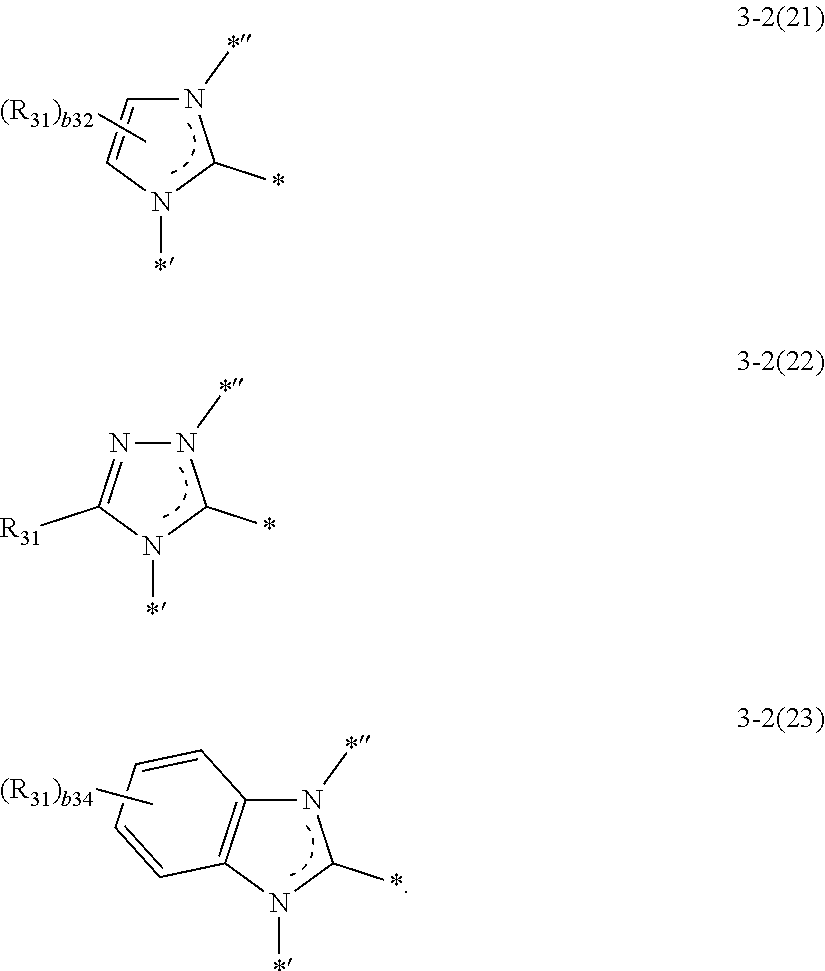







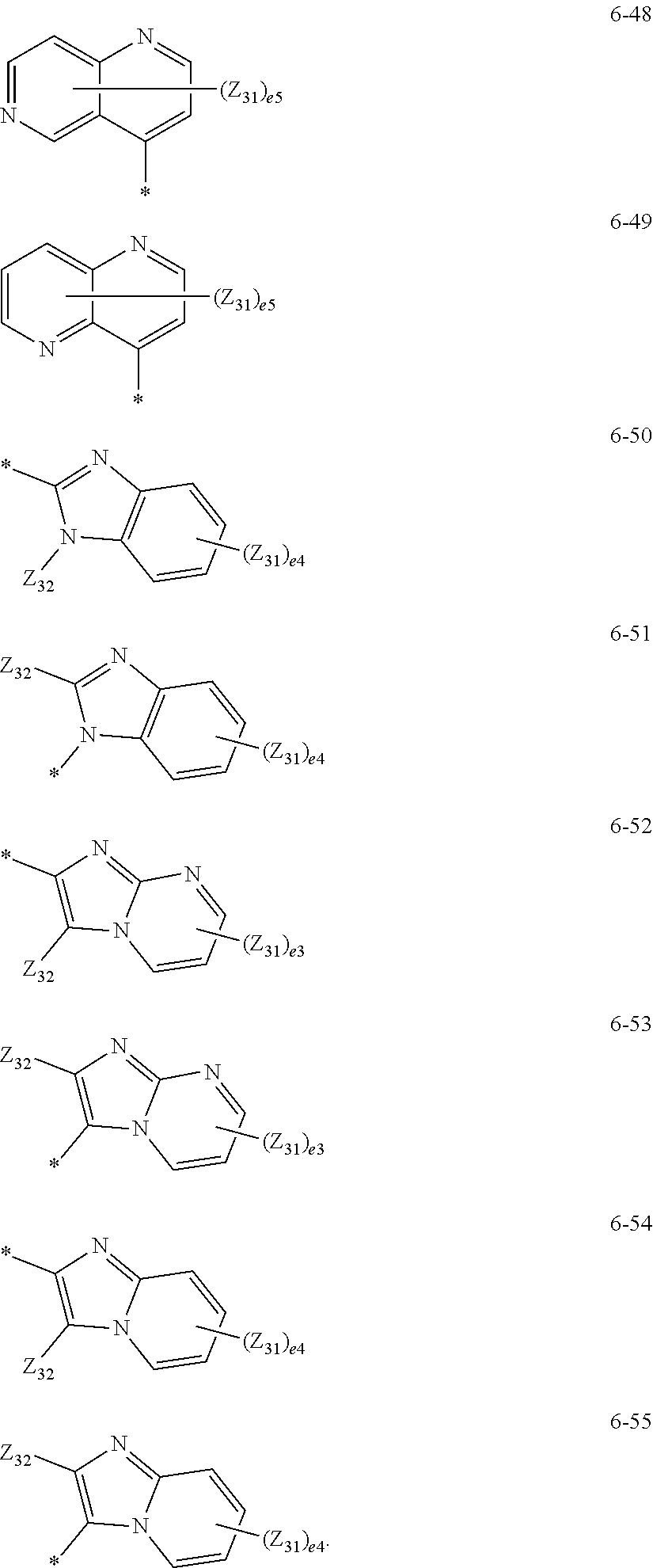



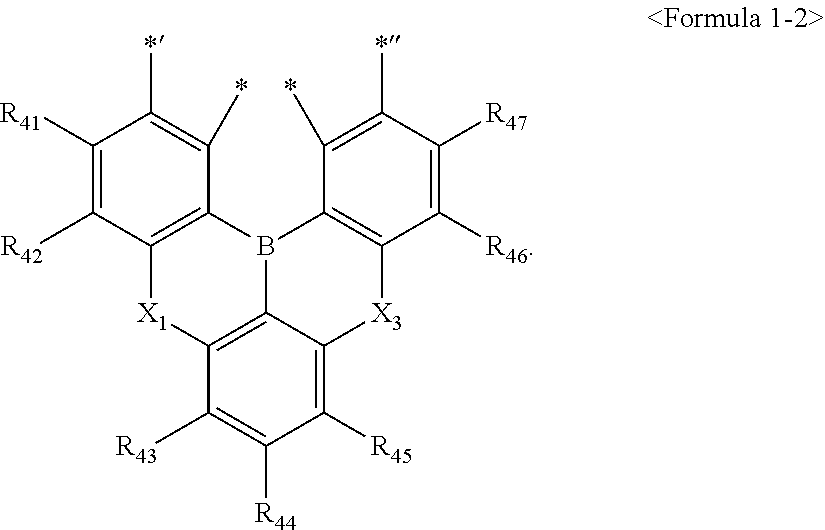






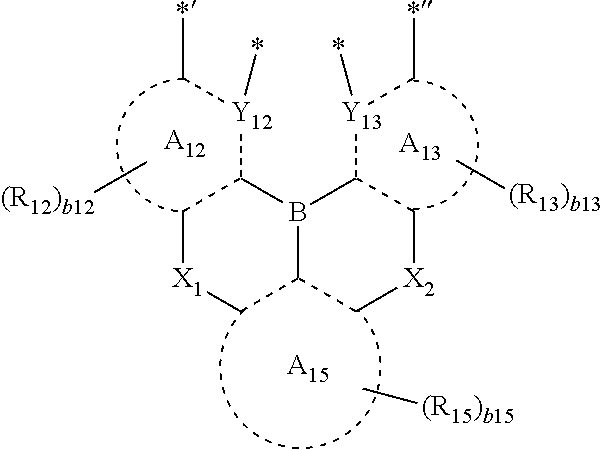



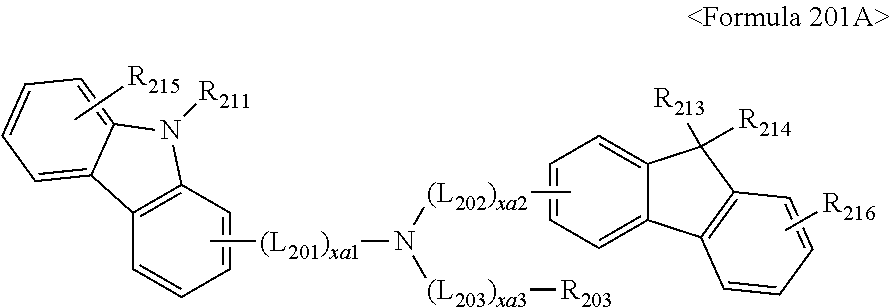







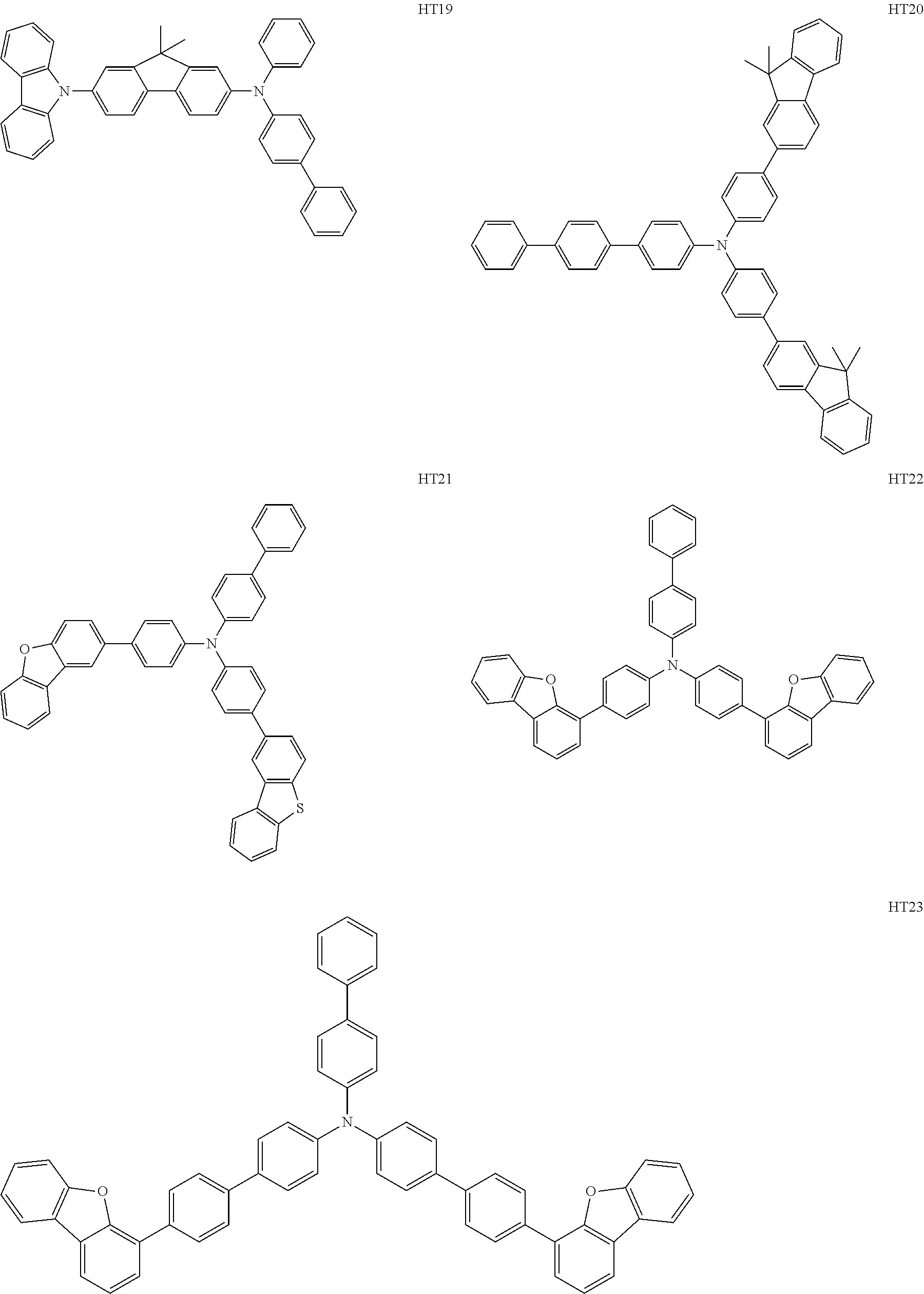


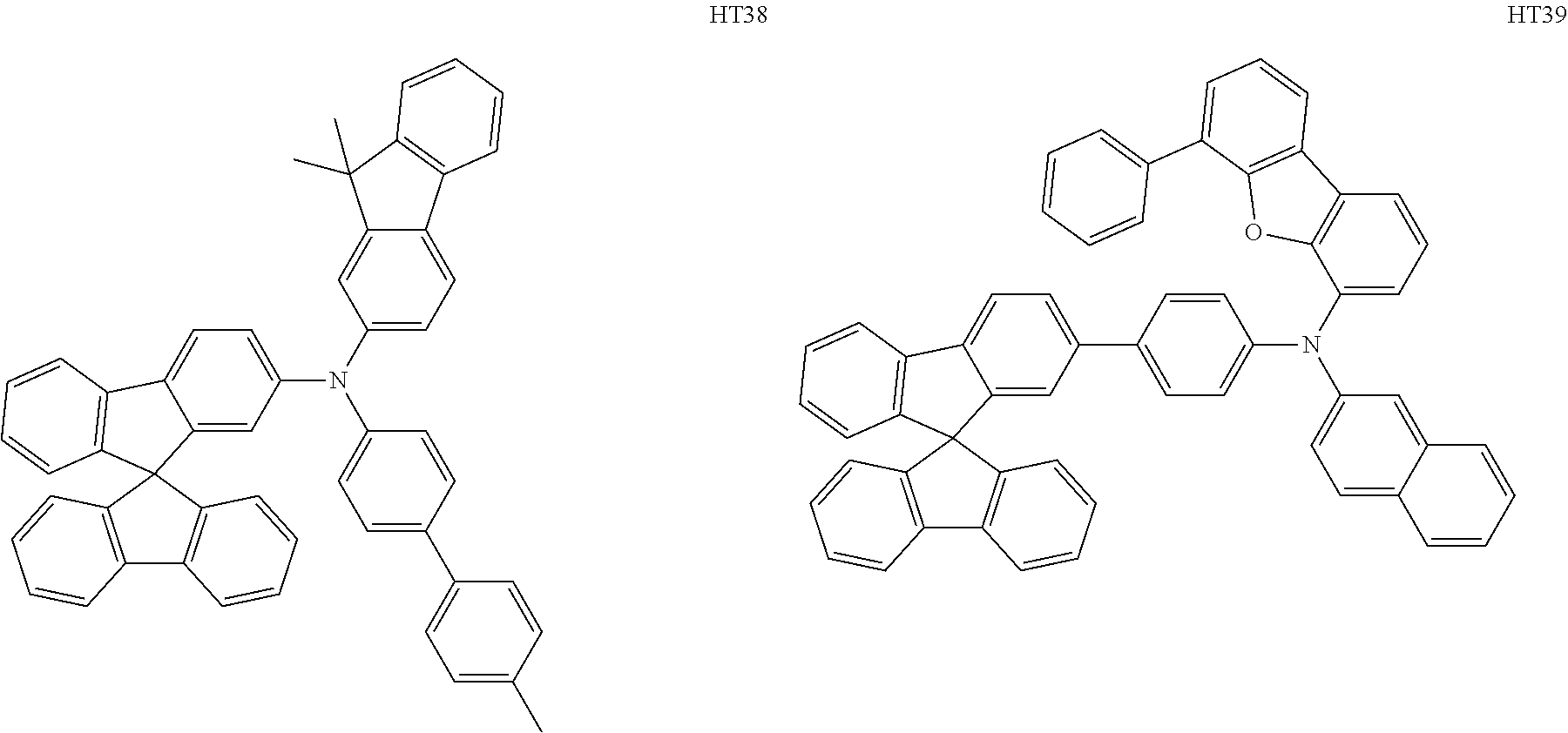
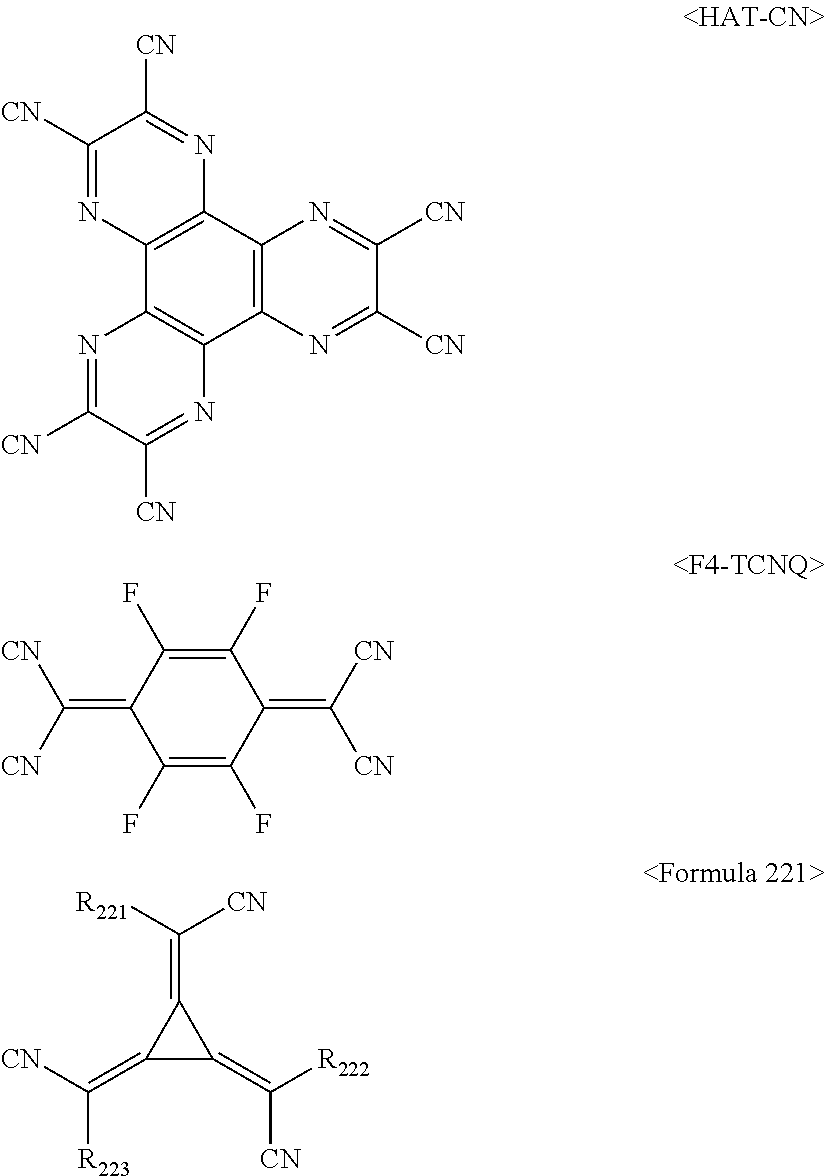





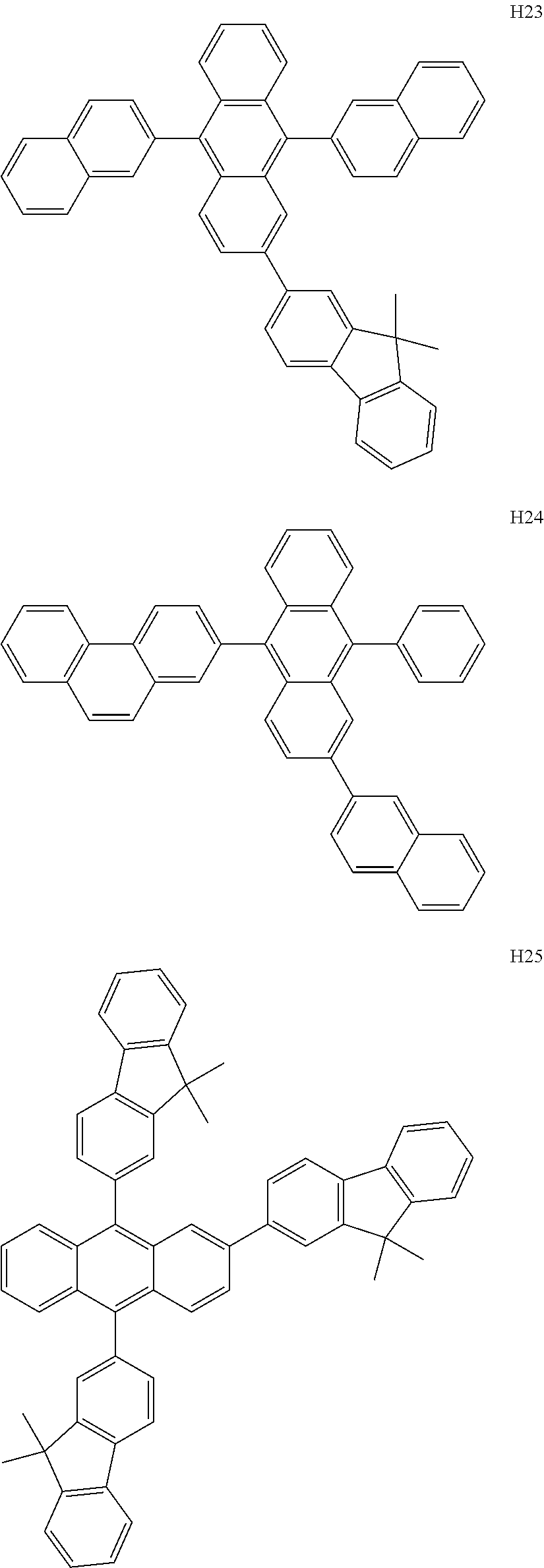





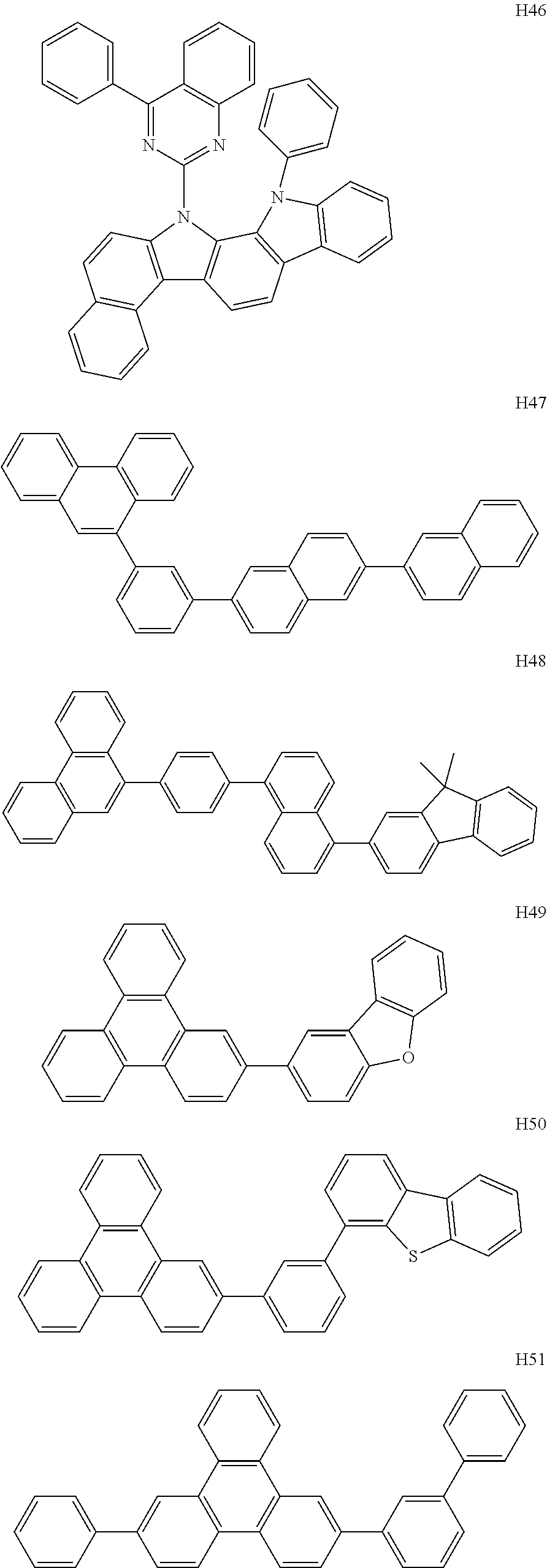
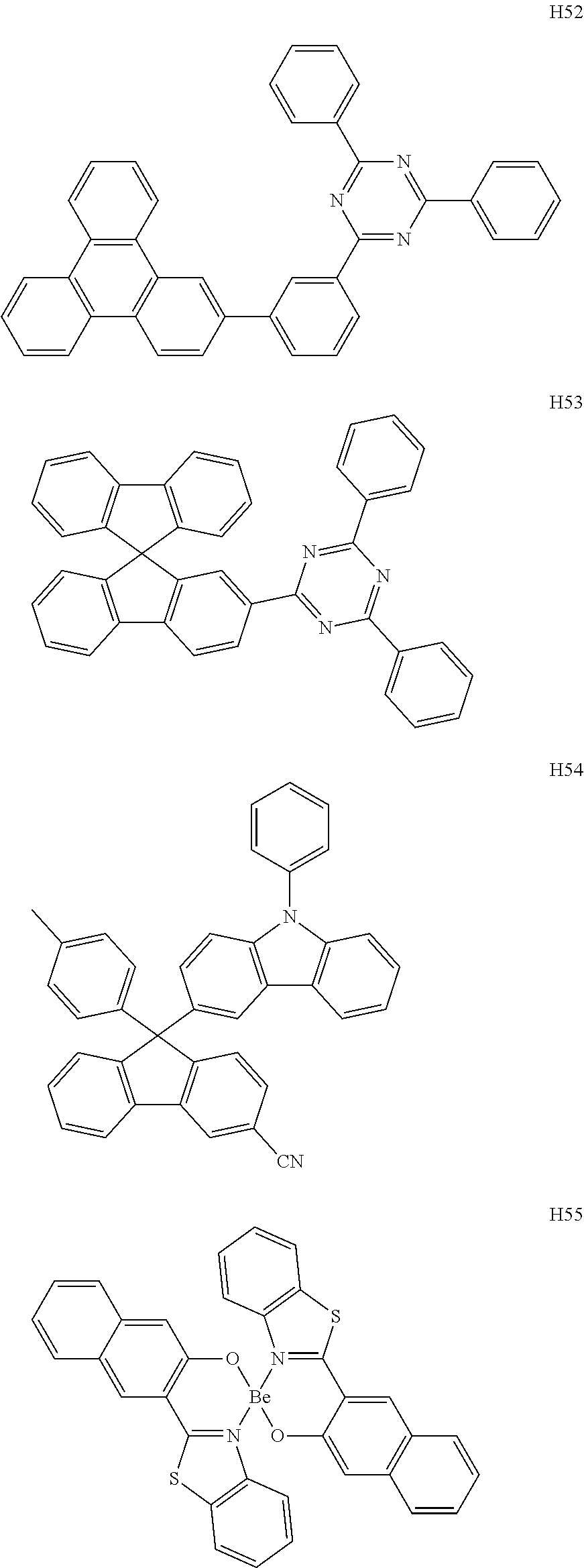





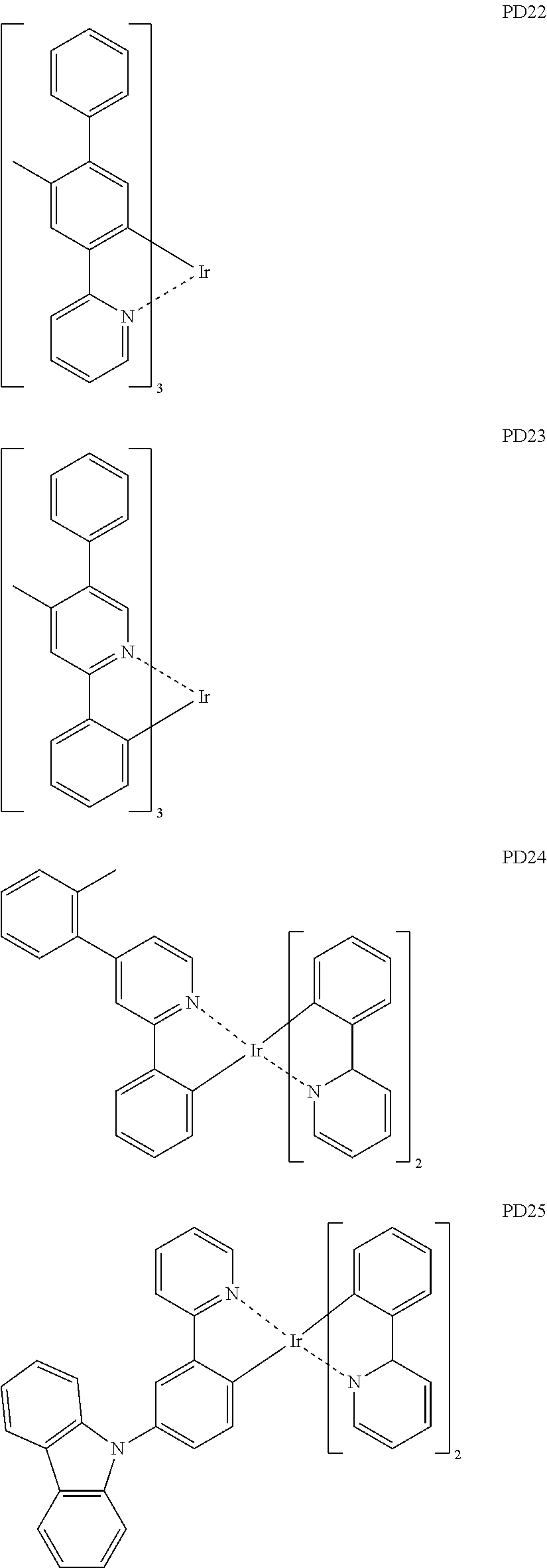


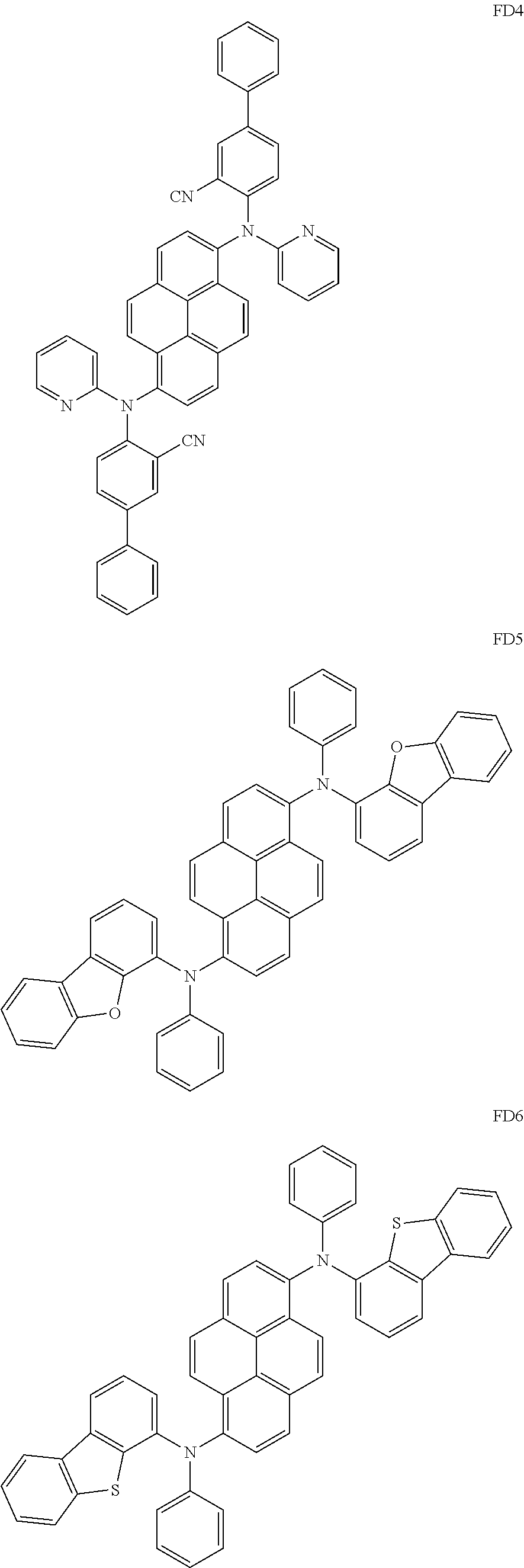

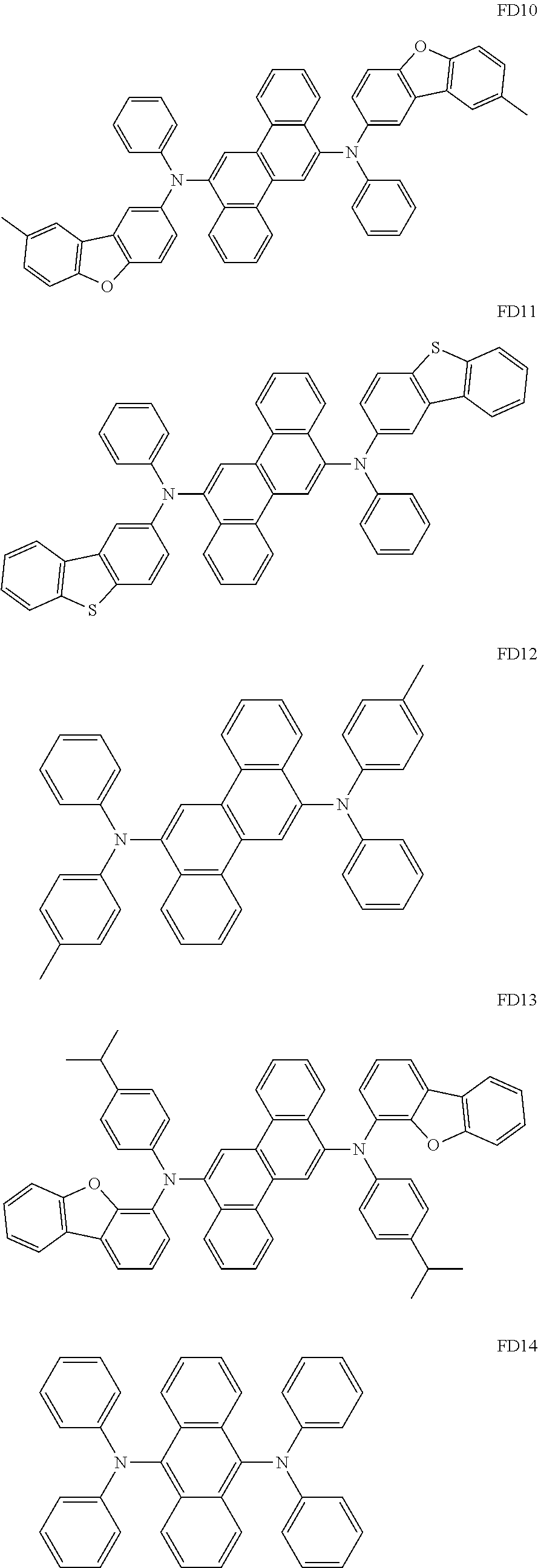
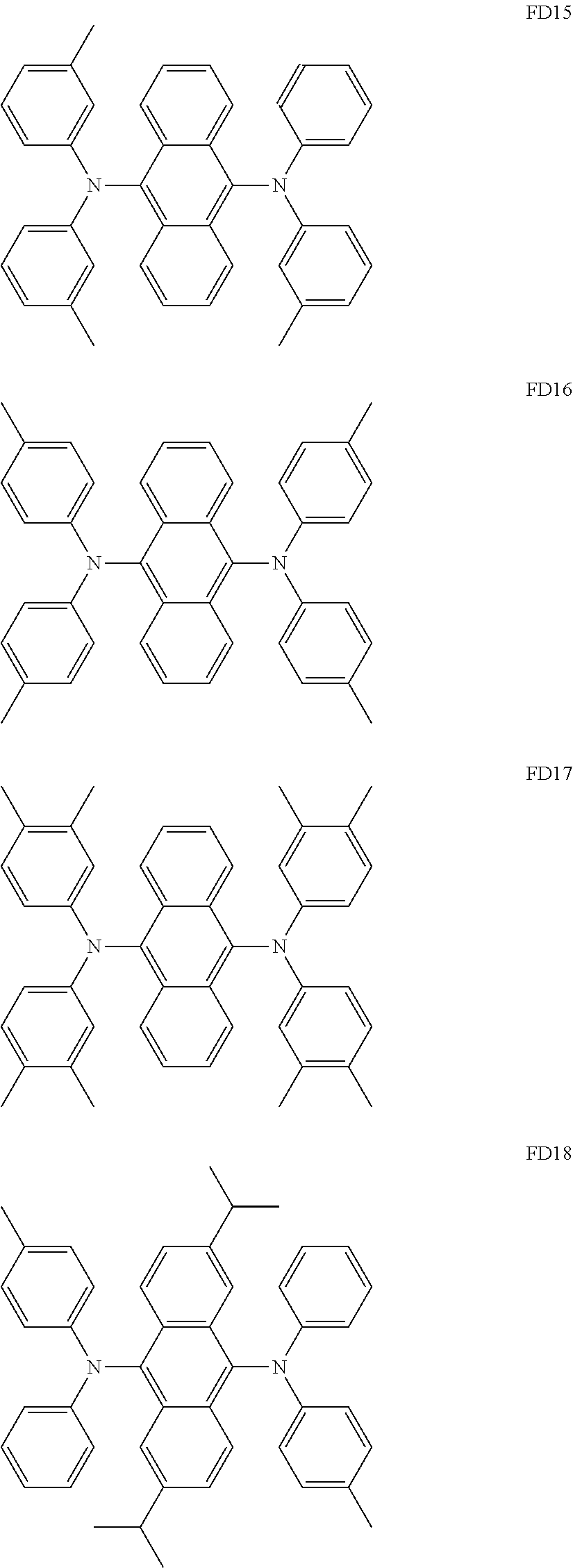
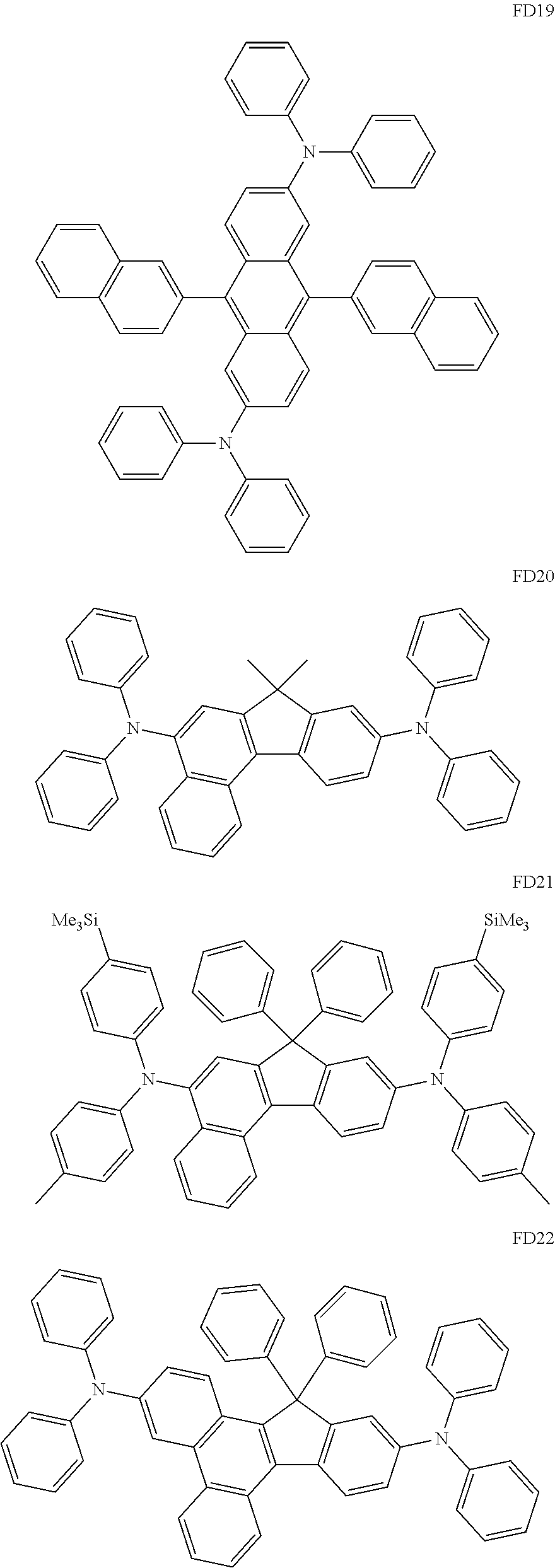

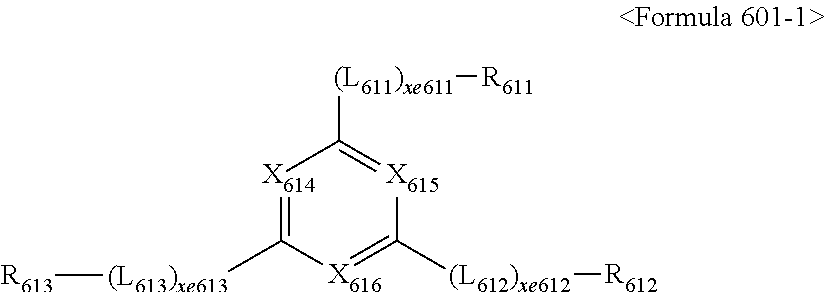




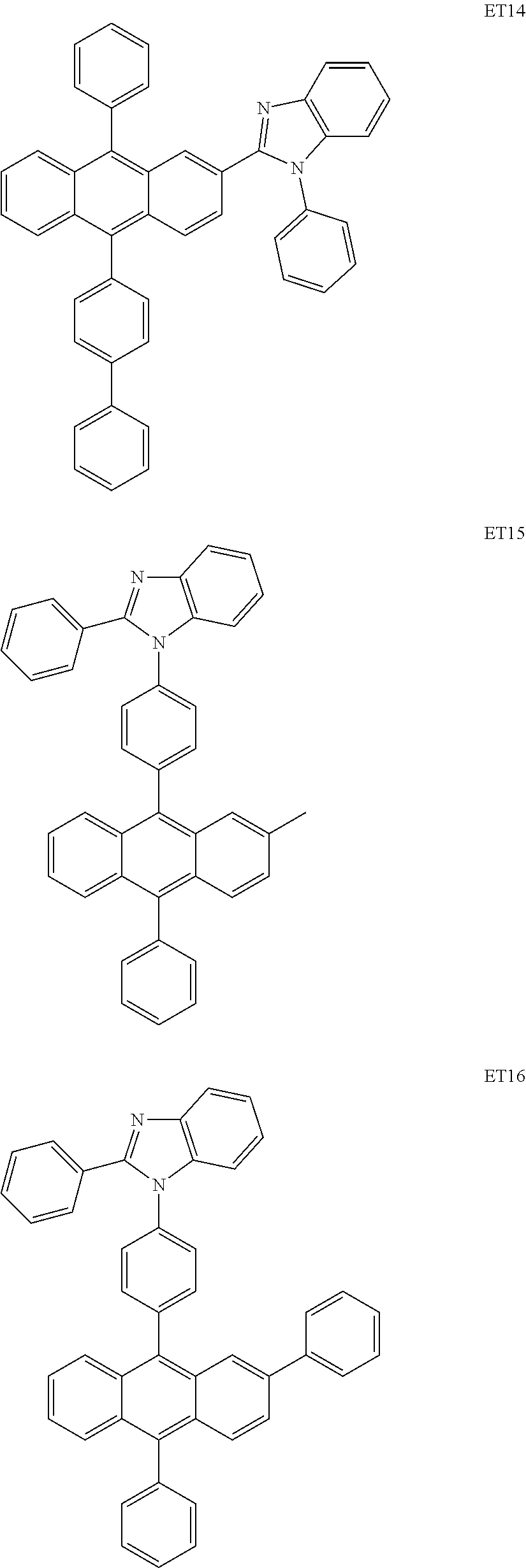




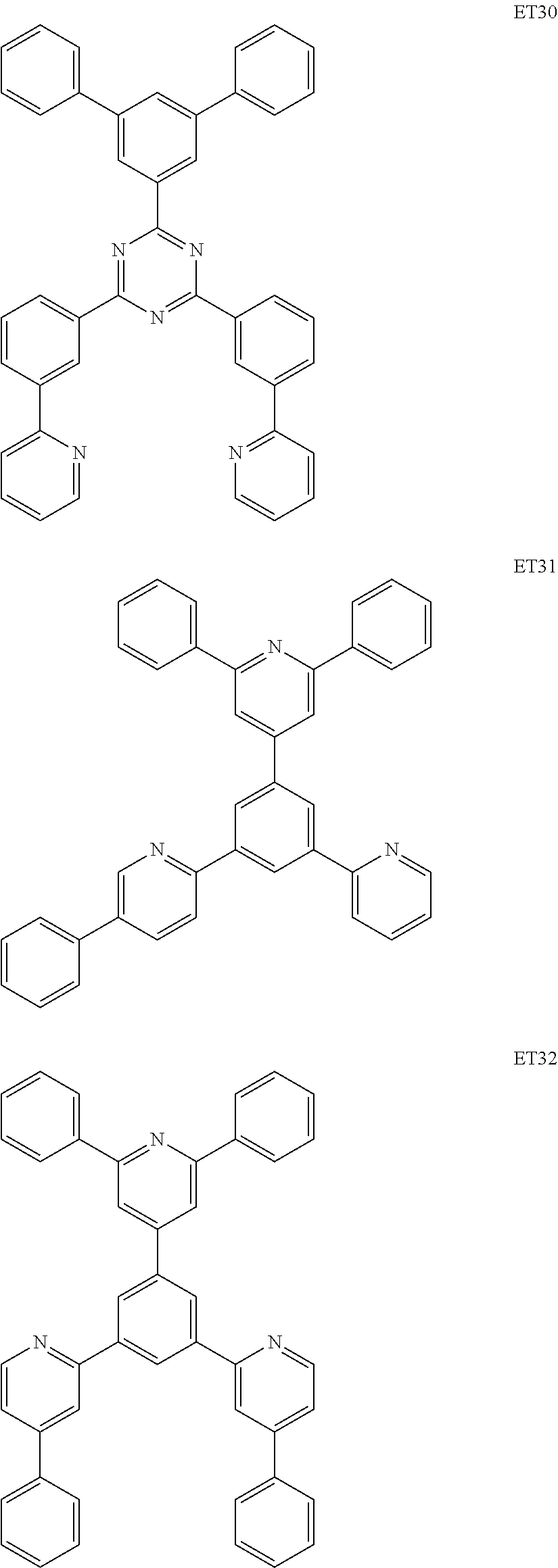

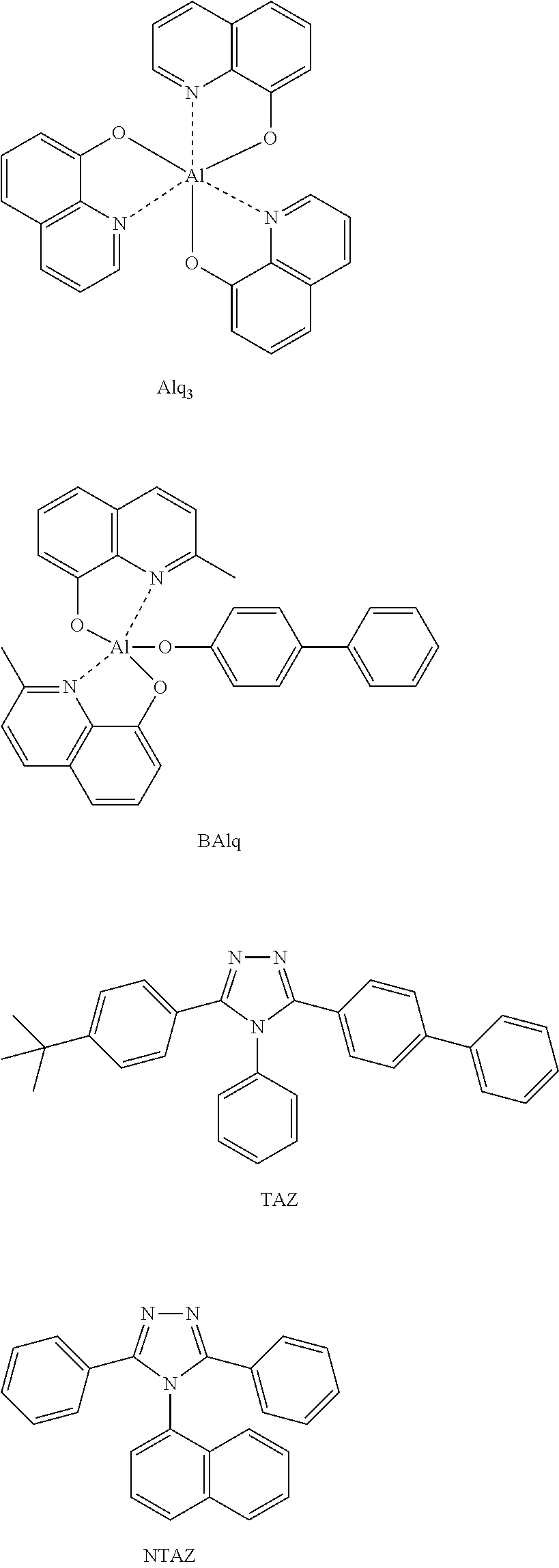




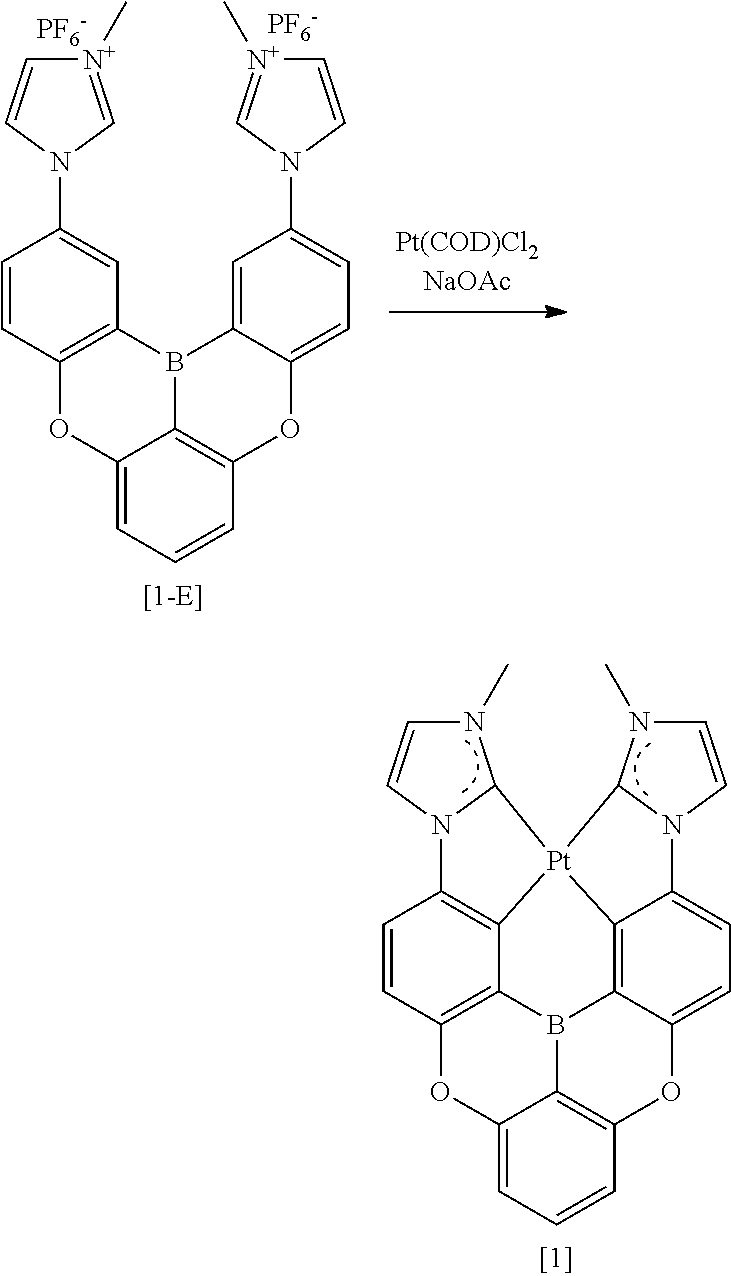



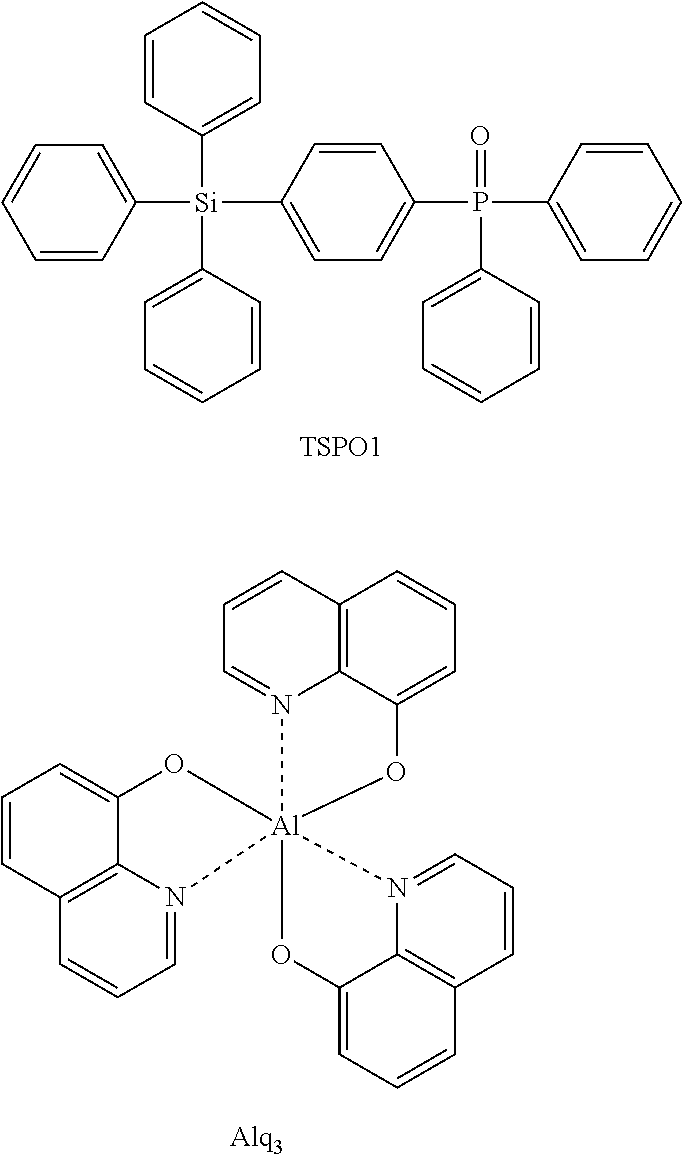


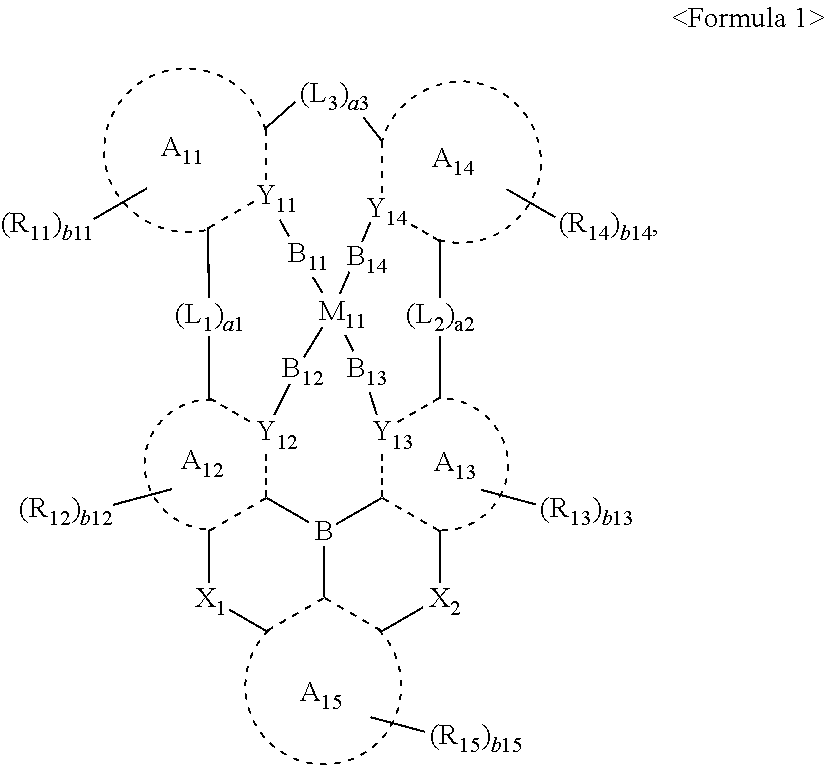






















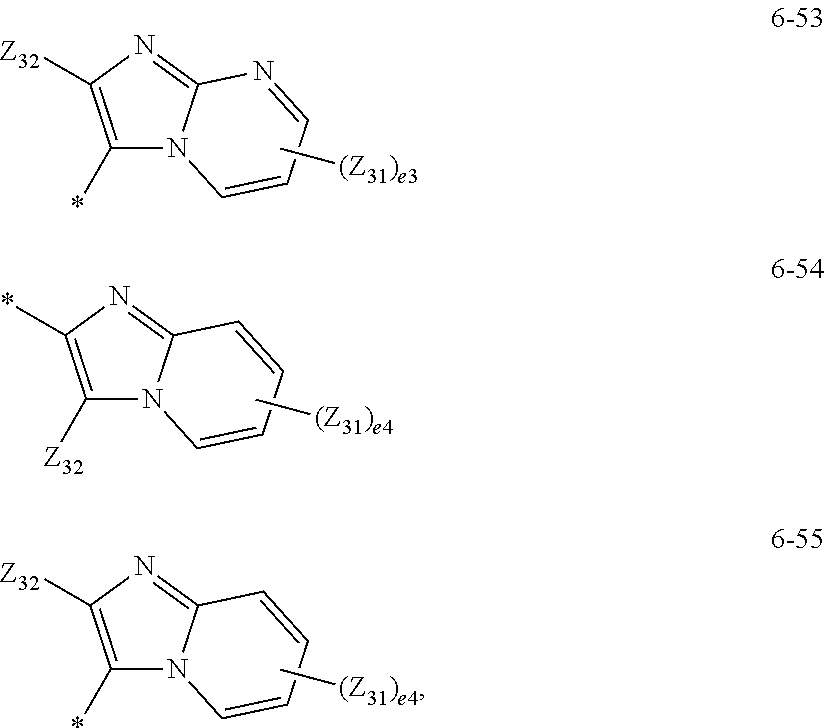

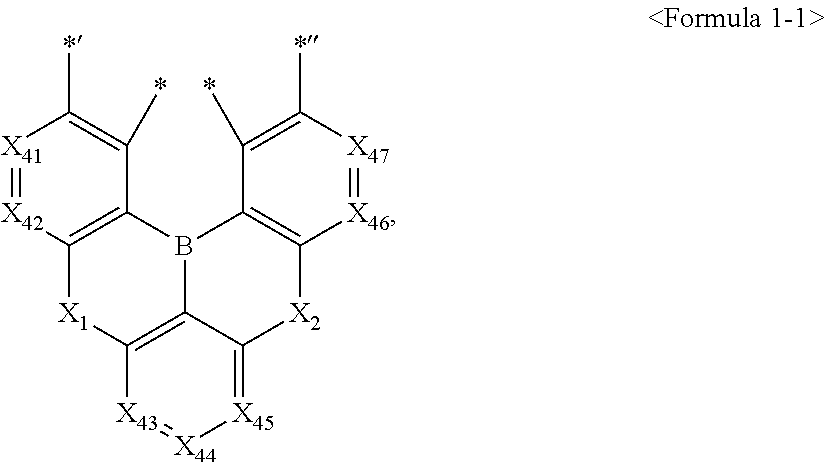


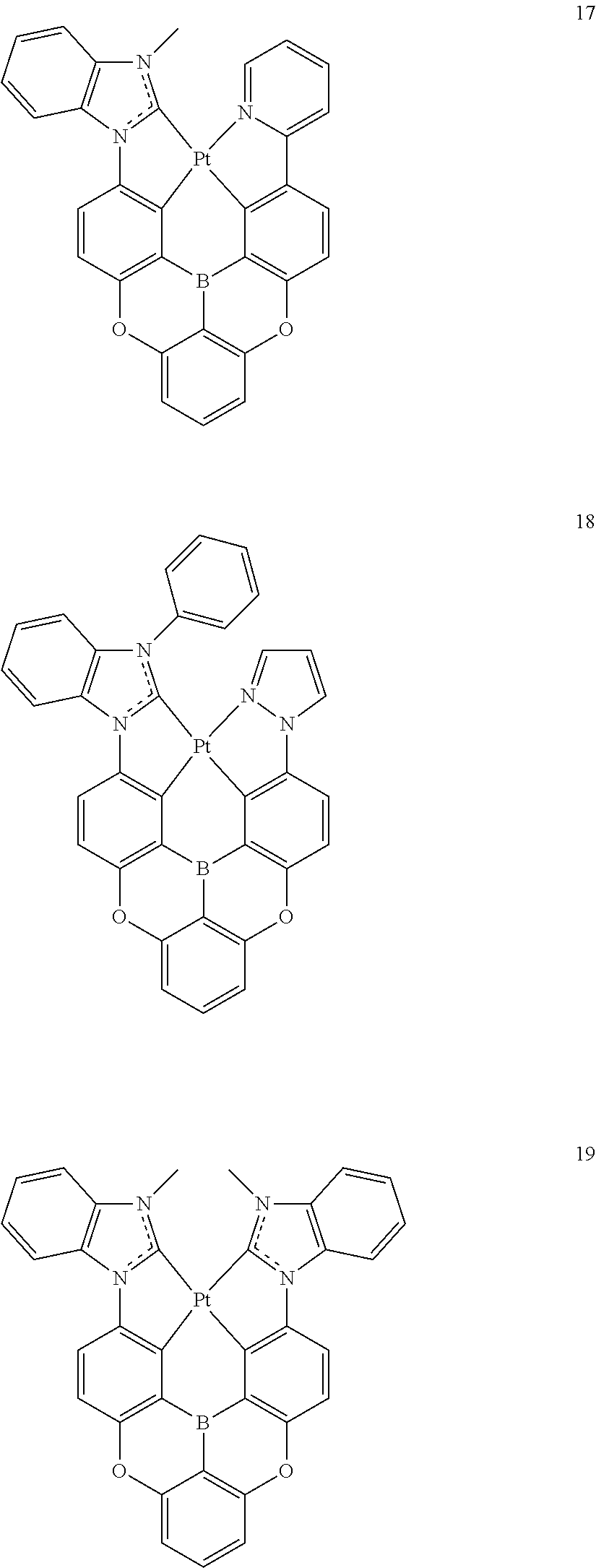


D00000
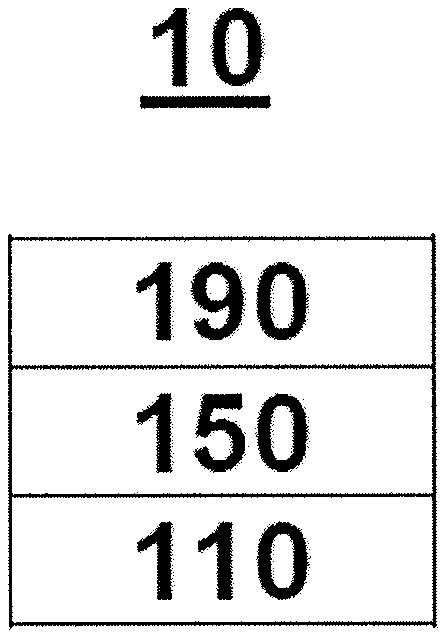
D00001
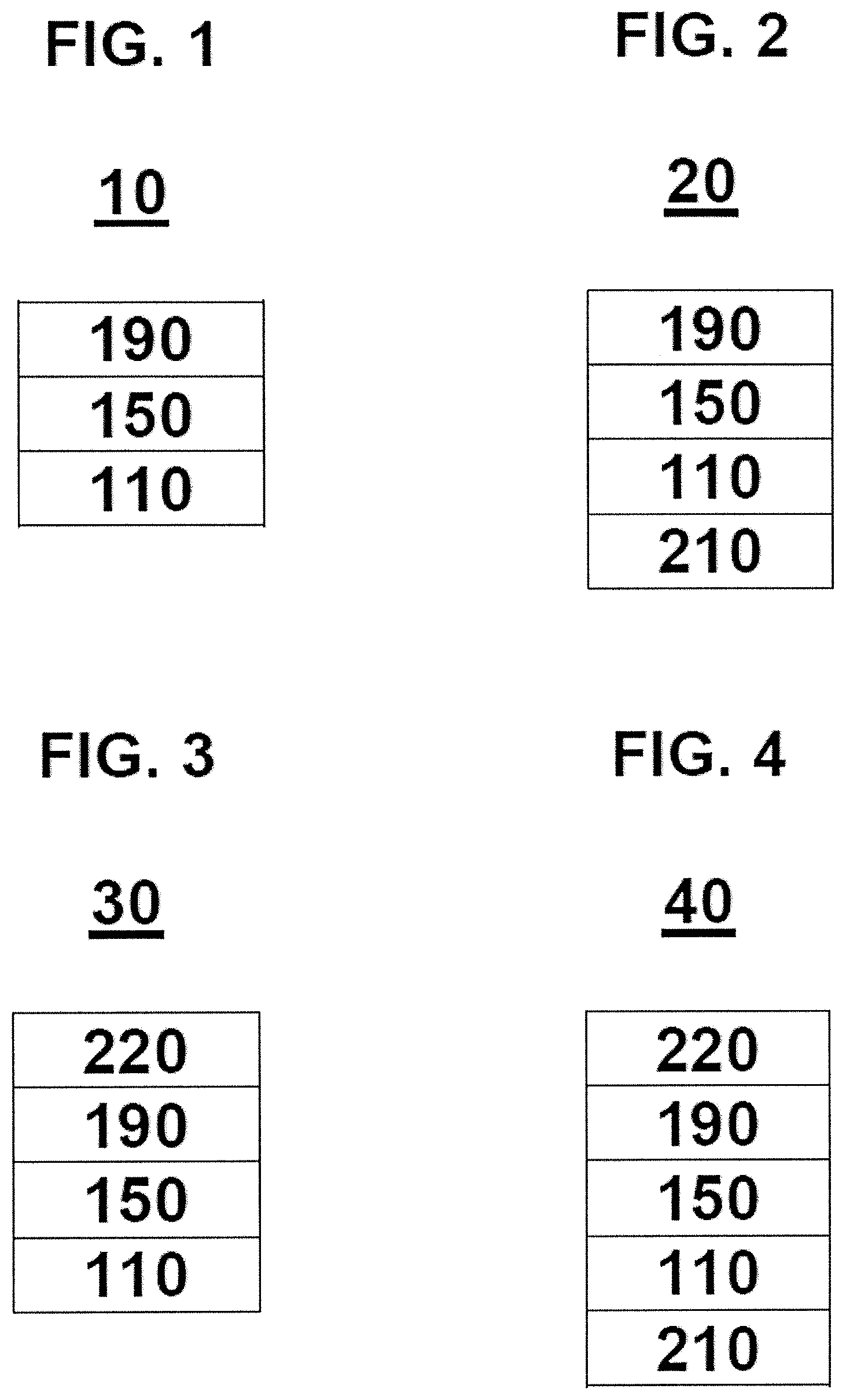
XML
uspto.report is an independent third-party trademark research tool that is not affiliated, endorsed, or sponsored by the United States Patent and Trademark Office (USPTO) or any other governmental organization. The information provided by uspto.report is based on publicly available data at the time of writing and is intended for informational purposes only.
While we strive to provide accurate and up-to-date information, we do not guarantee the accuracy, completeness, reliability, or suitability of the information displayed on this site. The use of this site is at your own risk. Any reliance you place on such information is therefore strictly at your own risk.
All official trademark data, including owner information, should be verified by visiting the official USPTO website at www.uspto.gov. This site is not intended to replace professional legal advice and should not be used as a substitute for consulting with a legal professional who is knowledgeable about trademark law.